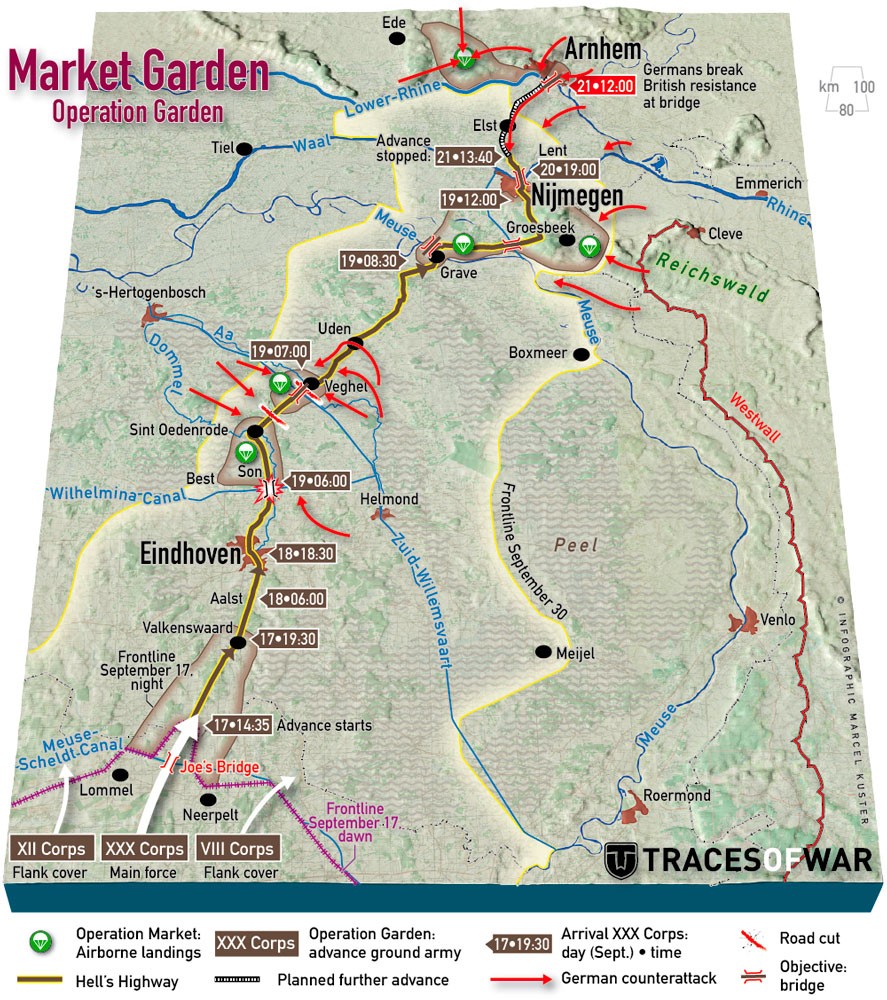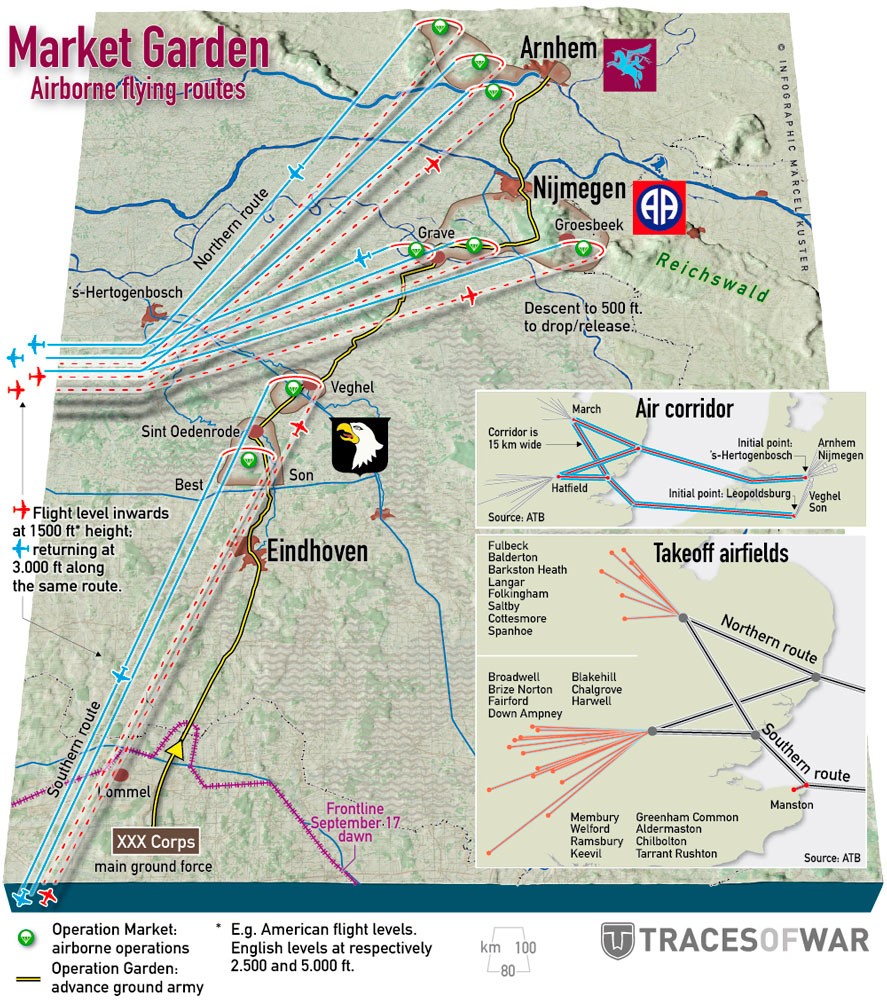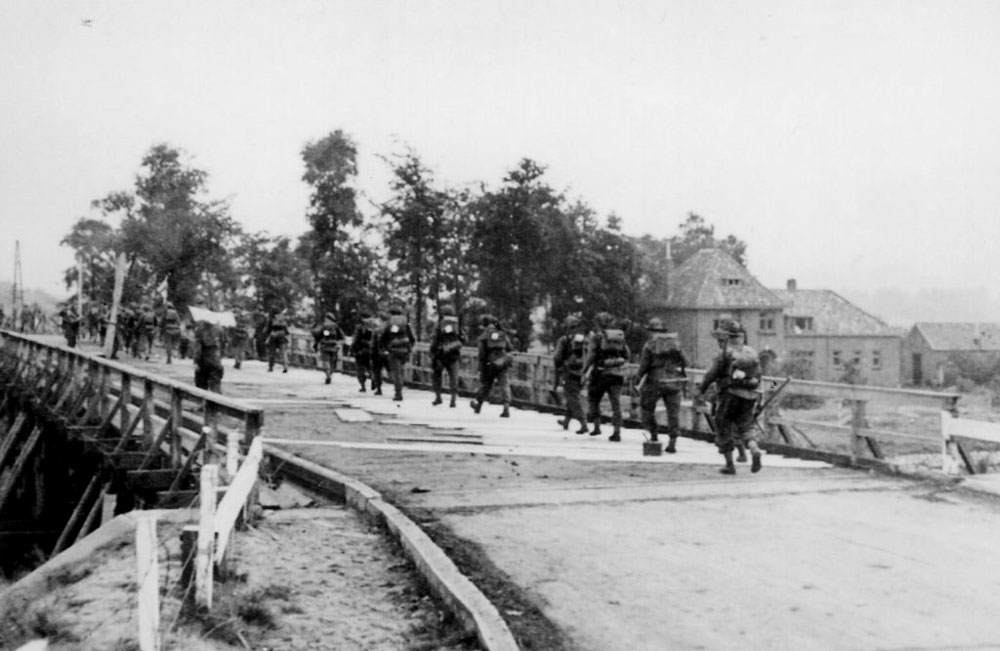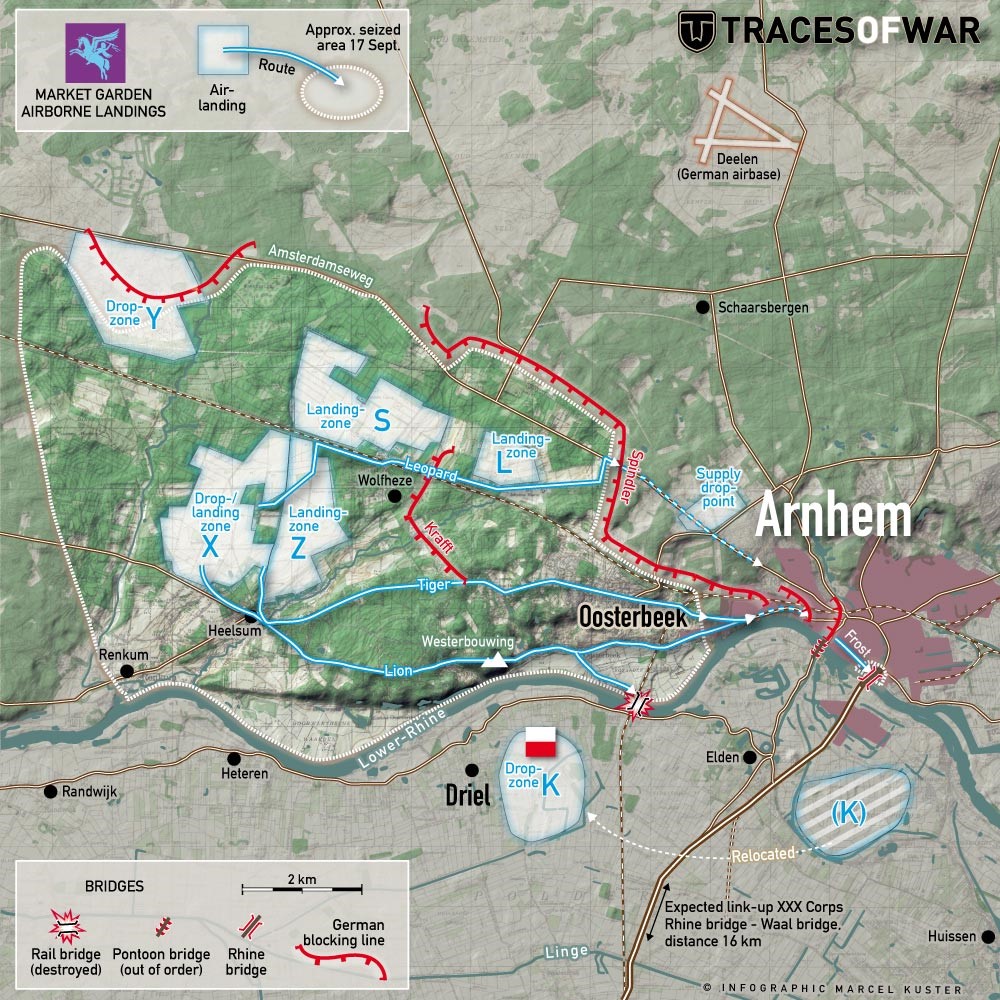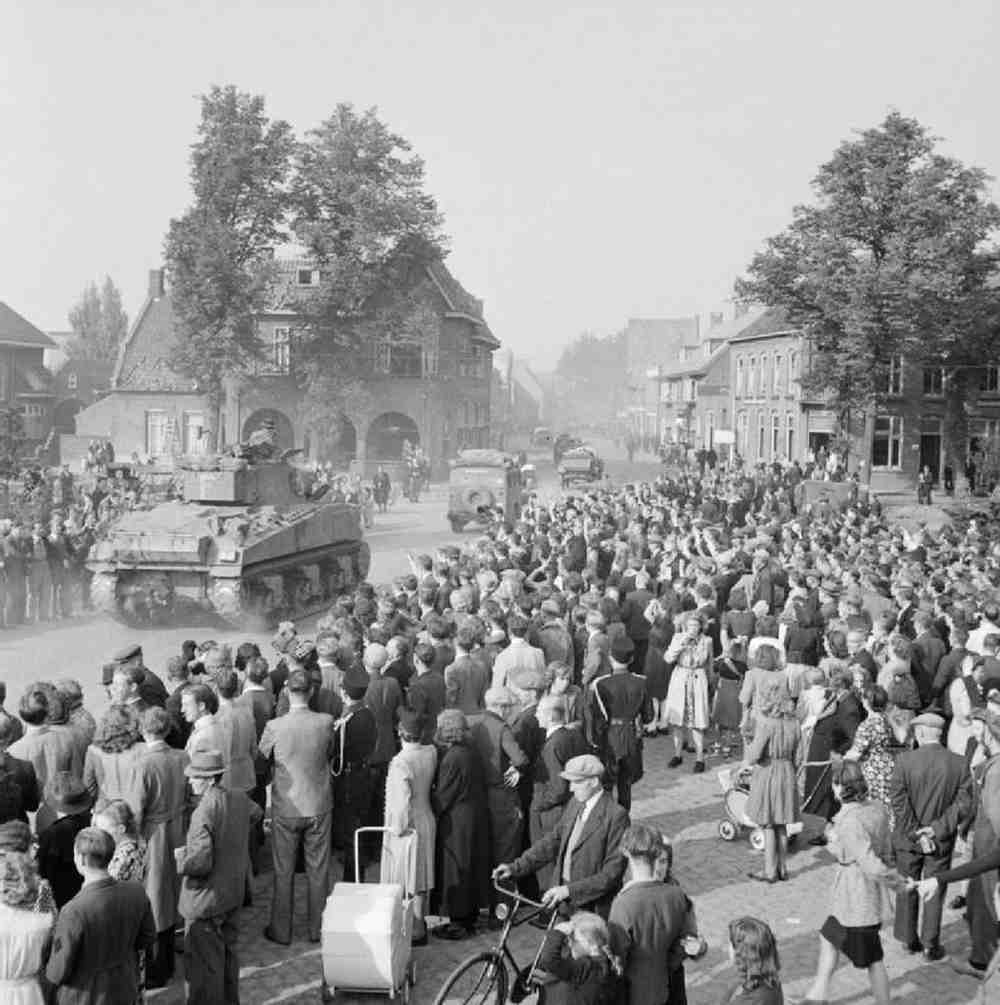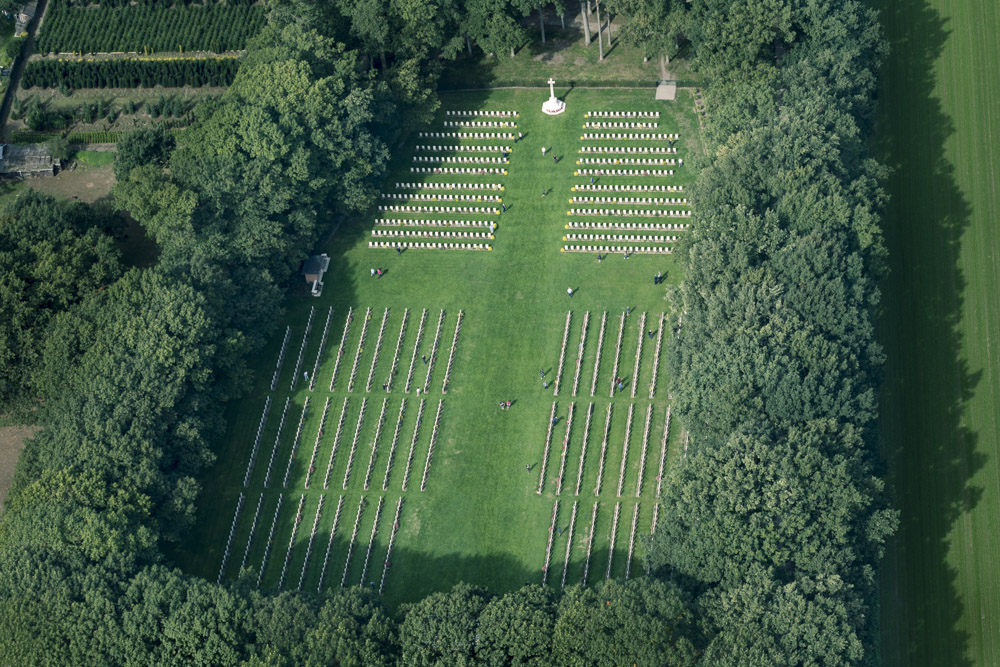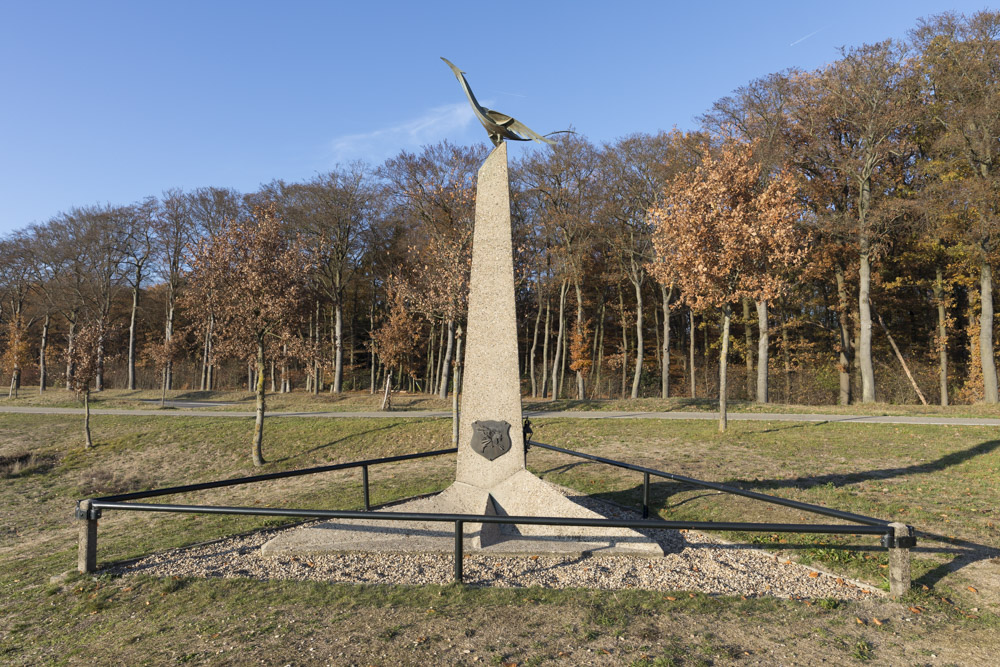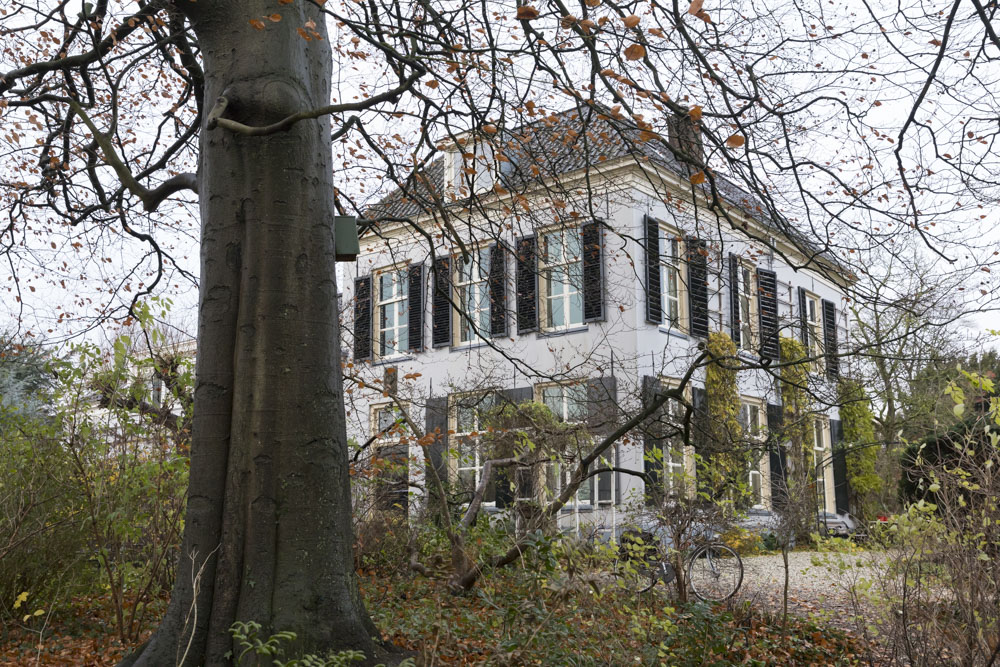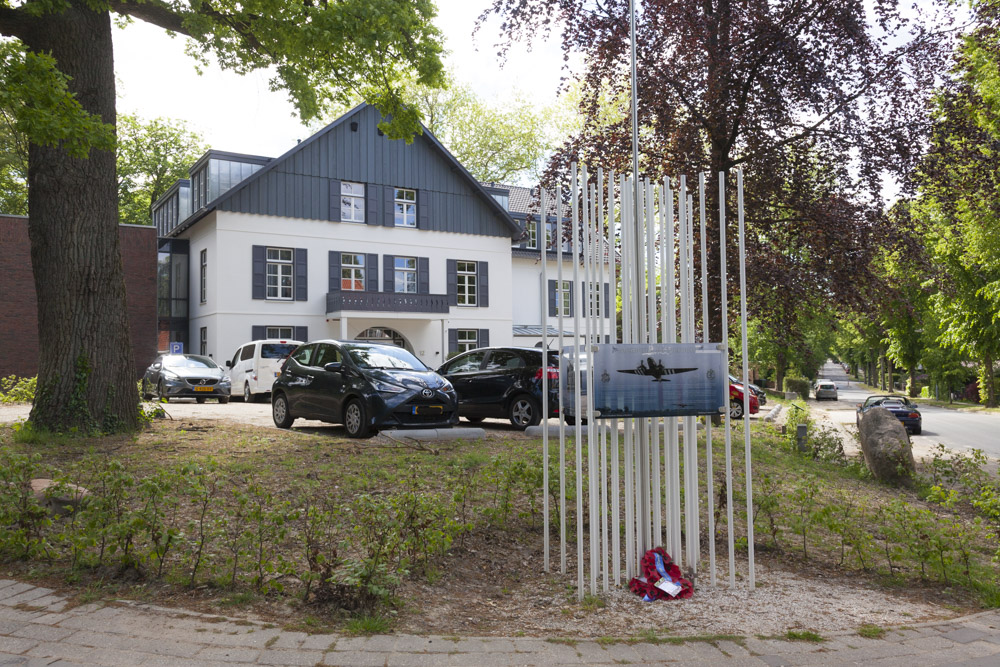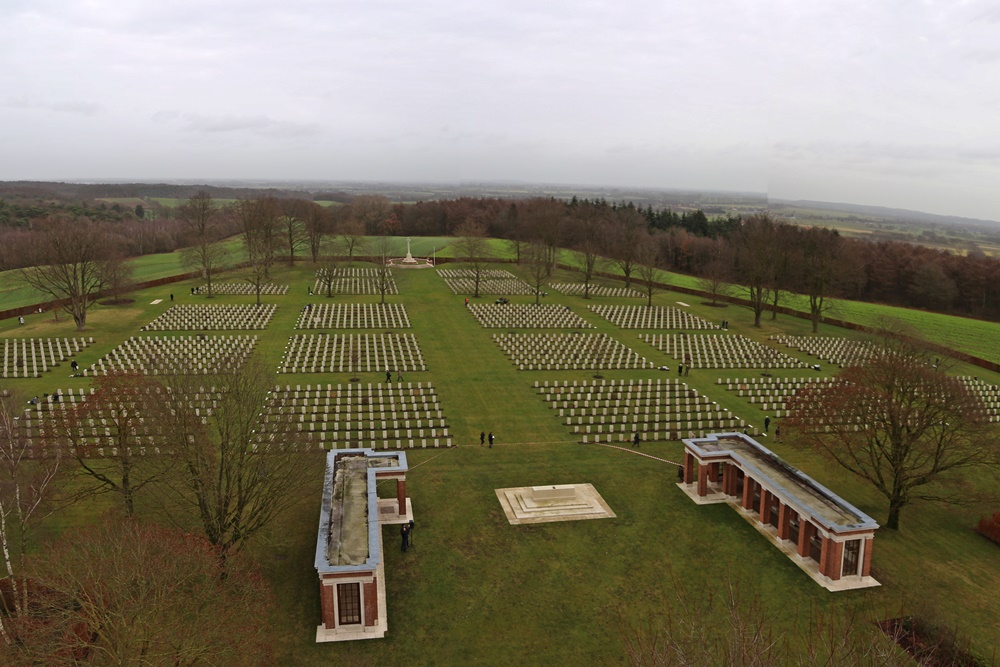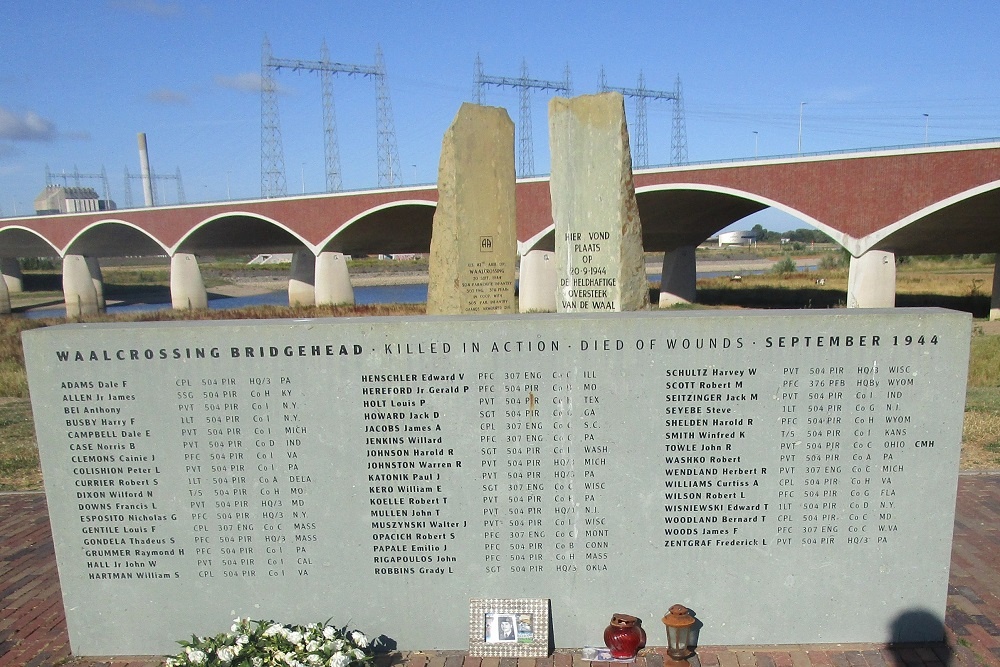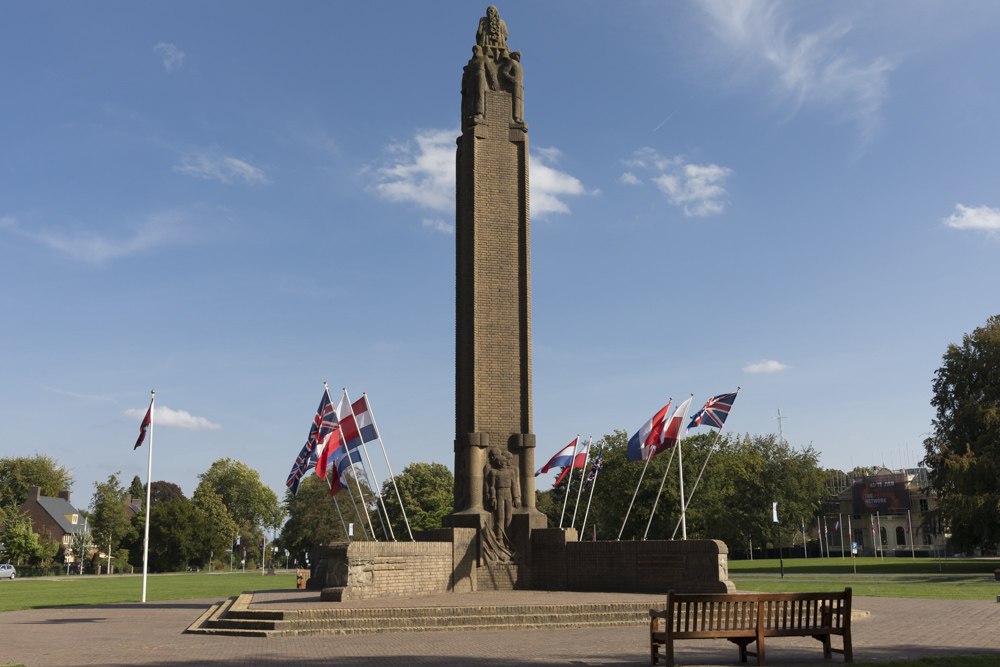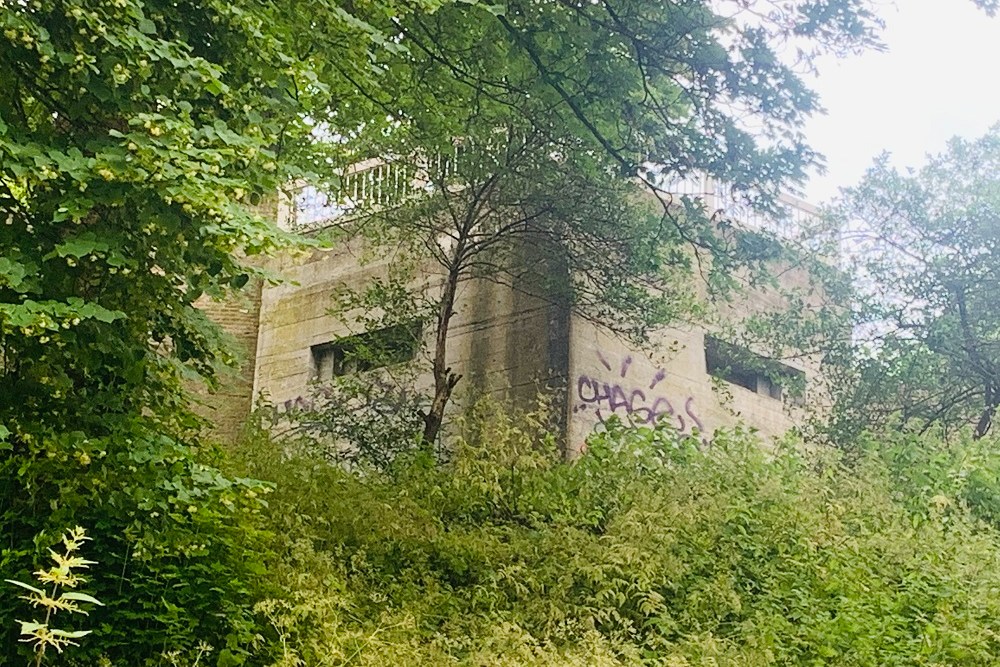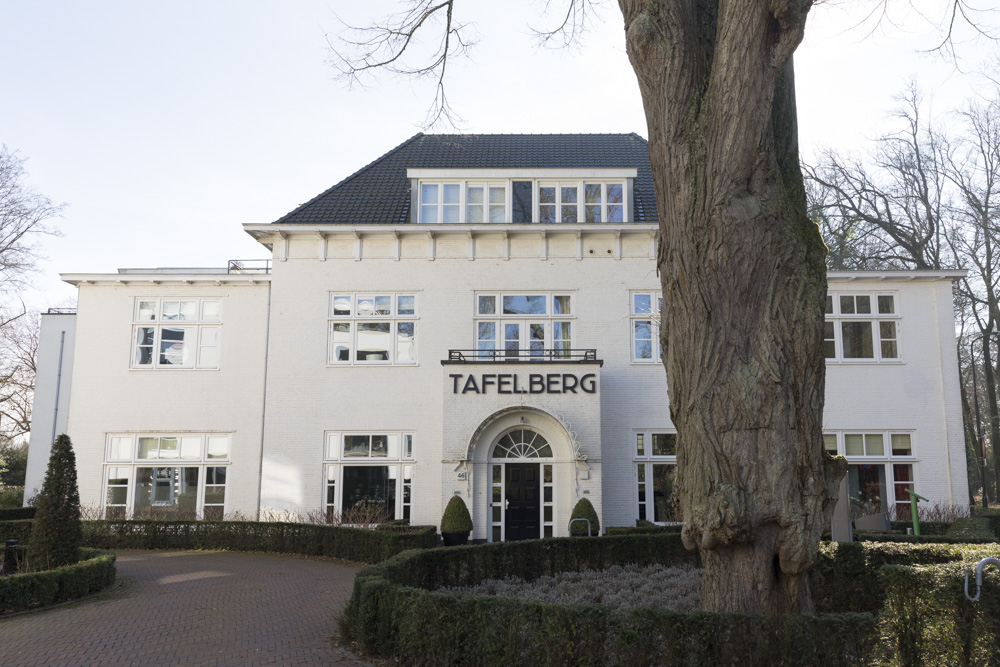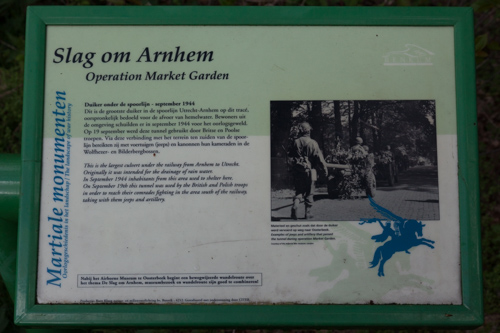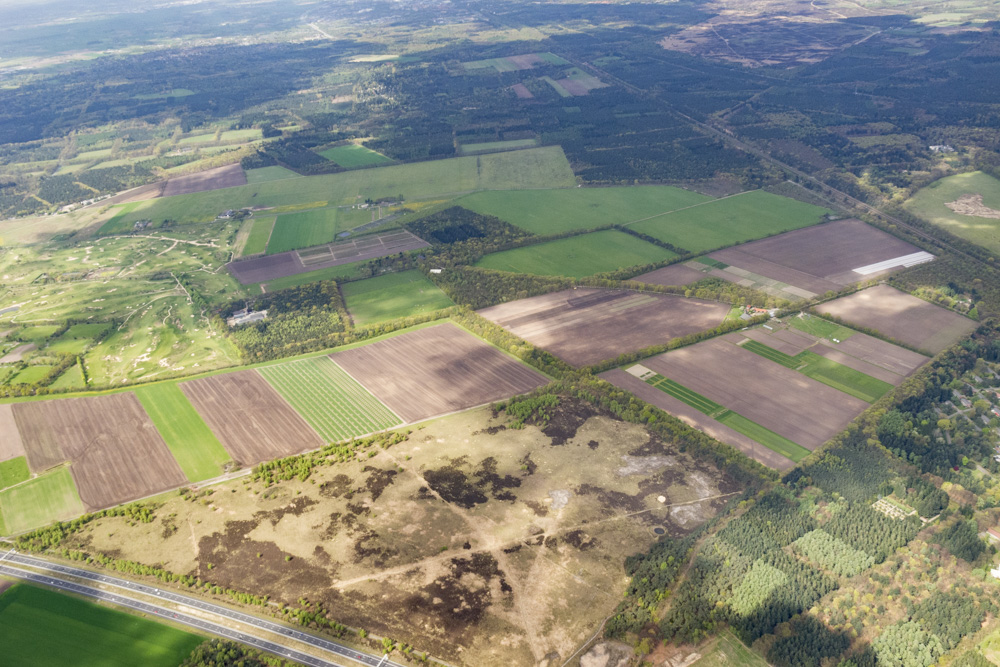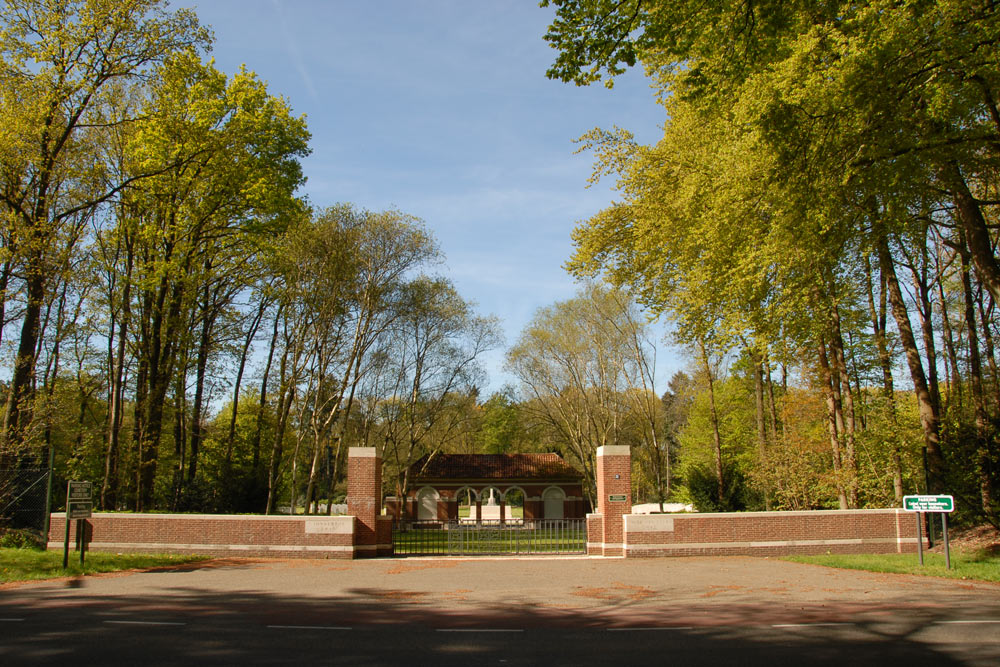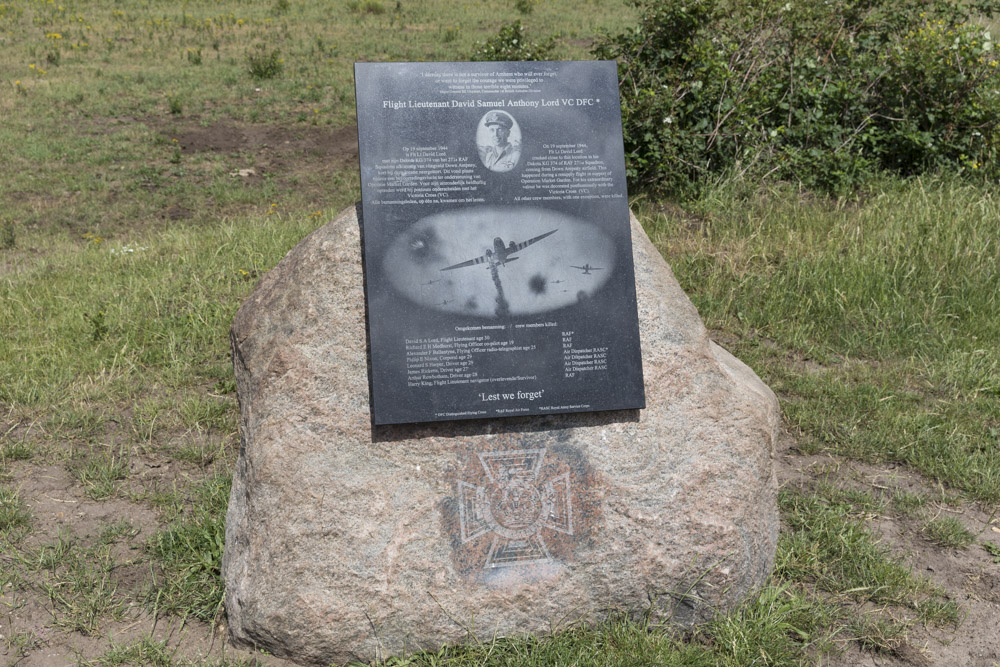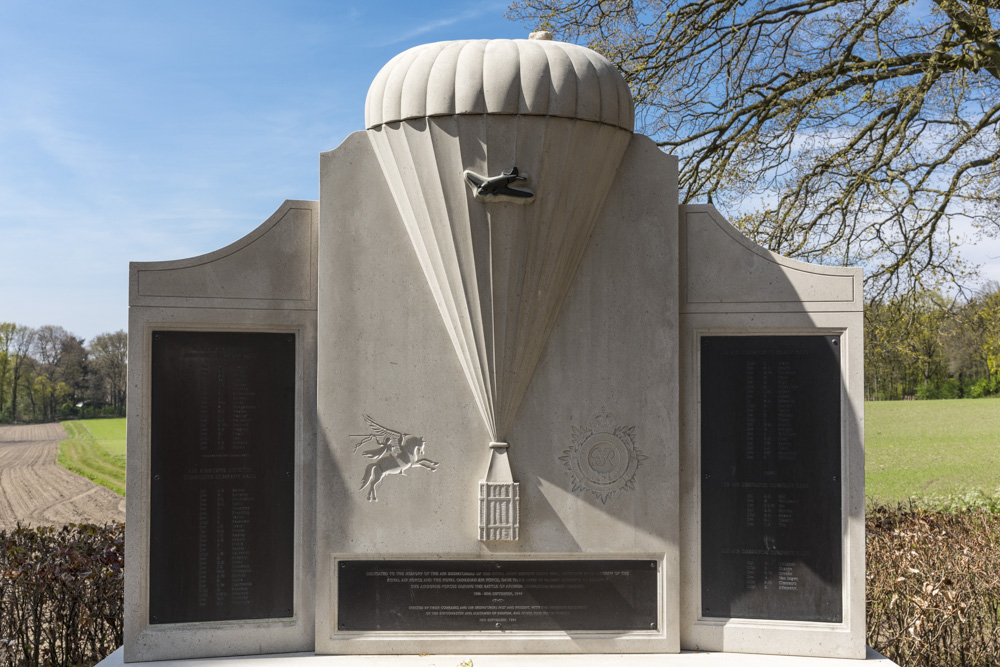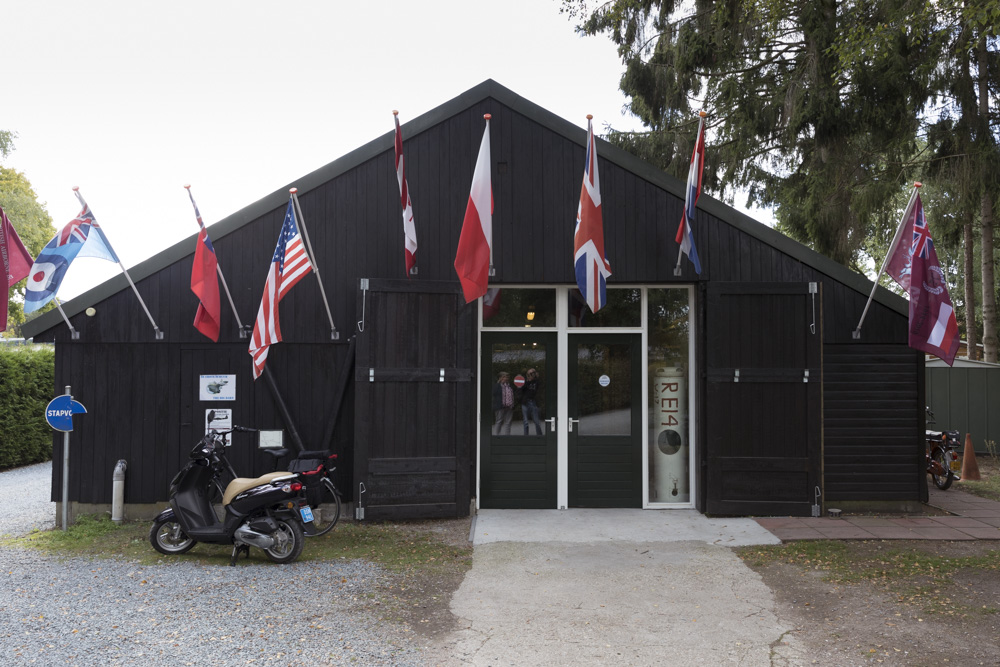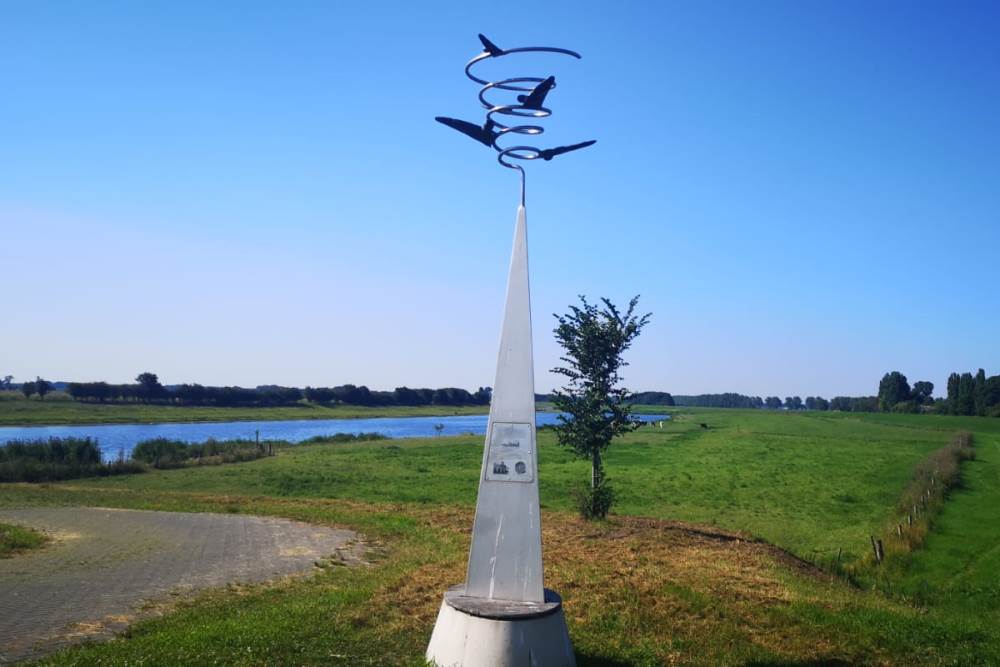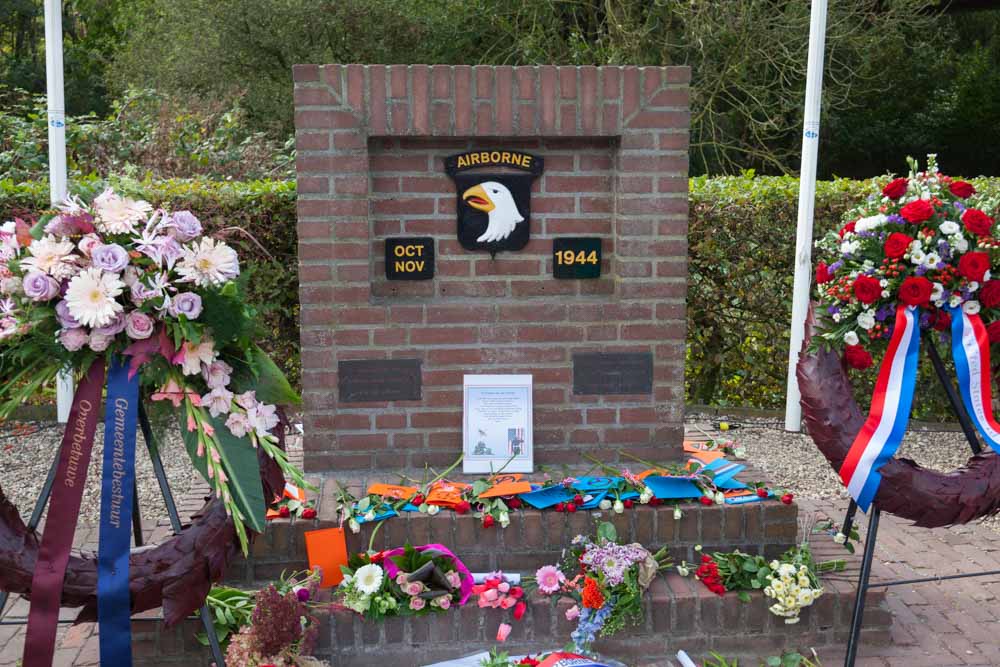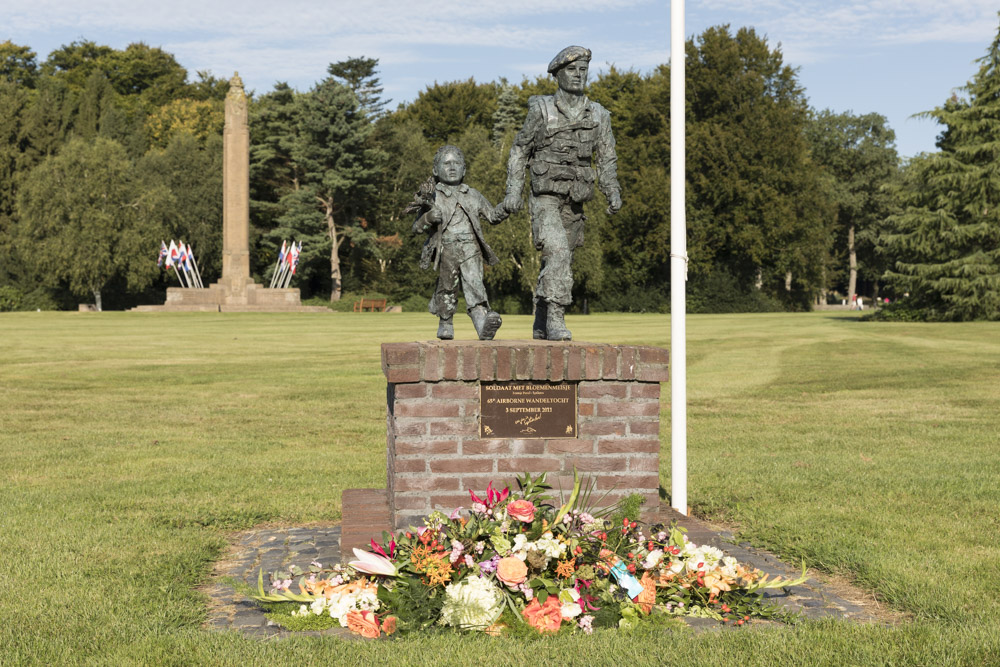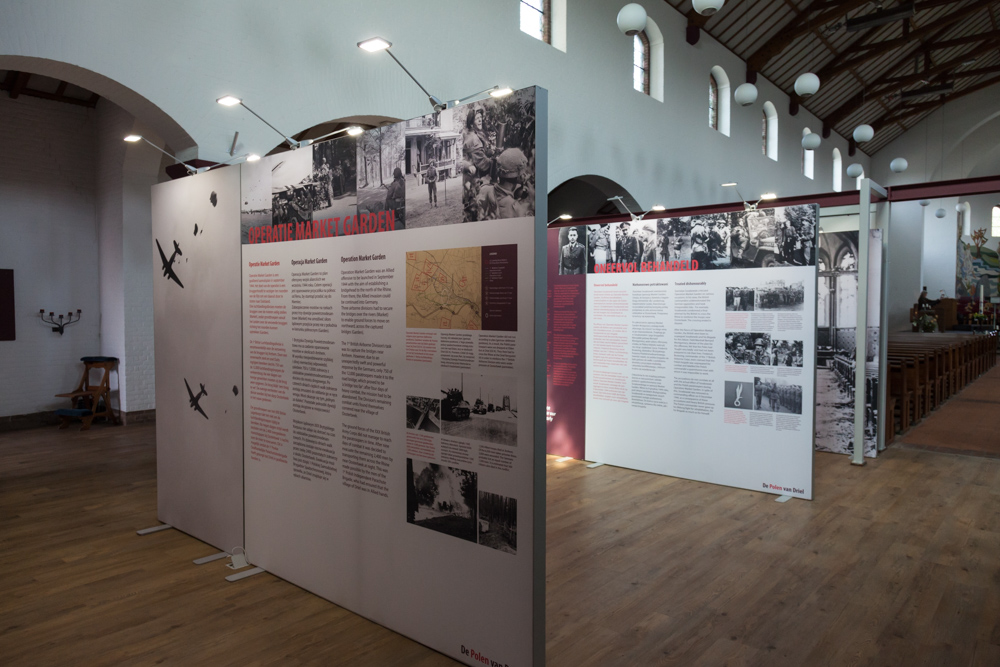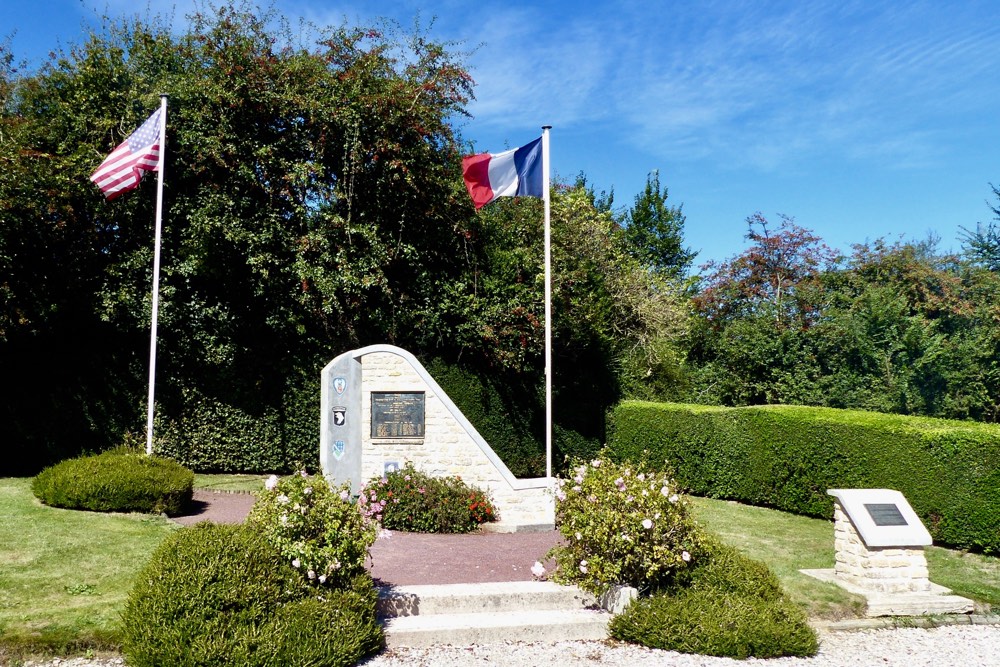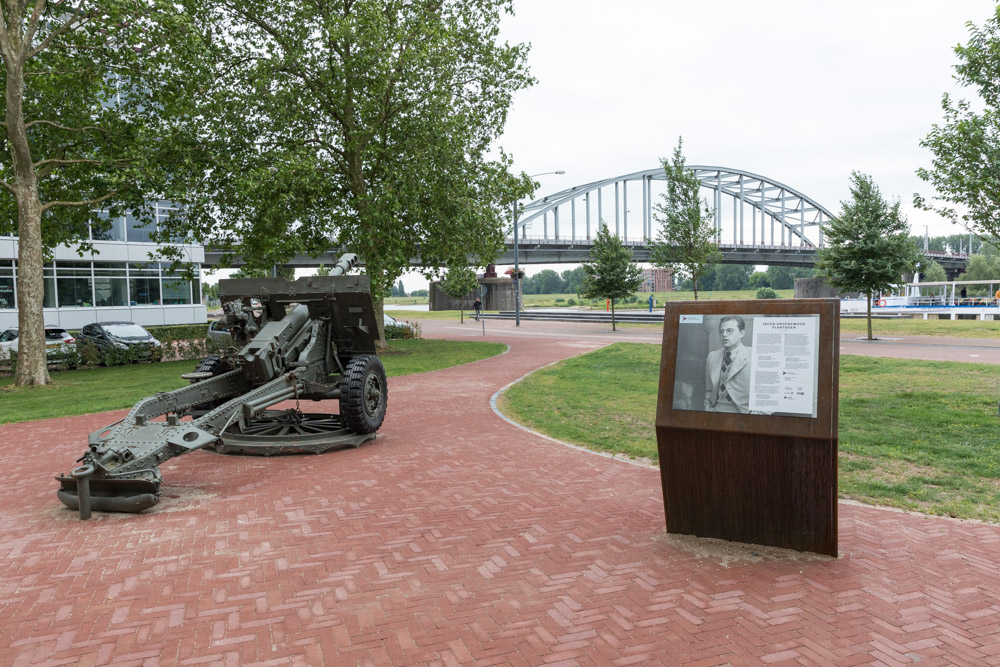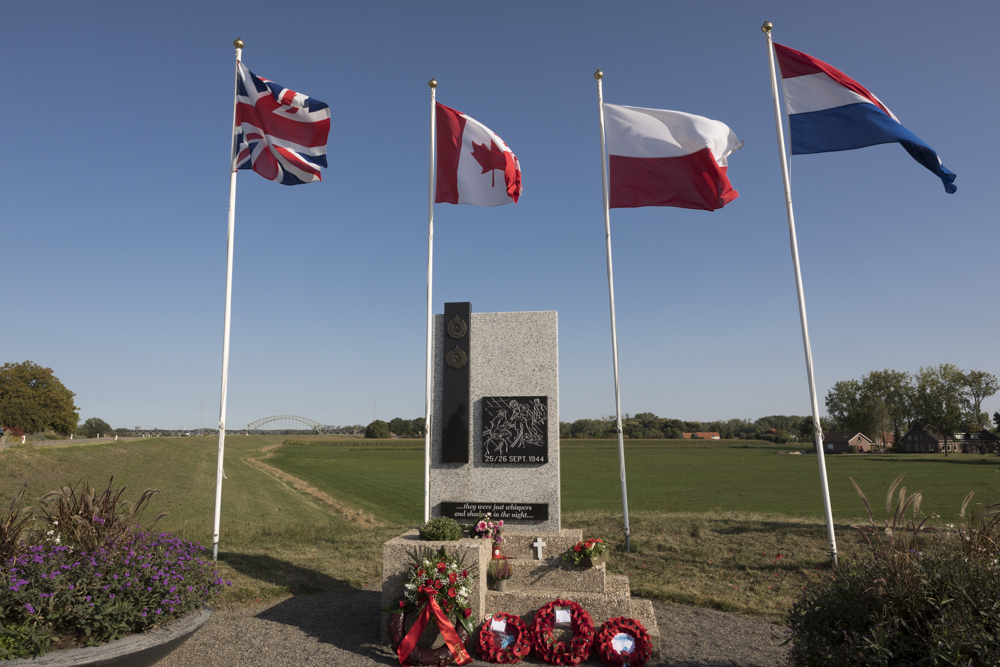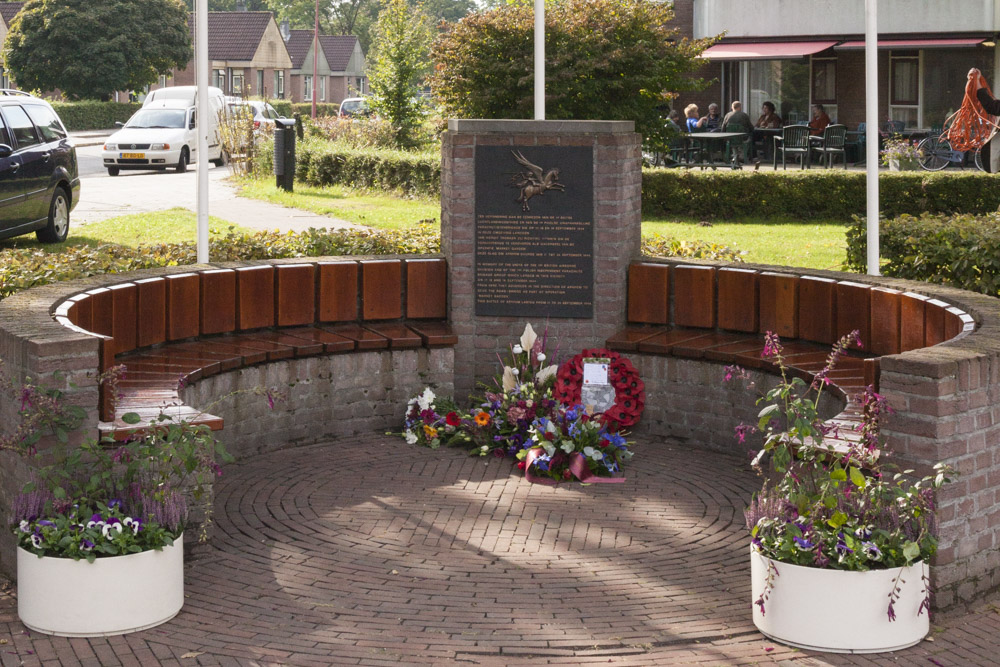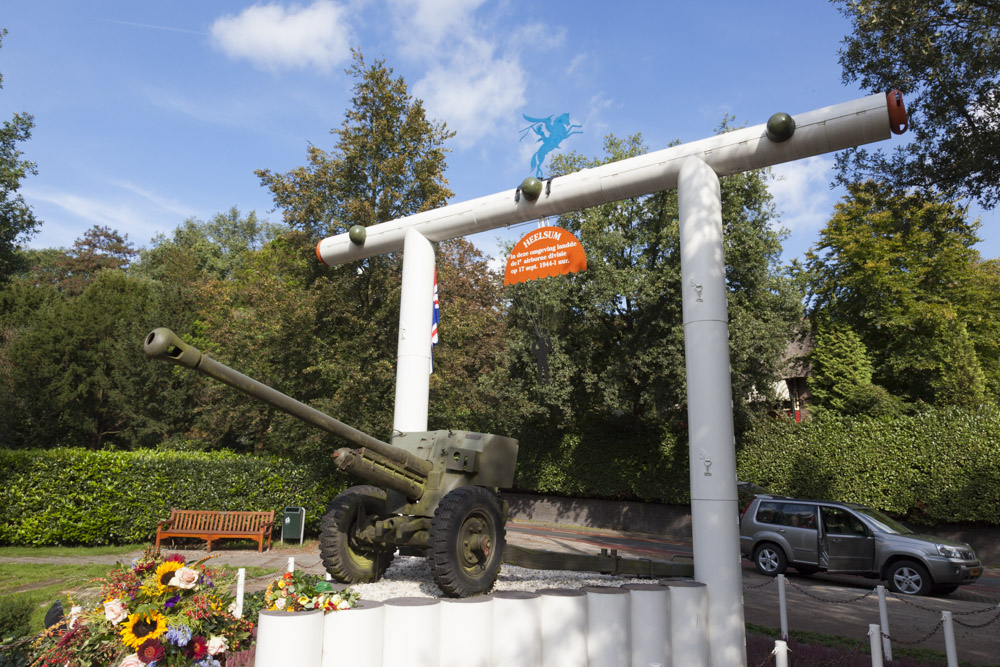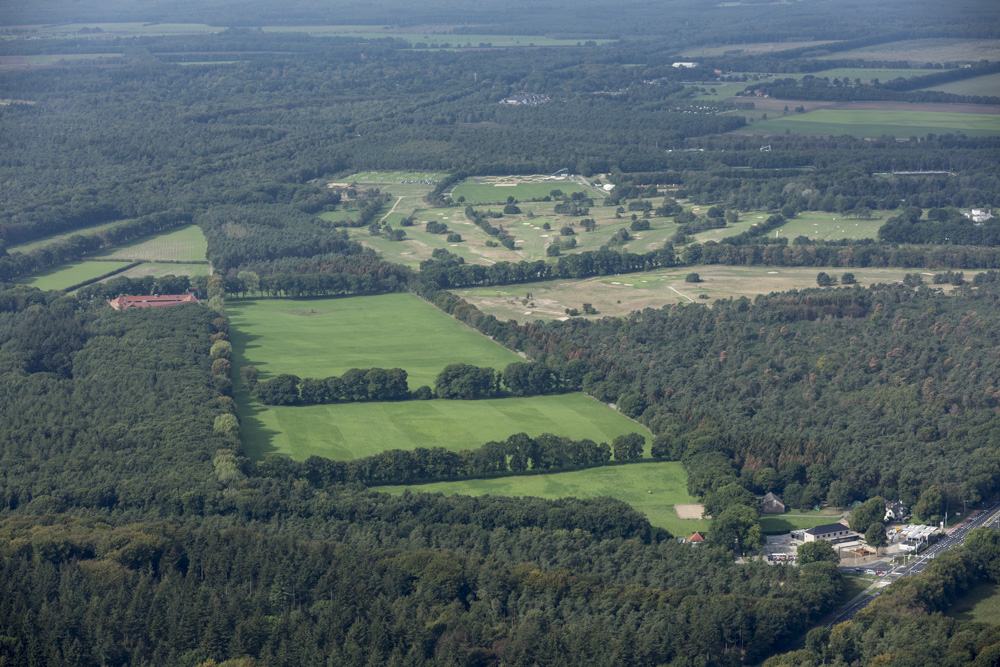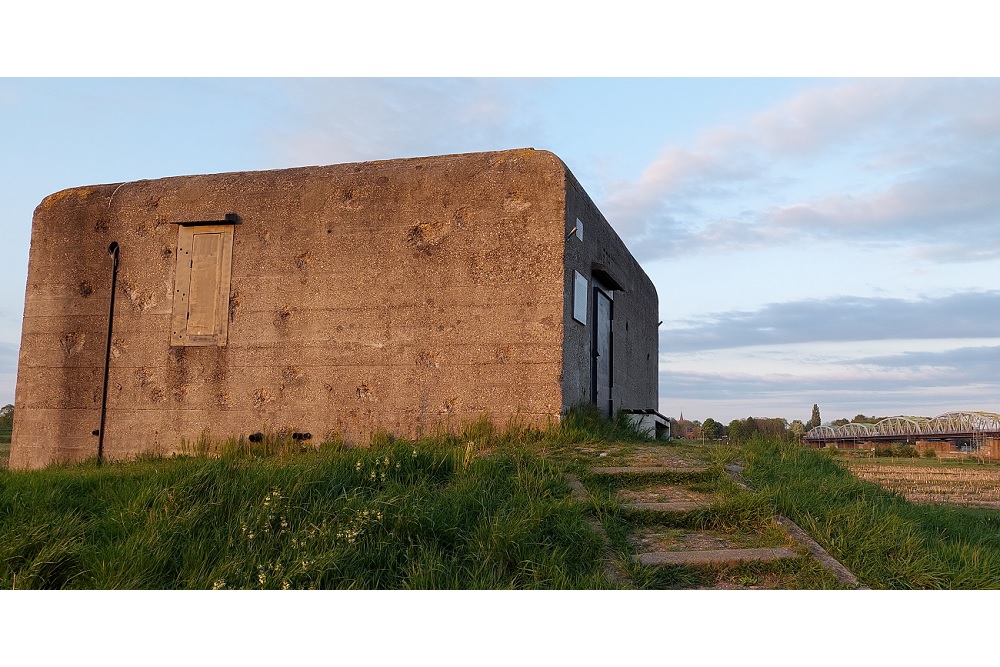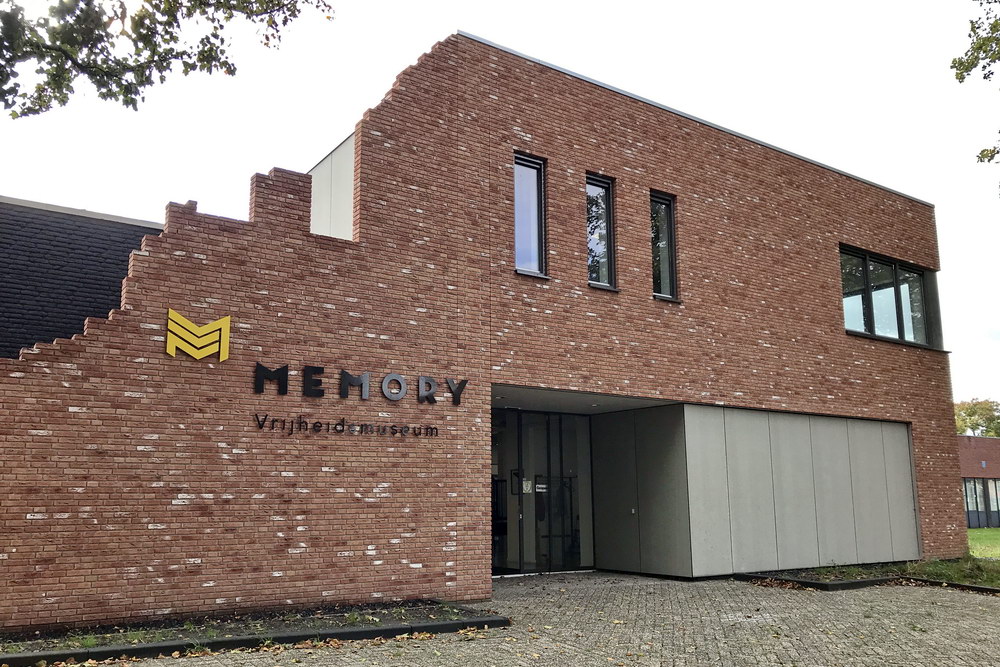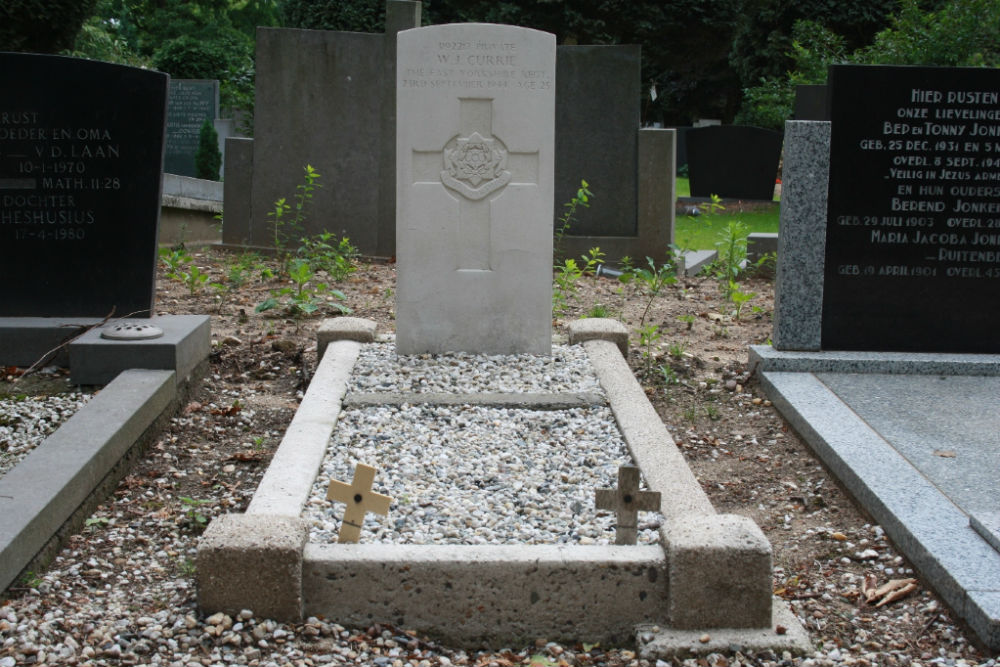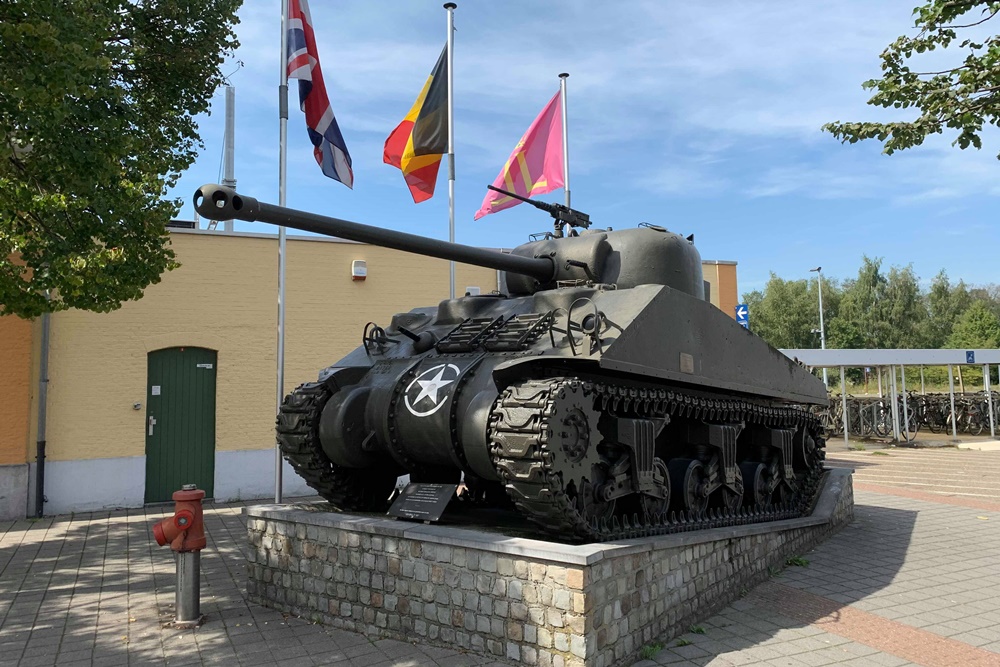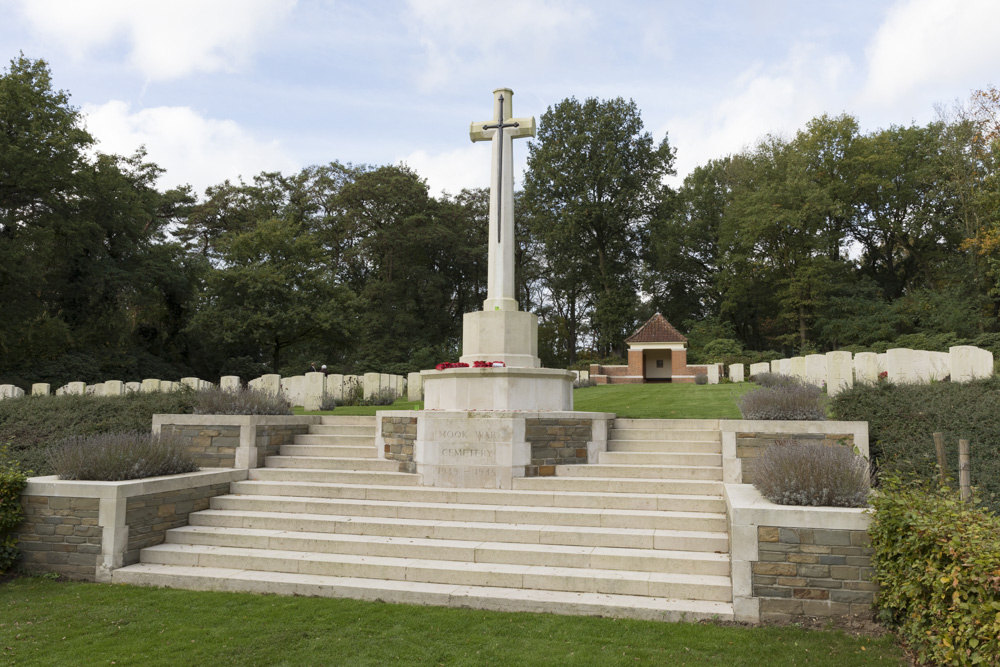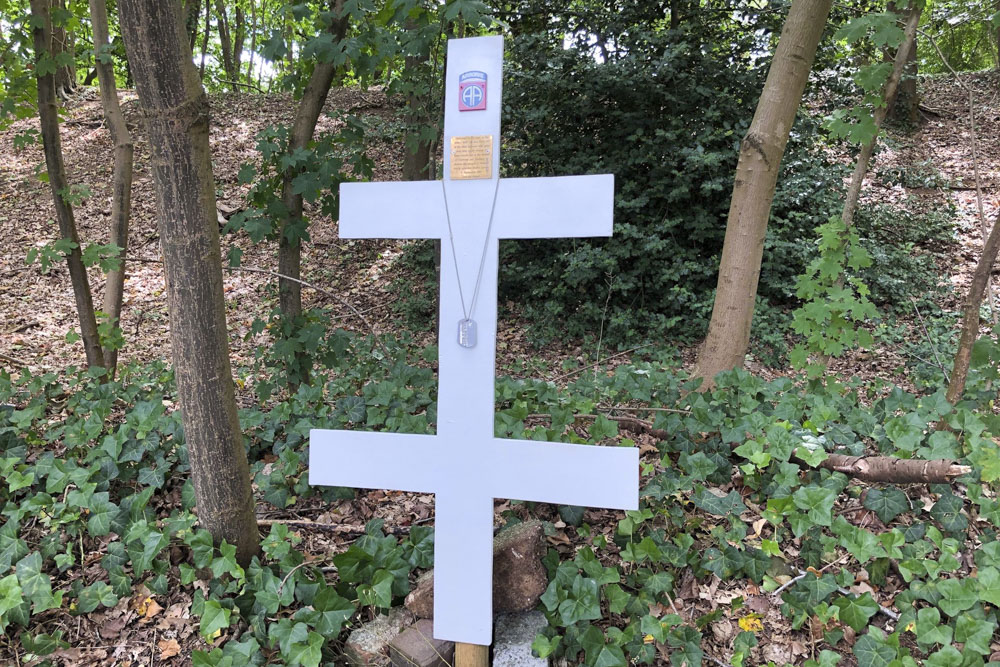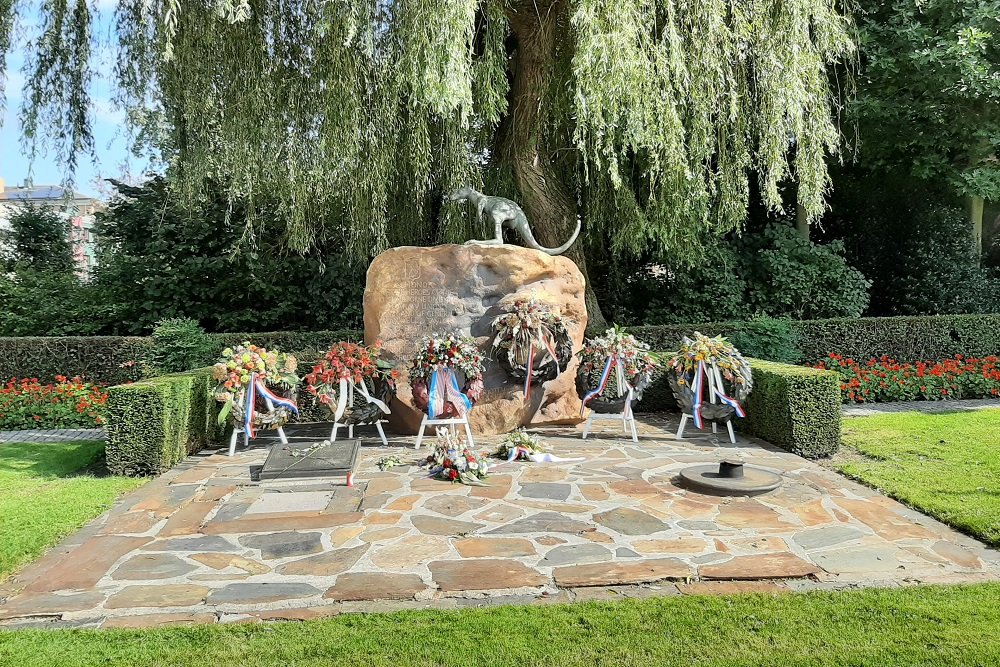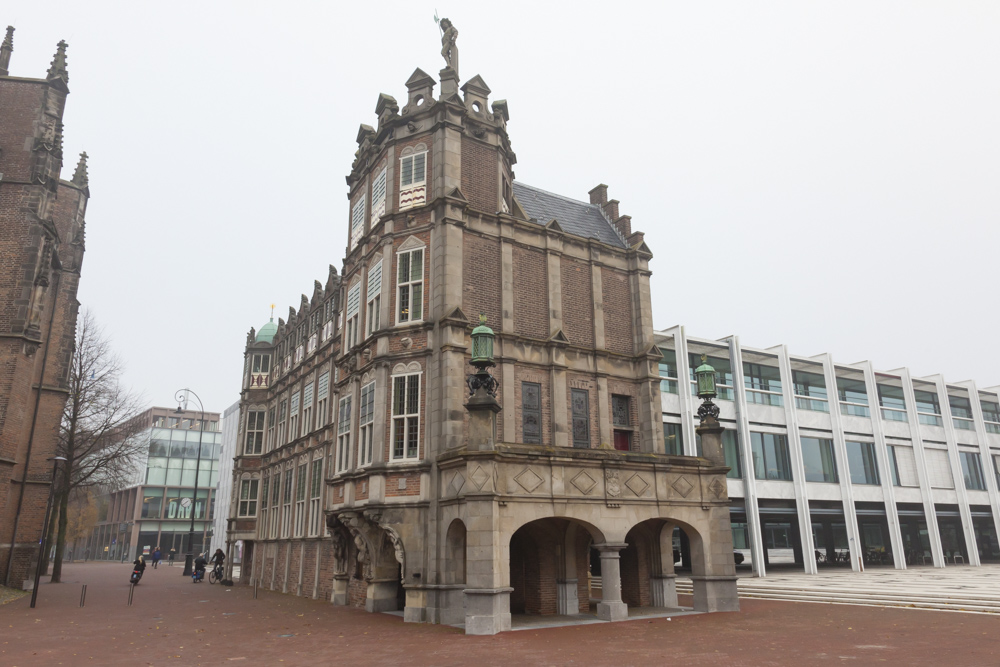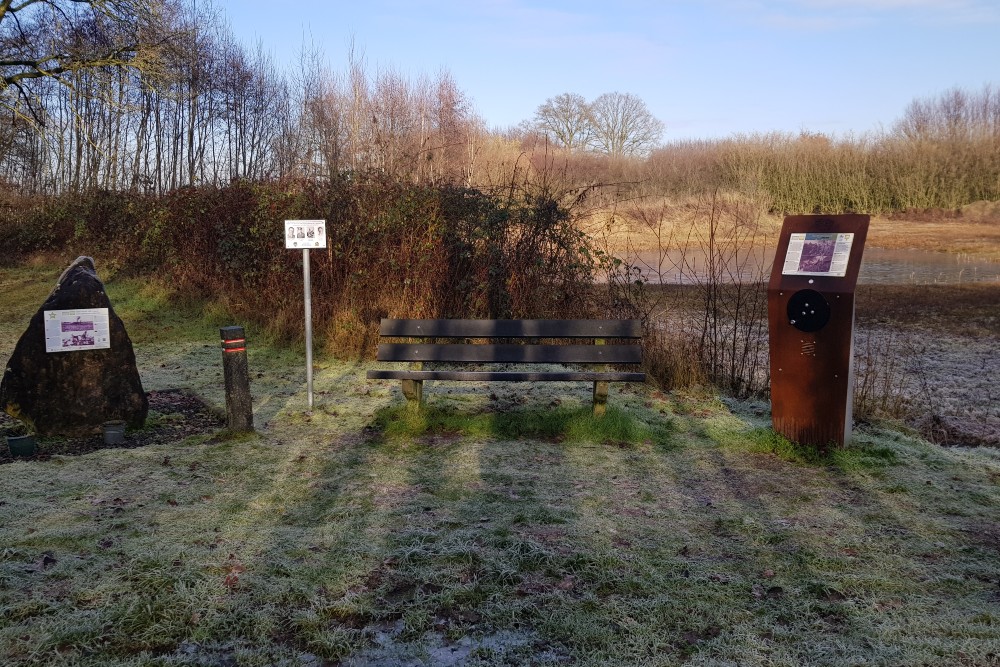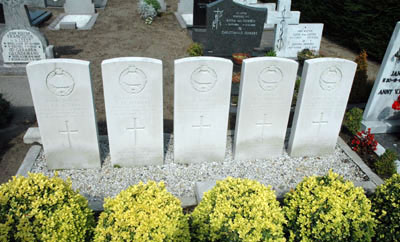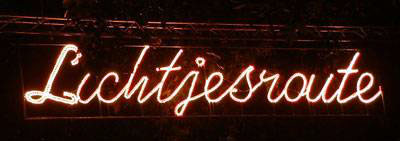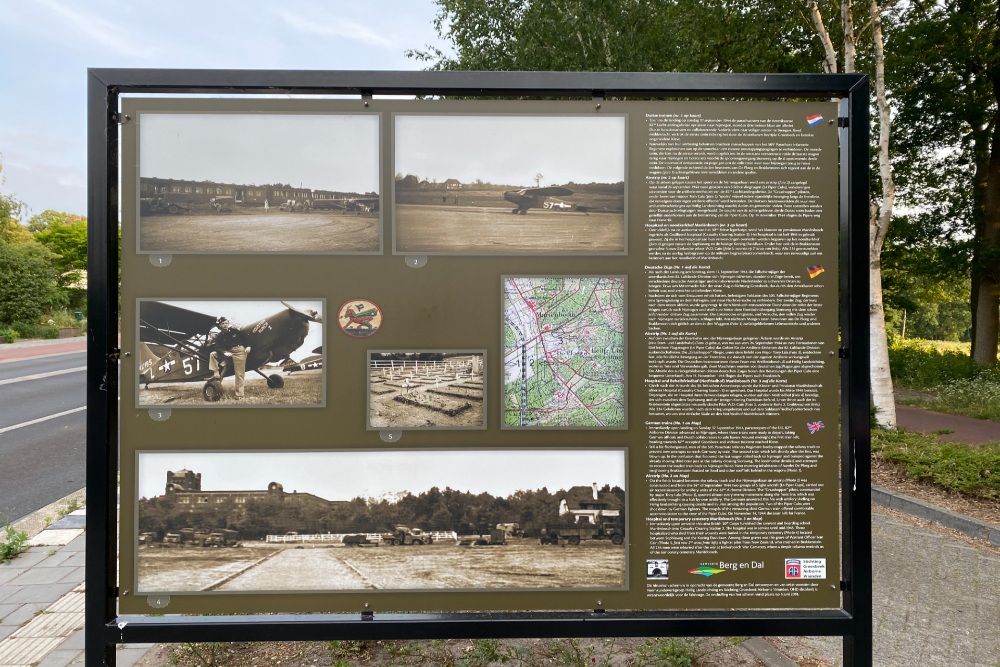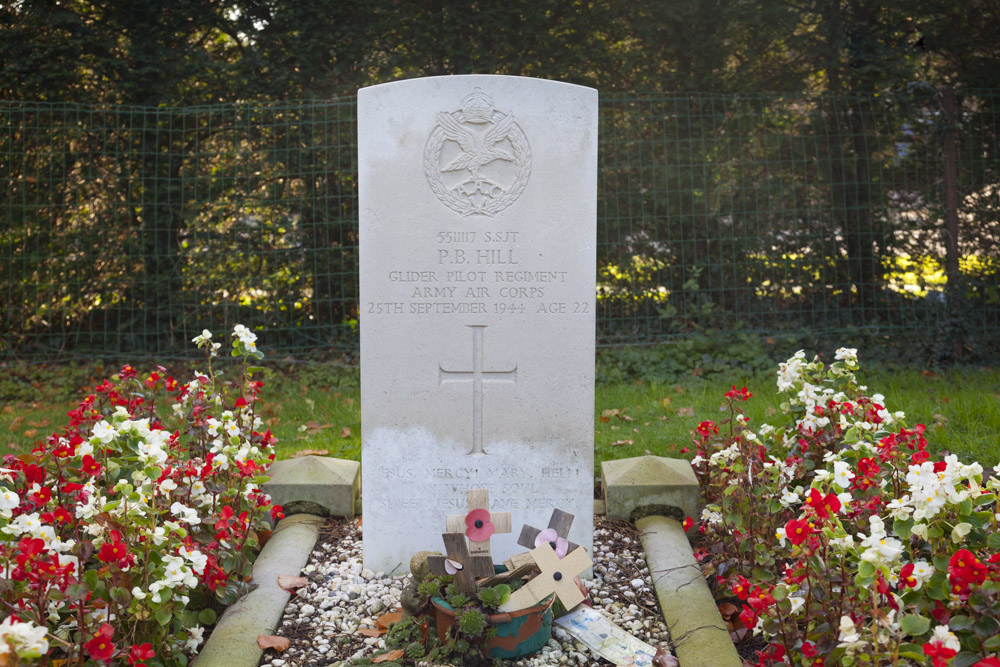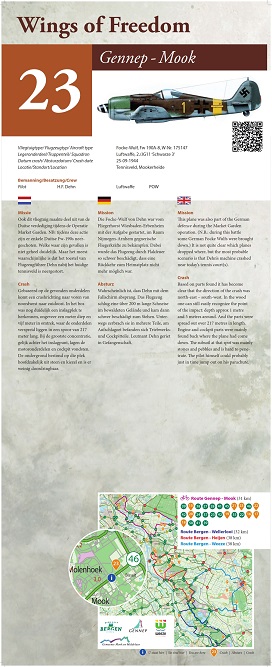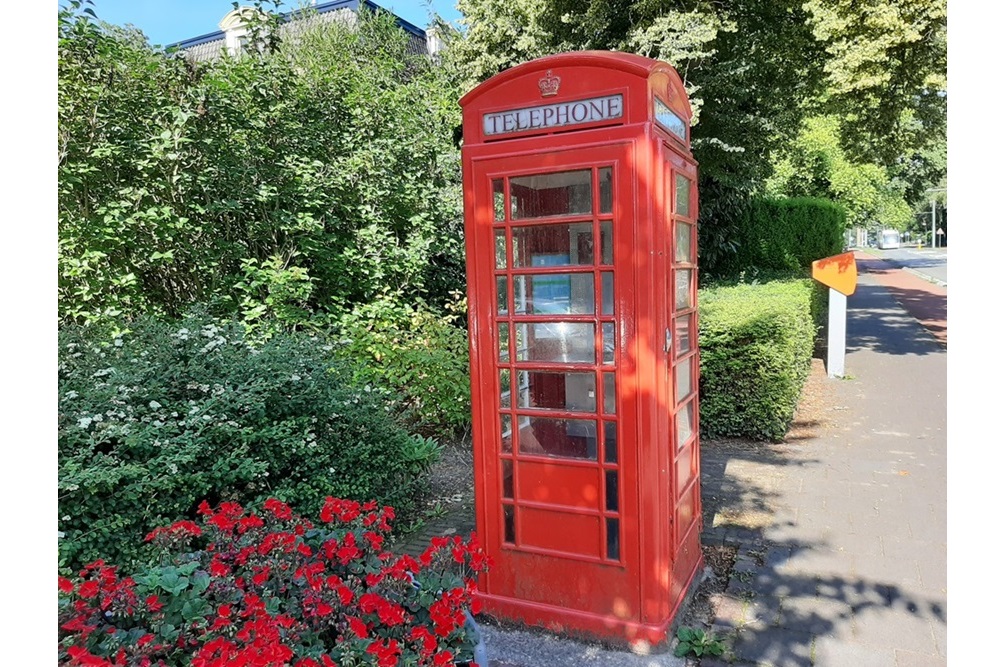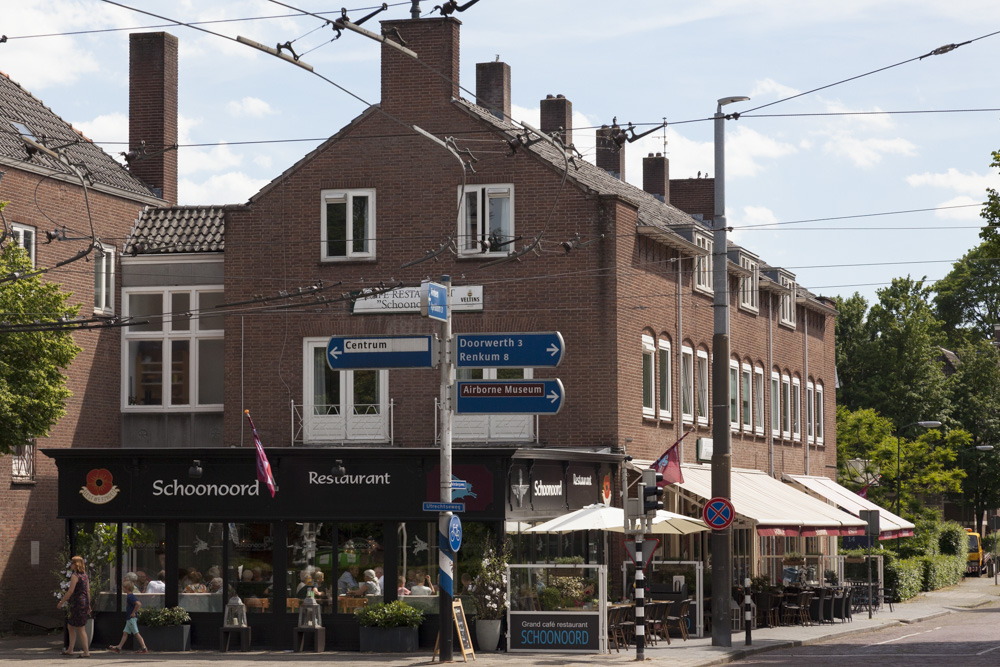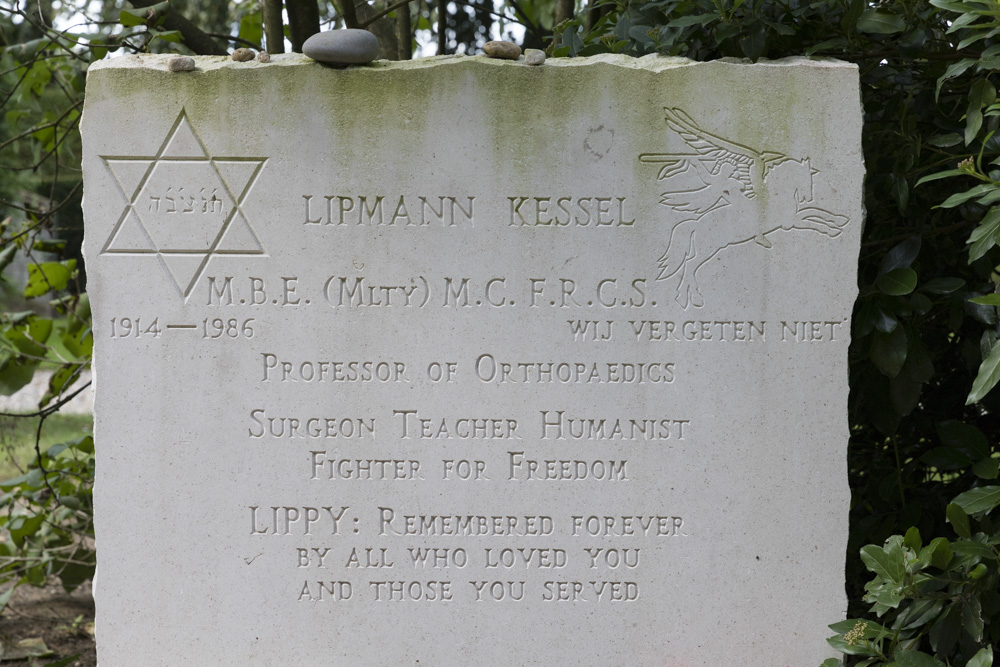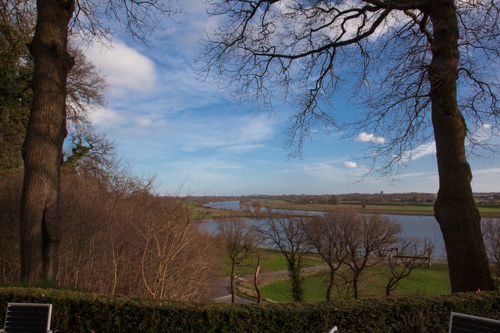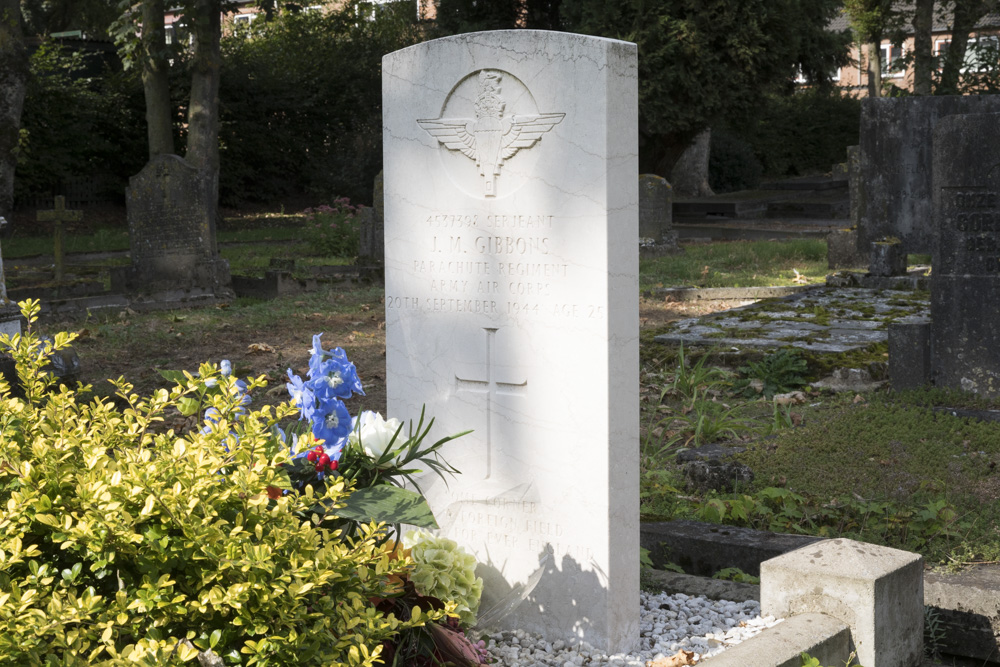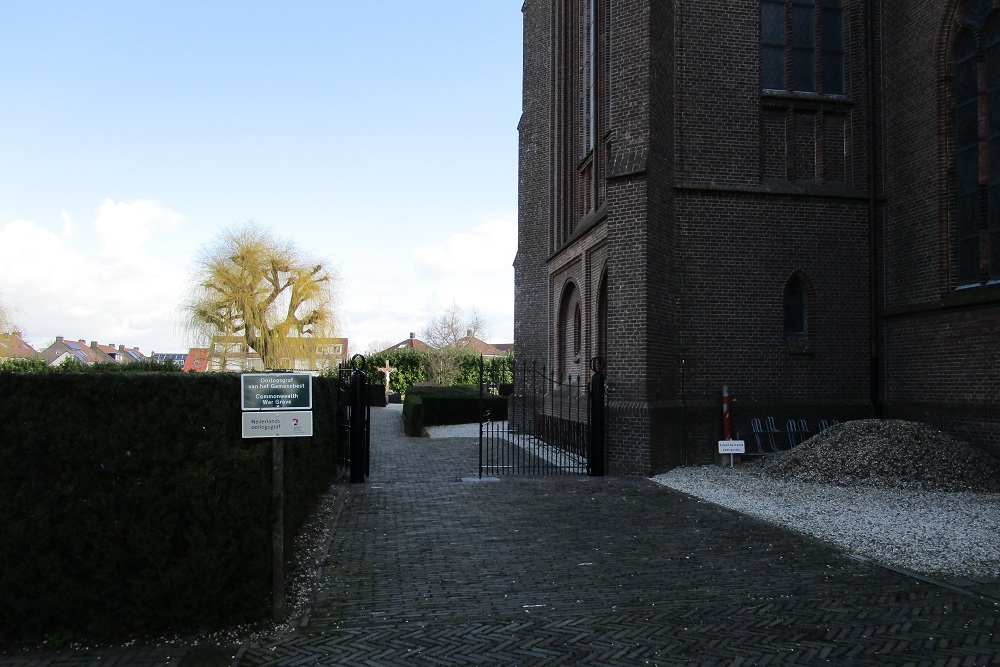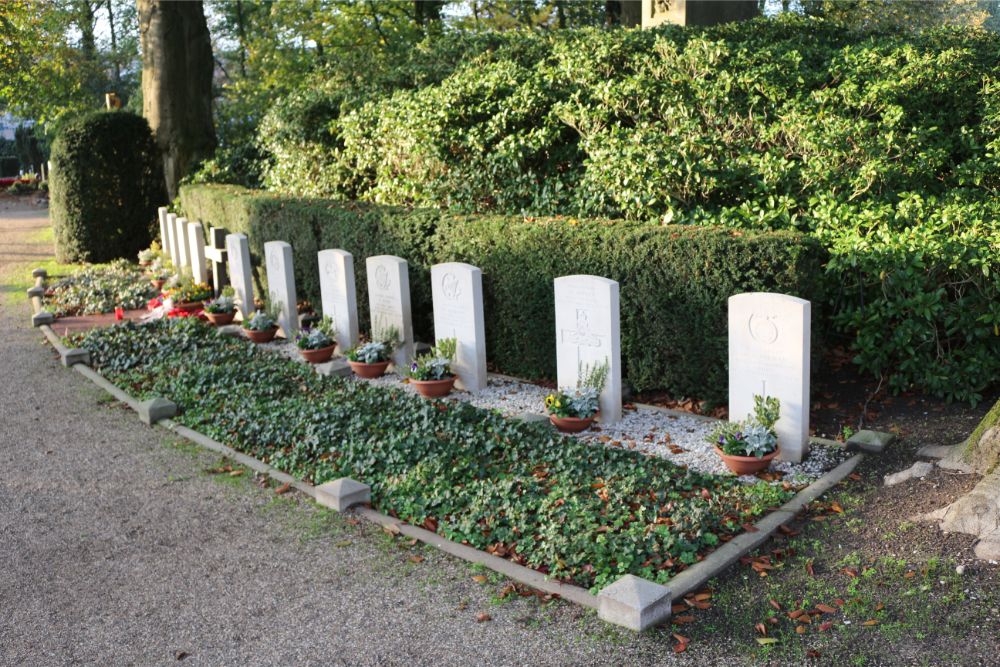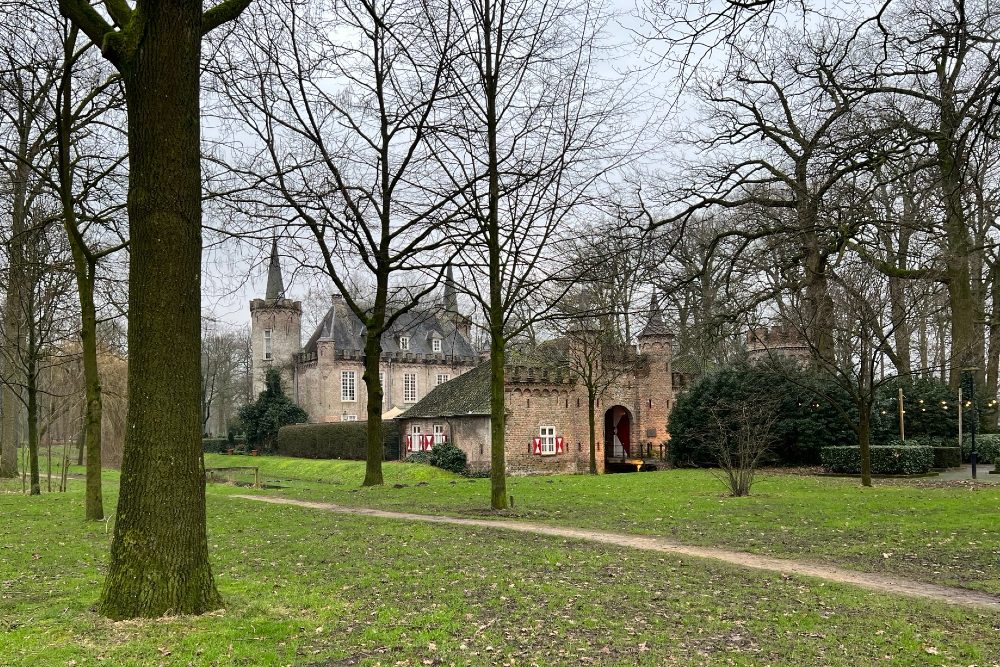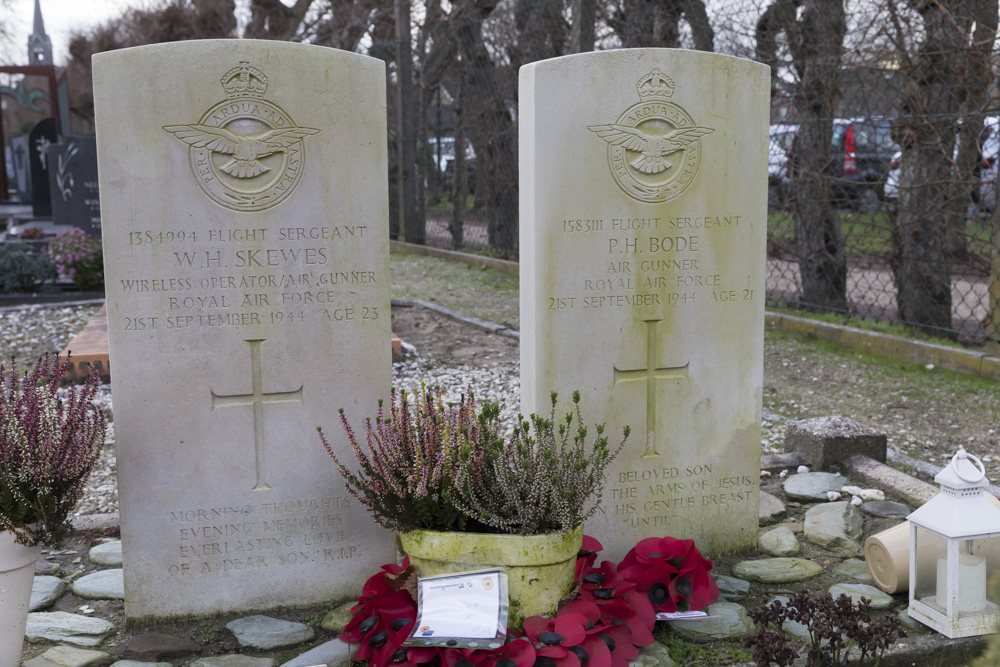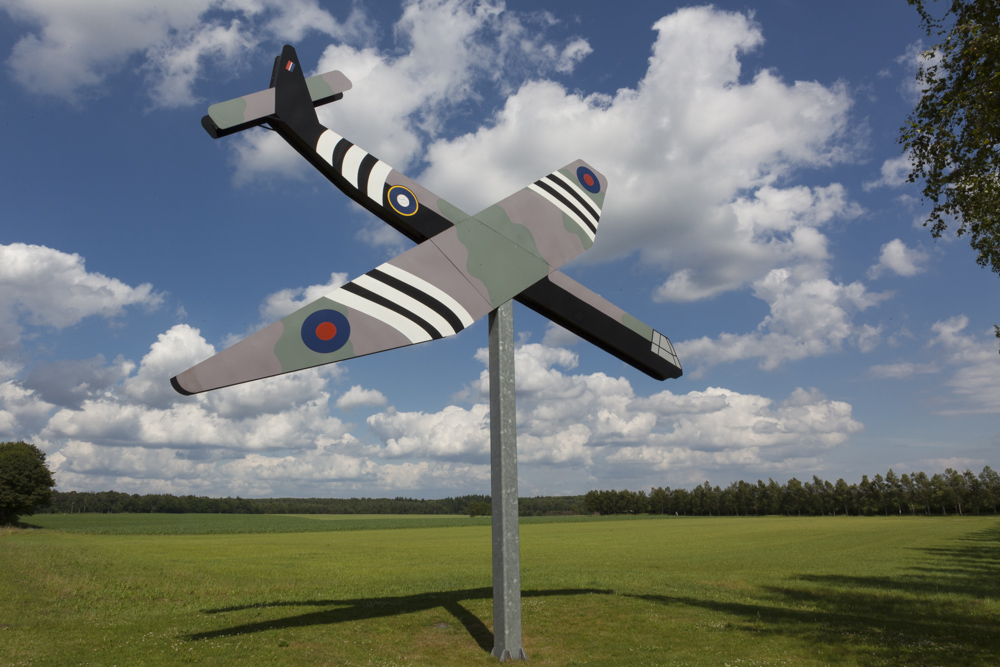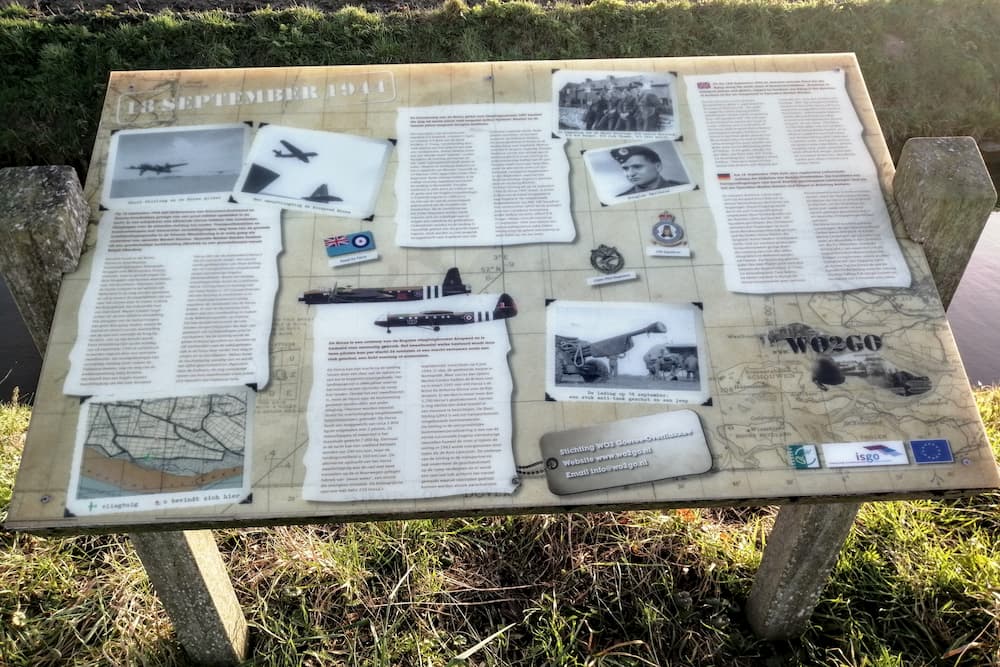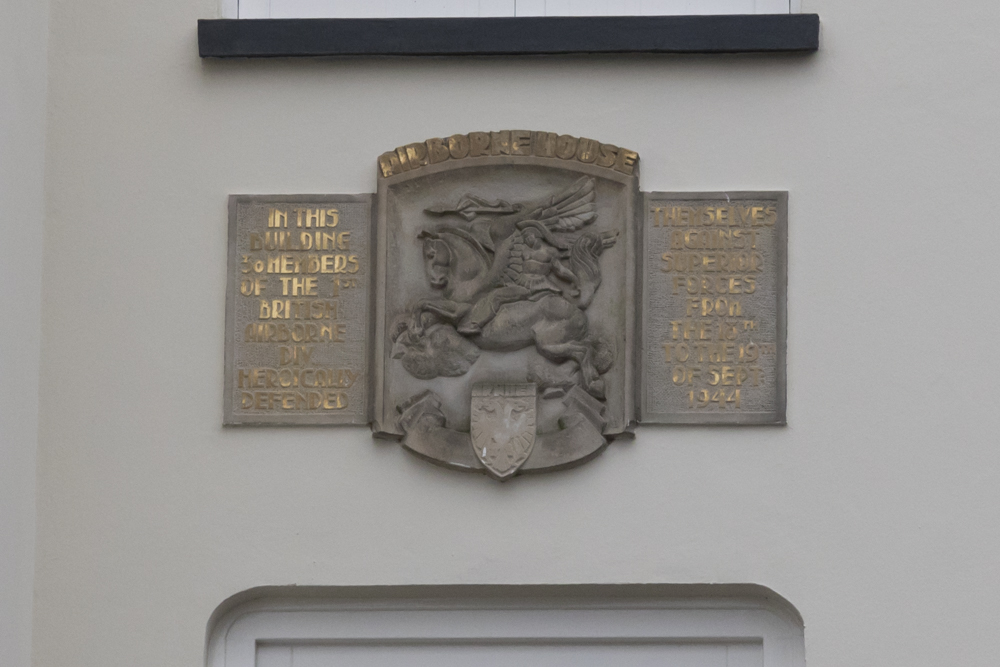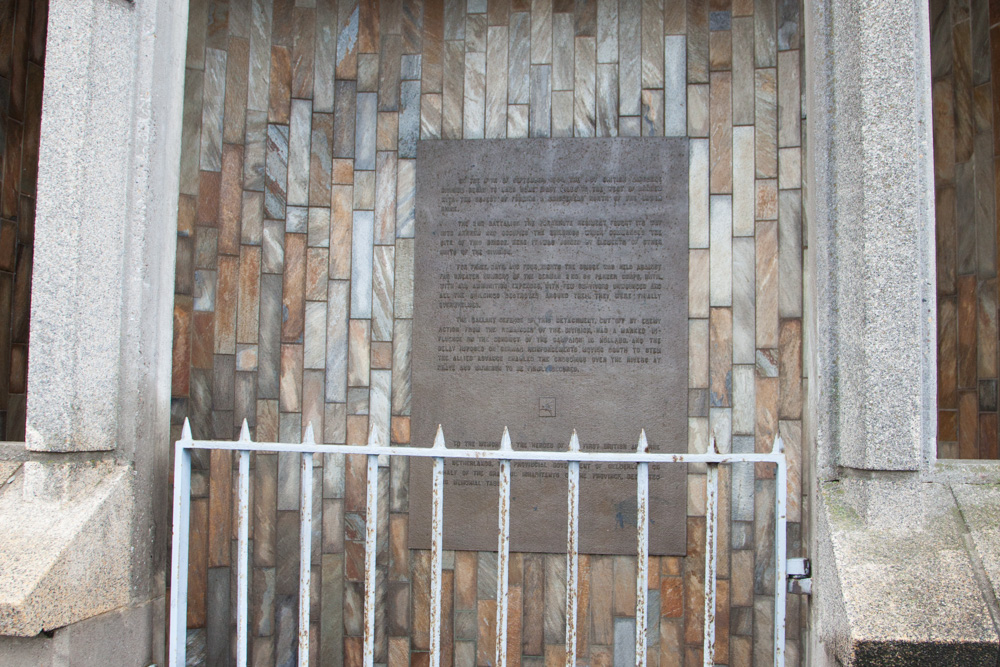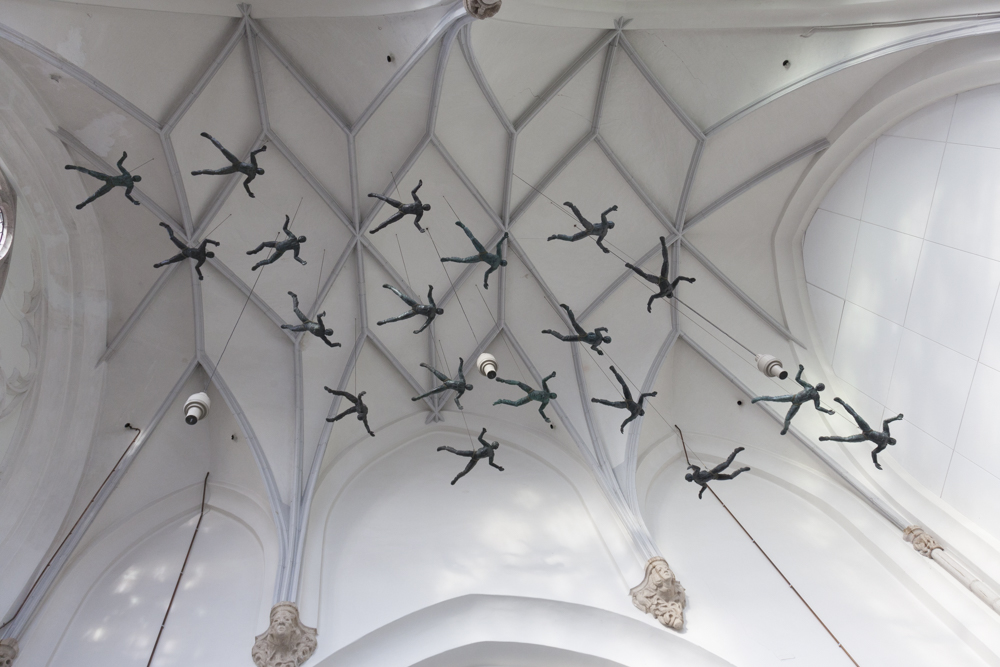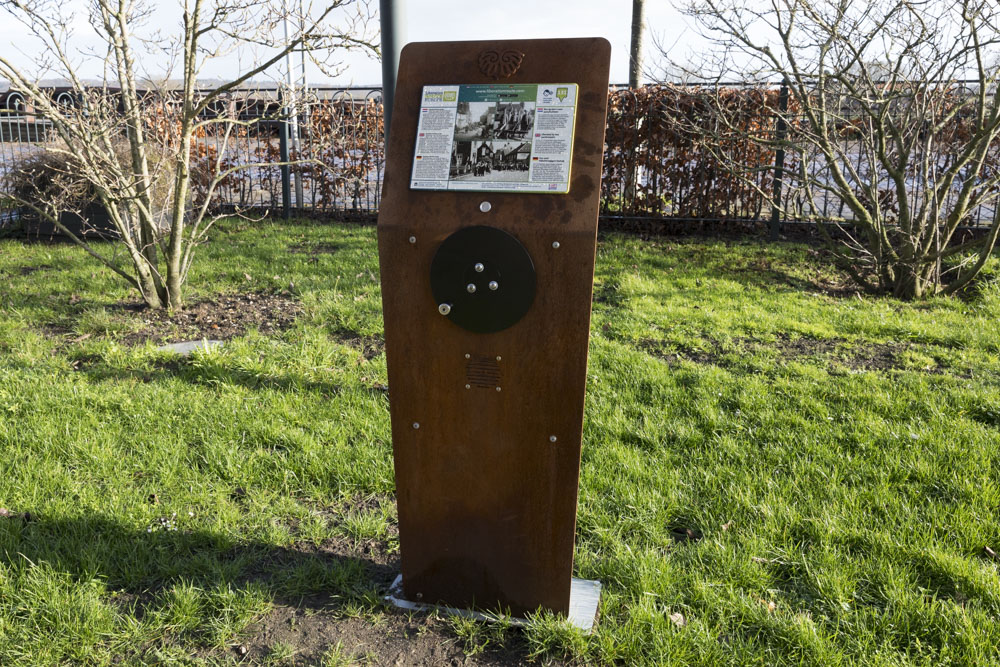Prologue
According to history, Operation Market Garden should have been the operation that was to put an end to World War Two in Europe before the end of 1944. Up until today, this operation still triggers discussions about the goals, the set up and the result. This often appears to make whatever was decided and has happened at the time disappear into the background. It appears that in particular questions of guilt and what in fact should have been done have gained the upper hand in history.

Paratroops of 1st Airborne Division being dropped during Market Garden. Source: National Archives and Record Administration
Following the Battle of Normandy it seemed like the German defense had become confused. It appeared the German army had been defeated and towards September, almost all of France and Belgium had been liberated. It wasn't the German defense however, which prevented the Allies from taking advantage of this situation quicker. The real cause were the Allied supply lines becoming too long to supply all troops sufficiently. In order to solve tis, more ports were urgently needed. Although on September 4 the port city of Antwerp[1] had fallen into British hands virtually undamaged, the supply line through the River Scheldt firmly remained in German hands.
Right at that moment, the Allied supply lines couldn’t handle it anymore and the British advance to the north came to a halt, allowing German Heeresgruppe B, commanded by Generalfeldmarschall Walter Model defending this area, to regroup. When XXX Corps, commanded by Lieutenant-general Brian Horrocks leading the attack to the north, had been sufficiently supplied on September 6 to resume the advance, it was halted again a few miles from the Dutch border. At the Scheldt-Meuse Canal the Germans had established a well-organized defense. They had managed to extract 15. Armee, commanded by General der Infanterie Gustav-Adolf von Zangen from its precarious position in northwestern Belgium across the Scheldt.
As the front on the Scheldt-Meuse Canal was in danger of bogging down, the Allied commanders were compelled to switch tactics. Simultaneously supporting the advance of the Americans in northeastern France and the British-Canadian advance in northwestern France and Belgium was no option from a logistical point of view. In the ensuing discussion, Field marshal Bernhard Montgomery tried to solve the issue by proposing an audacious plan, Operation Comet. This plan entailed an air drop by the British 1st Airborne Division commanded by Major-general Robert E. Urquhart in the Netherlands. The operation was intended to capture the most important bridges across the rivers to allow the advance by 2nd British Army commanded by Lieutenant-general Miles Christopher Dempsey via the route paved by the airborne troops. General Dwight Eisenhower considered the plan too risky and rejected it, hence Montgomery adapted his plan. He proposed a ground attack by 2nd British Army with XXX Corps leading the way and the deployment of no less than three airborne divisions. This was how Operation Market Garden came to be.
Consisting of an airborne operation code named Market and a ground operation code named Garden, this combined operation by British, American and Polish forces was to drive a huge wedge in the German defense lines in the Netherlands. According to reports, only second rate forces were stationed in the area. This way, a decisive blow could be dealt to the German defense. By circumventing the feared German
Market Garden was approved and with it, one of the largest operations of the Second World War was launched. The result is well known. Regardless of all discussions about this, it can be said that overestimation of the Allied logistic capabilities and underestimation of the German troops in the area have prevented Operation Market Garden from reaching its objectives.
Definitielijst
- Division
- Military unit, usually consisting of one upto four regiments and usually making up a corps. In theory a division consists of 10,000 to 20,000 men.
- Heeresgruppe
- The largest German ground formation and was directly subordinate to the OKH. Mainly consisting of a number of “Armeen” with few directly subordinate other units. A Heeresgruppe operated in a large area and could number several 100,000 men.
- marshal
- Highest military rank, Army commander.
- Westwall
- Also known as Siegfried Line, the German defence line along the German-French border.
Plans for attack
After the battles in Normandy and in northern France, the Allied advance was split up in three groups. General Dwight Eisenhower, Commanding Officer Supreme Headquarters Allied Expeditionary Forces (SHAEF), was in command of three simultaneous campaigns. Field Marshall Bernhard Montgomery was in charge of the 21st Army Group which was successfully advancing north and approaching the Dutch border. From the south of France, 6th Army Group, commanded by Lieutenant-general Jacob L. Devers [3] was moving north. This army group encountered fierce resistance from the German troops they were facing. Between those two, 12th Army Group commanded by Lieutenant-general Omar N. Bradley[4] was advancing eastwards to the River Rhine and the German border
These three campaigns demanded many logistic efforts. Due to the ever increasing length of supply lines, Montgomery proposed, as early as August, to switch strategy. Supplying three campaigns simultaneously would be impossible He proposed to allow his 21st Army Group, supported by the US 1st Army, commanded by Lieutenant-general Courtney H. Hodges to advance northwards. To this end, the bulk of the supplies should be sent to his 21st Army Group. Montgomery argued that German resistance against his troops was as good as destroyed. A breakout in northerly direction would also have the advantage to knock out the launch sites of the V-1 and V-2 in the area. Subsequently, the French ports could be liberated and put to use. Montgomery even indicated he would be willing to serve under Lt-Gen. Omar Bradley if this would help to have his plan approved.
There was much opposition from the American side against the plan. Regarding their successes in Normandy, various American commanders were convinced that the US should be in charge of the further advance. Eventually, Bernard Montgomery managed to convince Dwight Eisenhower. This full turn of him had various causes. After Operation Overlord had ended, Air Chief Marshall Trafford Leigh-Mallory had closed the headquarters of the Allied Expeditionary Air Forces and the participating units had been placed under their national command. The RAF regained command of her 2nd Tactical Air Force and the USAAF was again in charge of the 9th Air Force. On August 2, 1944, Eisenhower decided to integrate the airlanding components into the Combined Airborne Forces Headquarters of Lieutenant-general Lewis H. Brereton. On August 16, this was renamed First Allied Airborne Army. The intention was to achieve a fictitious US 1st Army Group to deceive the German intelligence services. This group was to consist of the US XVIII Airborne Corps (17th Airborne Division, 82nd Airborne Division and 101st Airborne Division) commanded by Major-general Matthew B. Ridgeway and the British 1st Airborne Corps (1st Airborne Division, 6th Airborne Division and 1st Polish Independent Parachute Brigade) commanded by Major-general Frederick Browning. The American Army command in Washington wished however that First Allied Airborne Army would be deployed in large operation soon. With his decision to put Montgomery and his 21st Army Group in command, Eisenhower decided to integrate this group into this army group. This way, Market Garden began to take shape.
The plan entailed a speedy attack by British 2nd Army from a starting point on the Scheldt-Meuse canal to the north up to Nunspeet in the Netherlands near the Ijsselmeer. This attack would be supported by drops of the First Allied Airborne Army. The intention was to capture the bridges on the route of the advance, allowing it to proceed smoothly. After this advance, 2nd Army could push on towards the east to the heart of Germany. On September 10, 1944 the plan was approved by the Allied high command and Market Garden became a reality. The date of the operation was set at September 17, 1944.
The airborne component, Market, was to see to the capture all bridges across all waterways at Eindhoven, Nijmegen and Arnhem. In the air landings, mainly RAF aircraft would be used to tow the gliders and aircraft of the USAAF would transport the paratroops. The transfer of all troops would take three days. On the fourth day, the 52nd Lowland Division would be flown in on transport aircraft to the captured Deelen airfield near Arnhem. Major- general Paul L. Williams, commanding officer of US IX Troop Carrier Command was one of the commanders who had insisted on a maximum of one transfer flight per day. He was supported in this by Lieutenant-general Lewis Brereton, commanding officer of the 1st Allied Airborne Army. More flights would be too strenuous on ground as well as on flying personnel, risking more losses. A direct consequence was that all three airborne divisions wouldn't be at full strength on the first day and would be compelled to maintain troops around the landing zones as those had to be kept open for future landings. The British 1st Airborne Division suffered an extra handicap as part of the aircraft destined for the unit was allocated to a group of the 82nd Airborne Division. In fact, they were to transfer 1st Airborne Corps’ Headquarters to Nijmegen as Major-general Frederick Browning had decided his HQ was to accompany the attack.
That first day, the troops in the first waves were to attack important strategic objects and defend the landing zones until all troops had arrived. At the same time, an area had to be held enabling the ground operation to advance through these captured areas. It was assumed that hardly or no resistance at all was to be expected from German side.
Initially, Major Brian Urquhart, Chief of Intelligence of British I Airborne Corps (not to be mistaken for Brigadier Roy Urquhart, commander of British 1st Airborne Division), voiced his doubts about this. He said messages from the Dutch resistance, indicating the possible presence of the German II. SS-Panzerkorps in the vicinity of Arnhem were utterly ignored. It had already been decided though that the operation should continue. Major Urquhart was compelled to take sick leave
The 1 Airborne Corps was placed in command of the entire landing operation, which comprised the British 1st Airborne Division, the American 82nd Airborne Division, 101st Airborne Division and the Polish 1st Independent Parachute Brigade Group. Allocation of the various tasks was the responsibility of Browning, ordering 101st Airborne Division of Major-general Maxwell Taylor to land near Eindhoven. The 82nd Airborne Division commanded by Brigadier-general James M. Gavin was to land near Grave and Nijmegen and finally, British 1st Airborne Division commanded by Major-general Robert E was to land near Arnhem in order to repulse counterattacks from the north. The British would be supported by the Poles.
Prior to the operation, British and American bombers were to attack airbases in the Netherlands from which German fighters could attack the transport aircraft, as well as Flak positions along the air lanes and around the landing zones. In addition, various German military installations, such as barracks and troop concentrations were to be bombed. British and American fighters were to escort and protect the air armada of bombers, transport aircraft and gliders.
In the night of September 16 to 17, 282 aircraft of RAF Bomber Command would attack airfields in the Netherlands and just across the border in Germany. In the early morning of September 17, another 100 RAF bombers would attack the coastal batteries on Walcheren and Schouwen-Duiveland after which over 800 American bombers would strafe the various Flak installations along the route. Meanwhile, 2nd Tactical Air Force would launch precision attacks on various targets such as barracks around Arnhem, Ede and Nijmegen.[5]
A little north of Eindhoven, two landing zones near Son and Veghel had been allocated to the 101st Airborne Division. The unit was to capture the bridges at Son, Sint-Oedenrode and Veghel. The 501st Parachute Infantry Regiment (PIR), commanded by Colonel Howard R. Johnson was to land on DZ-A (Drop Zone A) near Veghel and focus on the rail- and road bridges across the river Aa and the Zuid Willemsvaart near Veghel. 502nd PIR, commanded by Colonel John H. Michaelis was to land on DZ-B northwest of Son. They were to protect the area for the gliders which would arrive later. In addition, they were to capture the road bridge across the river Dommel near Sint-Oedenrode and, if possible, support 506th PIR in its advance on Eindhoven. This unit, commanded by Colonel Robert F. Sink, was to land on DZ-B and DZ-C and subsequently capture the bridge on the Wilhelmina canal near Son. Next, they had to advance on Eindhoven, capture the bridges across the Dommel and their secondary target, the road and rail bridge near Best.[6]
The 82nd Airborne was dropped on two locations as well. Southwest of Nijmegen near Grave to capture the bridges near Grave across the Meuse and the Meuse-Waal canal near Nijmegen. The largest DZ was located between Nijmegen Berg en Dal and Groesbeek where troops would land to capture Nijmegen and the bridges across the Waal. The bridge near Grave, code named Bridge Number 11[7] was allocated to 504th PIR, commanded by Colonel Reuben Henry Tucker III[8] and would land southwest of Nijmegen on DZ-O near Overasselt[9] A few smaller units were to land close to the bridge near Grave, their secondary target being the bridges across the Meuse-Waal canal. These were Bridge Number 7 (Heumen), Bridge Number 8 (Malden), Bridge Number 9 (Hatert) and Bridge Number 10 (Honinghutje).[10] The area between the bridge at Grave and the bridges across the Meuse-Waal canal had been selected for this purpose.
505th PIR, commanded by Colonel William E. Ekman was to land south of Groesbeek on DZ-N[11] and then take Groesbeek and the higher terrain between the town and the Meuse-Waal canal. 508th PIR commanded by Colonel Roy E. Lindquist was to land on DZ-T in the triangle Nijmegen, Groesbeek, Berg en Dal and cut off Nijmegen from that direction. In addition they were to capture the road and rail bridges across the Waal at Nijmegen. Apart from all these targets, 508th PIR was to be on alert to protect the landing zones against possible German pressure. Supporting 505th PIR, the 376th Parachute Field Artillery Battalion commanded by Lt-Col Wilbur M. Griffith was to land close to them and be ready to support 504th PIR.[12] 307th Airborne Engineer Battalion (Colonel Edwin A. Bedell) was to land on DZ-N between Mook and Groesbeek.[13] The battalion served mainly in support of the various other units and protecting the flanks of the landing zone. The other troops of 82nd Airborne would be flown in later.
For operations around Arnhem, 1st Parachute Brigade commanded by Brigadier Gerald W. Lathbury), 1st Airlanding Brigade commanded by Brigadier Philip H.W. Hicks), Division Headquarters and various supporting units such as three batteries of 1st Airlanding Light Regiment commanded by Lieutenant-colonel William F.K. Thompson and the 1st Airborne Reconnaissance Squadron commanded by Major Charles Frederick Howard Gough) would be flown in first. These units would use the landing areas DZ-X, LZ-S (Landing Zone S) and LZ-Z. Shortly before landing the areas would be secured by Pathfinders of 21st Independent Parachute Company. The 1st Airlanding Brigade was to protect the areas for the benefit of the second landings the next day. 1st Parachute Brigade was to advance towards the bridge immediately and hold it until the arrival of the remainder of the division.
As the RAF, owing to heavy AA fire at the Arnhem bridge, didn't want to launch a surprise attack like the one in Normandy on Pegasus bridge, it was decided that 1st Airborne Reconnaissance Squadron would head for the bridge in their jeeps immediately after landing. They were to take it in a surprise attack and hold until 1st Parachute Brigade had reached the bridge on foot. Of this unit, 2nd Parachute Battalion, commanded by Lieutenant Colonel John Dutton Frost would head for the bridge along the Lower Rhine by a route code named Lion. They were to capture the railway bridge, the pontoon bridge and the road bridge in that order and secure them. 3rd Parachute Battalion commanded by Lt.-col. John A.C. Fitch, was to advance on the road bridge along the Utrechtseweg via the route codenamed Tiger. Finally, 1st Parachute Battalion commanded by Lt.-col. David Theodore Dobie was to strike for the bridge along the Amsterdamsestraatweg via a route codenamed Leopard in order to secure the ramps to and from the bridge on the higher terrain north of Arnhem
On the second day, 4th Parachute Brigade, commanded by Brigadier John Winthrop Hackett, would land on DZ-Y, together with the remaining units of 1st Airlanding Brigade and other supporting units of the division. Right after arrival, the entire division was to advance on Arnhem in order to seal off the city. On the third day, 1st Polish Independent Parachute Brigade Group, commanded by Major General Stanislaw Franciszek Sosabowski, would be flown in. His gliders were to land on LZ-L north of the Lower Rhine while the paras were to land on DZ-K south of the Lower Rhine. Finally, as soon Arnhem had been secured by 1st Airborne Division and airbase Deelen had been taken, 52nd Lowland Division, commanded by Major General Edmund Hakewill-Smith, would be flown in and join 1st Airborne Division.
Along this carpet of landings, the ground component Garden, XXX Corps, was to advance along a single, two lane highway. This corps would have the following units at its disposal: 2nd Household Cavalry Regiment commanded by Lieutenant Colonel Henry Abel Smith, Guards Armored Division commanded by Brigadier Allan Henry Shafto Adair, 43rd Wessex Division commanded by Lieutenant General Gwilym Ivor Thomas, 8th Independent Armored Brigade commanded by Brigadier George Erroll Prior-Palmer, 50th Northumbrian Division commanded by Major General Douglas Alexander Henry Graham and Royal Netherlands Brigade 'Prinses Irene' commanded by Colonel Albert Cornelis de Ruyter van Steveninck The Guards Armored Division was to take charge and if somewhere along the way, the unit should encounter a bridge not yet captured, 43rd Wessex Division was to force a crossing.
On the left flank, the advance would be supported by XII Corps, commanded by Lt.-gen. Neil Methuen Ritchie and on the right flank by VIII Corps, commanded by Lt.-gen. Richard Nugent O'Connor. Both corps were not at full strength however and both, in contrast to XXX Corps, hadn't yet established a bridgehead on the Meuse-Scheldt canal. Moreover, elements of these corps were still fighting Germans on other flanks of their positions and therefore could not be released to cover the flanks of XXX Corps.[14] Yet, operational plans were drafted for both corps in support of Market Garden.
1st Canadian Army had taken over the west flank of XII Corps as early as September 10. The corps itself had a bridgehead near Geel, just across the Meuse-Scheldt canal but for an efficient advance, 53rd Welsh Division, commanded by (Major General Robert K. Ross, would establish a new bridgehead near Lommel, advance from there via Turnhout and Tilburg towards ‘s Hertogenbosch and cross the Meuse there. For its flank operation, VIII Corps had 11th Armored Division, commanded by (Major General George Roberts and the Belgian 1st Infanterie Brigade, commanded by (Colonel Jean-Baptiste Piron at its disposal and would cross the Meuse-Scheldt canal near St, Huibrechts-Lille and subsequently advance via Helmond on Cuijk a.d. Maas
While the plans were being drafted, the Dutch government in exile in London was consulted closely. In support of the operation, the government ordered the Dutch Railway Company to call a general strike in order to thwart the movement of German troops. In addition, plans were made to organize and activate the resistance groups in the area. To this end, so-called Jedburgh teams were deployed in order to contact the resistance in the occupied areas and assist them as good as possible in activities to support the landing troops. In order to facilitate communication, Dutch military, mostly having been trained as commandoes, were allocated to various Allied units and the Jedburgh teams as interpreters, guides and communication experts.
As starting point of the ground operation of XXX Corps, the bridge on the Scheldt-Meuse canal (Kempisch canal) in Barrier (Lomnmel), also known as Groot Bareel was selected. This bridge was captured on September 10[15] by No. 1 Squadron, commanded by Major David Arthur Peel of 3rd Battalion, Irish Guards commanded by Lt.-col John Ormsby Evelyn Vandeleur. Due to the command by J.O.E. VandeLeur, this bridge was nicknamed Joe’s Bridge. On September 11, 1944, D Squadron commanded by Lieutenant Rupert Buchanan-Jardine, of the 2nd Household Cavalry Regiment commanded by Lt.-colonel Henry Abel Smith had made a reconnaissance of the area beyond the bridge. On the night of September 16, 1944 everyone stood poised to launch Operation Market Garden.
Definitielijst
- Bomber Command
- RAF unit which controlled strategic and sometimes tactical bombing (as in Normandy)
- Brigade
- Consisted mostly of two or more regiments. Could operate independently or as part of a division. Sometimes they were part of a corps instead of a division. In theory a brigade consisted of 5,000 to 7,000 men.
- Browning
- American weapon’s designer. Famous guns are the .30’’ and .50’’ machine guns and the famous “High Power” 9 mm pistol.
- Cavalry
- Originally the designation for mounted troops. During World War 2 the term was used for armoured units. Main tasks are reconnaissance, attack and support of infantry.
- Division
- Military unit, usually consisting of one upto four regiments and usually making up a corps. In theory a division consists of 10,000 to 20,000 men.
- Flak
- Flieger-/Flugabwehrkanone. German anti-aircraft guns.
- Infantry
- Foot soldiers of a given army.
- RAF
- Royal Air Force. British air force
- Regiment
- Part of a division. A division divided into a number of regiments. In the army traditionally the name of the major organised unit of one type of weapon.
- resistance
- Resistance against the enemy. Often also with armed resources.
- SHAEF
- Supreme Headquarters Allied Expeditionary Force, the Allied High Command in Western-Europe after the Normandy landings.
- Squadron
- A military unit in the Belgian navy usually six to eight small ships operating together under one command. The smallest military unit in the Dutch air force of about 350 men. In most countries is the designation of a military unit thesize of a company. It is either an independent unit, such as a battery, or part of a bigger Calvary unit. In the air force it is the designation of a unit of aircrafts.
- strategy
- Art of warfare, the way in which war should be conducted in general.
The German situation
Owing to the speedy advance of the Allies through northern France and Belgium, it looked like the Netherlands would be liberated soon. As a result, light panic broke out among the Germans. As early as September 2, 1944, Reichskommissar für die besetzten Niederländischen Gebiete Arthur Seyss-Inquart had ordered all German citizens to evacuate to the eastern part of the country. In case of danger, they could escape to Germany quickly. Seyss-Inquart entrenched himself in his bunker in Apeldoorn. Anton Mussert, the leader of the Nationaal Socialistische Beweging (NSB) also advised his party members to head in the direction of Germany. The capture of Antwerp on September 4 triggered panic the next day among German troops and members of the NSB. Many German military deserted and entire units withdrew head over heels towards Germany. The Dutch fell into the spell of an imminent liberation and started to celebrate. This day would later be known as ‘Dolle Dinsdag’ or Crazy Tuesday.
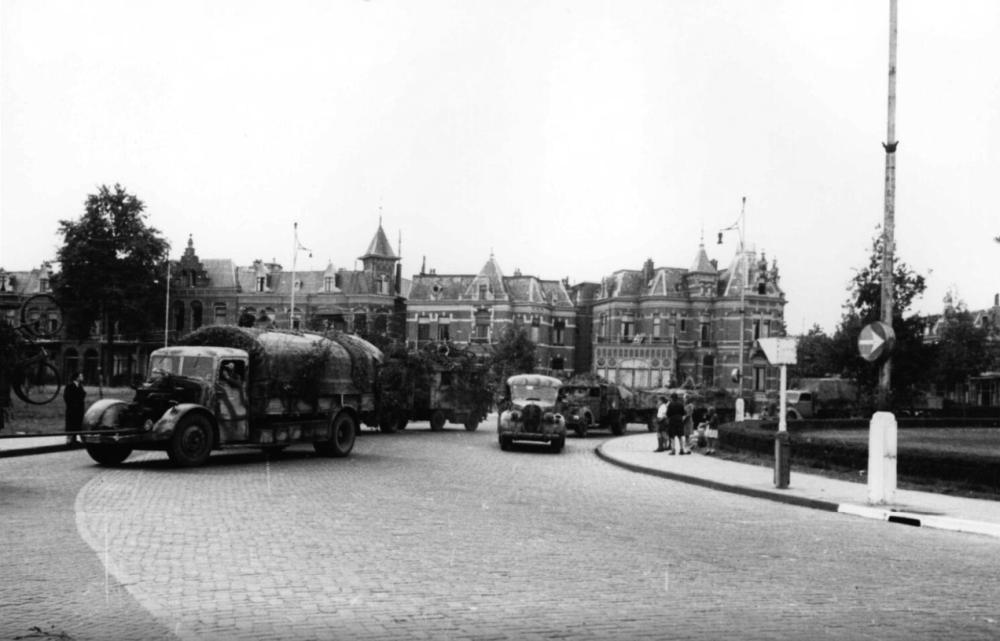
Crazy Tuesday. Germans are fleeing, Keizer Lodewijk Square, Nijmegen. Source: Regionaal Archief Nijmegen
To restore order, Oberbefehlshaber West, Generalfeldmarschall Walter Model was relieved of his function and appointed Befehlshaber Heeresgruppe B. September 5 Generalfeldmarschall Gerd von Rundstedt was named his successor. Walter Model faced chaos. His Heeresgruppe had actually been cut in two. 15. Armee commanded by General der Infanterie Gustav-Adolf von Zangen had been cut off south of the Westerscheldt and was desperately trying to escape to the north via Walcheren and Zuid-Beveland. 7. Armee commanded by General der Panzertruppen Erich Brandenberger, had been pushed back eastwards to Maastricht and Aachen by the Americans. Now there was a 75 miles gap through which various German units escaped in chaos. Walter Model ordered Generalleutnant Kurt Chill, who had virtually lost his entire 85. Infanterie Division, to pull the remaining units in the gap back in line. Model had ordered him to assemble the troops and withdraw to Germany. Kurt Chill however decided to have the units he could assemble dig in along the Albert canal. He placed officers near the most important bridges who were ordered to catch every German soldier who turned up and insert him in the line. In this way, the Germans managed to halt the retreat effectively.
A second action was ordered by Adolf Hitler. On September 4 he ordered 1. Fallschirm-Armee Generaloberst Kurt Arthur Benno Student to deploy his unit in the 75 mile gap between Antwerp and Maastricht. 1. Fallschirm-Armee was also under command of Heeresgruppe B. Kurt Student immediately contacted Kurt Chill and together they established a defensive line. Student set up his headquarters in Huize Bergen in Vught. He reorganized his own troops and merged various units in the area into Kampfgruppen.
Meanwhile, Gustav Adolf von Zangen managed to withdraw the better part of his 15. Armee to the Netherlands. He had the units which stayed behind establish a defensive line from Zeebrugge along the Gent-Brugge canal up to Antwerp. Here the line joined the line formed by Student’s troops. On September 12, 59. Infanterie-Division commanded by Generalleutnant Walther F.R. Poppe was transferred from 15. Armee to 1. Fallschirm-Armee. 59. I-D was deployed next to 245. Infanterie-Division commanded by Oberst Gerhard Kegler along the line Breda-Tilburg-Best.[16]
Kurt Student received 719. Infanterie-Division commanded by Generalleutnant Karl Sievers from Wehrmachtbefehlhaber General der Flieger Friedrich Christiansen. The unit was put into the line along the Albert canal, between Herentals and Hasselt, connecting to the 719. I-D. From September 6 onwards, 15. Armee was reinforced by Kampfgruppe Rink commanded by Oberstleutnant Berthold Rink, Kampfgruppe Ewald commanded by Hauptmann/Major Werner Ewald), Kampfgruppe Duchstein commanded by Hauptmann Duchstein and Kampfgruppe Jungwirth commanded by Major Hans Jungwirth.[17]
The troops which were regularly stationed in the Netherlands mainly consisted of trainings units of Heer, Kriegsmarine, Luftwaffe and Waffen-SS; units of sick and recovering military, regular units of Kriegsmarine and Luftwaffe stationed on naval and airbases; regular Flak units of the Luftwaffe and the Reichsarbeitsdienst or RAD. From all these units, more or less operational Kampfgruppen, Alarmeinheiten and Sperrverbände were formed which could be deployed as strike forces, quick response units and defensive units wherever necessary. In addition, various units such as fighting or guard units were deployed which up till then only had a supporting role in the Netherlands. In Arnhem for instance, members of the Hochfrequenzforschung Einsatzstab Holland (Luftnachrichten-Funkleitstab 1) of the Luftwaffe, housed in the Christelijk Lyceum on the Utrechtseweg in Arnhem[18] were ordered to patrol the railway station and shunting yard in Arnhem to prevent acts of sabotage by the resistance which increasingly occurred on the Dutch railway network.[19] This example illustrates the deployment of a variety of units stationed in the Netherlands which were suddenly assigned military tasks without having been trained accordingly.
The regular forces in the Netherlands were commanded by the Wehrmachtsbefehlshaber Niederlände. When on September 4, 1944, the city of Antwerp was captured by the Allies, he already issued orders to reorganize the troops in the Netherlands into a new defensive line. He appointed General der Infanterie Hans von Tettau as commander. The defensive line which was to be established, was called the Waalstellung.[20]
This line, as the name suggests, more or less followed the river Waal through the Netherlands. It served mainly as a net to catch German units fleeing north. The troops on this line were to stop those units and return them to the front.
Around Arnhem/Nijmegen, this line was manned by SS-Unterführerschule Arnheim commanded by SS-Standartenfüher Michael Lippert from Arnhem and the Batallion Krafft commanded by SS-Sturmbannführer Sepp Kraft. This unit consisted of:
- Stab, 2. Kompanie commanded by SS-Hauptsturmführer Hans Heinrich Köhnken
- 4. Kompanie, commanded by SS-Obersturmführer Ernst Kauer
- , SS-Panzergrenadier-Ausbildungs und Ersatz Battalion 16.
Battalion Krafft had been wihdrawn from the Wasserstellung, somewhat comparable to the Hollandse Waterlinie, and transferred to Wolfheze where it arrived on September 4. In Arnhem itself, two other companies of Battalion Krafft had been billeted for some time: 7. (Stamm) Kompanie and 8. (Grenadier) Kompanie. These were combined by Krafft to form the 9. Kompanie commanded by SS-Obersturmführer Günther Leiteritz. Eventually, Sepp Krafft set up his headquarters in Waldfriede Mansion on the Johannahoeve estate near Wolfheze.
A trainings unit of Artillerie-Regiment 184 commanded by Hauptmann Breedemann was also stationed in Wolfheze. On September 11, they had received 40 105mm howitzers[21] of which many were deployed in the woods surrounding Wolfheze. These forces were supplemented by some reserve batallions of the Hermann Göring-Division: various Schiffs-Stamm-Abteilungen of the Kriegsmarine, Fliegerhorstbatallione of the Luftwaffe and AA batteries manned by RAD personnel. V Abteilung, SS-Artillerie-Ausbildungs und Ersatz-Regiment commanded by (SS-Hauptsturmführer Oskar Schwappacher) was stationed in the Betuwe near Oosterhout.
Wehrkreis VI commanded by General der Infanterie Franz Mattenklott was the nearest in Germany. The Wehrkreise were used as training and replacement unit for Infanterie and Panzertruppen. Wehrkreis VI also consisted of such units in various stages of training which could eventually be deployed. After the German forces had been defeated in Normandy, German high commanded ordered all Wehrkreise to reorganize their troop to so-called Kampfgruppen. These were tasked with defending their own Wehrkreis in case Allied forces entered the area. They could also be deployed as Alarmeinheit in neighboring areas. As Wehrkreis VI was closest to the Dutch border, its Kampfgruppen could eventually be deployed in the Netherlands. One of those groups was Kampfgruppe Knaust commanded by Major Hans Peter Knaust which consisted – on paper – of a staff batallion with Nachrichten-Zug and Pionier Zug, 4 companies of Panzergrendiere, 1 Panzer company and a Panzerjäger-Zug(Sf.).[22] This group was one of the units designated to head for the Netherlands in case of a threat. The units allocated to him would be taken from Panzergrenadier-Ausbildungs und Ersatz-Regiment 57, Panzer-Ersatz und Ausbildungs-Abteilung 11 and Panzerjäger-Ausbildungs und Ersatz-Abteilung 6. Hans-Peter Knaust himself was in command of Panzergrenadier-Ausbildungs-Bataillon 64.[23] Also 176. Infanterie-Division commanded by Oberst Christian-Johannes Landau) from Bielefeld could be dispatched to the Netherlands to fill the gaps. This division was eventually stationed between Hasselt and Maastricht. Panzer-Brigade 107 Major Berndt-Joachim Freiherr von Maltzahn was also sent to the Netherlands. This impressive armored unit equipped with PzKfw Panther V tanks had to be transported on many trains and its spearhead arrived in Venlo as late as September 18. Panzer-Brigade 107 as well as 176. Infanterie-Division were placed in command of LXXXVI. Armeekorps commanded by General der Infanterie Hans von Obstfelder. The fresh troops in Limburg would operate from September 12 onwards, commanded by Oberst Erich Walther to form Kampfgruppe Walther. Another unit which could reach the Netherlands on relatively short notice was Schwere Panzer-Ersatz und Ausbildungs-Abteilung 500 which was being trained Paderborn.
At that moment, German commanders were not aware of any Allied plan of attack, let alone it was assumed Market Garden was about to begin. Yet, German high command reckoned with various scenarios. Generally, two possibilities were taken into account based on intelligence reports. One possibility that had to be reckoned with, regarding the earlier progress of the advance, was an attack from the Allied positions along the Meuse-Scheldt canal. Another possibility was a landing by the British 4th Army on the Dutch coast. The Germans were unaware however that this British army was a fake. Germans took into account that that the 1st Allied Airborne Army was to support the advance by air landings behind the lines.
With all those caught, regular and new troops, German commanders did manage to establish a Sperrlinie from Zeebrugge all the way to Maastricht; the western side up to Antwerp being manned by 245. Infanterie-Division commanded by Generalleutnant Erwin Sander), 64. Infanterie-Division commanded by Generalmajor Knut Eberding and 712. Infanterie-Division commanded by Generalleutnant Friedrich-Wilhelm Neumann). Between Antwerp and Herenthals, 719. Infanteri-Division was deployed and connected to Kampfgruppe Chill up to Hasselt and 176. Infanterie-Division up to Maastricht. 7. Fallschirmjäger-Division commanded by Generalleutnant Wolfgang Erdmann) was deployed between Kampfgruppe Chill and the troops commanded by Christian-Johannes Landau. Various units were assembled behind these lines to fill eventual gaps. Kurt Student positioned his 1. Fallschirm-Armee in the center of this Sperrlinie, reinforced by various Kampfgruppen at strategic locations. Spread over the line, these were:
- Kampfgruppe Hoffmann commanded by Oberst Helmuth von Hoffman, Fallschirmjäger-Regiment 9
- Kampfgruppe Heydte commanded by Oberstleutnant Friedrich August Freiherr von der Heydte Fallschirmjäger-Regiment 6
- Kampfgruppe Segler commanded by SS-Hauptsturmführer Dr. Karl Segler, II. SS-Panzergrenadier-Regiment 19)
- Kampfgruppe Krause commanded by SS-Hauptsturmführer Gustav Krause, II. SS-Panzerartillerie-Regiment 9)
- Kampfgruppe Richter commanded by SS-Hauptsturmführer Friedrich-Wilhelm Richter, II. SS-Panzergrenadier-Regiment 21
- Kampfgruppe Röstel commanded by SS-Sturmbannführer Erwin Franz Rudolf Röstel, SS-Panzer-Sturmgeschütz-Jäger-Abteilung 10)
- Kampfgruppe Heinke commanded by SS-Sturmbannführer Heinrich Heinke, SS-Feld-Ersatz-Bataillon 10)
Student unified all these SS Kampfgruppen into one Kampfgruppe Heinke.
Apart from all these troops II. SS-Panzerkorps had been withdrawn to the Netherlands to recuperate from the battles in Normandy and to regroup and rearm. The unit had lost almost all of its operational tanks and was left with mainly broken down tanks. They still had many armored vehicles though. However, this unit wasn't placed under command of Walter Model but under the Army leadership in the Netherlands, Friedrich Christiansen. Commander SS-Obergruppenführer and General der Waffen-SS Wilhelm Bittrich set up his headquarters in Slangenburg Castle in Doetinchem and stationed his units mainly between Deventer and Arnhem.
SS-Kampfgruppe Hohenstaufen, also known as Kampfgruppe Harzer and consisting of the remnants of 9. SS-Panzer-Division Hohenstaufen was preparing to move to Siegen from this area in order to be rearmed. They were to leave between September 12 and 17. During the fighting in Normandy, the unit had been decimated to such an extent that it was temporarily degraded to a Kampfgruppe. At the time, the unit was commanded by 1a chief of staff of 9. Panzer-Division SS-Obersturmbannführer Walter Harzer. His work as chief of staff had been taken over temporarily by 1c (Adjutant) SS-Hauptsturmführer Wilfried Schwarz.[24]
From September 13 onwards, the various elements of the Kampfgruppe Harzer were reorganized to so-called Alarmeinheiten in order to be able to attack eventual air landings. Experiences in Normandy had taught the Germans that the Allies were able to conduct large scale landing operation behind the frontline. To this end, the various Alarmeinheiten were deployed on locations that enabled fast transport along main roads.
The other part of the corps, the remnants of 10. SS-Panzer-Division Frundsberg, commanded by SS-Oberführer Heinz Harmel, from September 7 SS-Brigadeführer, would depart from the area to Aachen but hadn't set a date yet. However, 2. Battalion SS-Panzergrenadier-Regiment 19, commanded by SS-Hauptsturmfürer Karl Heinz Euling from Rheden and an Abteilung SS-Panzerartillerie 9 which happened to be in Dieren on September 12 were temporarily added to 10. SS-Panzer-Division.
Both SS divisions were temporarily added to the German defensive line in Limburg. When they had to retreat further in order to reorganize in Gelderland, they both had to relinquish Kampfgruppen for the defense of the local front. For example, 10. SS-Panzer-Division ceded a reinforced battalion in the form of Kampfgruppe Heinke which was placed under command of 1. Fallschirm-Armee and stationed in Weert. Later on, this group was added to Kampfgruppe Walther. It would be this Kampfgruppe, deployed near Neerpelt close to the British bridgehead there, which would become the first obstacle for the ground operation of Market Garden. Oberbefehlshaber Heeresgruppe B Walter Model took residence in Hotel Tafelberg in Oosterbeek, unaware that right there and close by, the British 1st Airborne Division was going to land.
Definitielijst
- Abteilung
- Usually part of a Regiment and consisting of several companies. The smallest unit that could operate independently and maintain itself. In theory an Abteilung comprised 500-1,000 men.
- Armee
- German unit. Mostly consisted of three to six army corps and other subordinate or independent units. An Armee was subject to a Heeresgruppe or Armeegruppe and had in theory 60,000-100,000 men.
- Batallion
- Part of a regiment composed of several companies. In theory a batallion consists of 500-1,000 men.
- Brigade
- Consisted mostly of two or more regiments. Could operate independently or as part of a division. Sometimes they were part of a corps instead of a division. In theory a brigade consisted of 5,000 to 7,000 men.
- Division
- Military unit, usually consisting of one upto four regiments and usually making up a corps. In theory a division consists of 10,000 to 20,000 men.
- Fallschirmjäger
- German paratroopers. Part of the Luftwaffe.
- Flak
- Flieger-/Flugabwehrkanone. German anti-aircraft guns.
- Heer
- German army or land forces. Part of Wehrmacht together with “Kriegsmarine” and “Luftwaffe”.
- Heeresgruppe
- The largest German ground formation and was directly subordinate to the OKH. Mainly consisting of a number of “Armeen” with few directly subordinate other units. A Heeresgruppe operated in a large area and could number several 100,000 men.
- Jäger
- Also called fighter plane. Fighter planes can be used for air defence (armed with guns and/or carrying guided missiles) or for tactical purposes (armed with nuclear or conventional bombs or rockets). The aircraft used for tactical purposes are also called fighter- bombers because they are bombers with the speed and manoeuvrability of a fighter. Tactical fighters, equipped with photographic equipment are also used as reconnaissance plane.
- Kampfgruppe
- Temporary military formation in the German army, composed of various units such as armoured division, infantry, artillery, anti-tank units and sometimes engineers, with a special assignment on the battlefield. These Kampfgruppen were usually named after the commander.
- Kriegsmarine
- Germa navy. Part of the Wehrmacht next to Heer and Luftwaffe.
- Luftwaffe
- German air force.
- NSB
- National Socialist Movement. Dutch political party sympathising with the Nazis.
- Regiment
- Part of a division. A division divided into a number of regiments. In the army traditionally the name of the major organised unit of one type of weapon.
- Reichskommissar
- Title of amongst others Arthur Seyss-Inquart, the highest representative of the German authority during the occupation of The Netherlands.
- resistance
- Resistance against the enemy. Often also with armed resources.
- Waffen-SS
- Name of Military section of the SS.
Sunday September 17, 1944
The Air Armada
The air landings, code named Market were executed for the benefit of Operation Market Garden. The entire air operation around Market Garden entailed much more though than just the drops. Numerous squadrons were deployed to prepare, support and protect the entire operation.
On September 16, over 1400 bombers attacked various airfields and AA positions in the vicinity of the targets of the paratroops. In addition, German supply lines such as rail and road junctions were plastered. Shortly before midnight, 200 Lancasters and 23 Mosquitos of RAF Bomber Command launched attacks on German airfields in the north and the center of the Netherlands. The US 8th Air Force followed up with 862 B-17s attacking AA positions along the air lanes and the airfields near Eindhoven, Deelen and Ede. They were supported by 54 Lancasters and 15 Mosquitos of the RAF. Meanwhile, 85 Lancasters and 15 Mosquitos launched attacks on the island of Walcheren where many AA positions were located. In all these attacks, the Allies lost only two B-17s and three Mosquitos.
At 9:45 a.m. Dutch time, on Sunday September 17, 1944, the first aircraft of the landing operations took off from airfields in Great Britain. Via two assembly areas, Hatfield and March, they set course for the Netherlands. The troops of the 101st Airborne Division took a more northerly route whereas troops of the 82nd Airborne Division and the 1st Airborne Division took a more southerly route.
Even on September 17, between 11:38 and 11:41 a.m. bombers of the US 34th Bombardment Group (7th and 391st Bombardment Squadrons) carried out an attacks on German troop concentrations near Wolfheze,[25] a bombardment that caused more civilian lives than material damage.
XXX Corps on the starting line
At 11:00 hours, Lieutenant General Brian Horrocks watched from the roof of a factory the small bridgehead on the Meuse-Scheldt canal and the assembled strike force of Garden, the ground operation of Market Garden. Preceding XXX Corps was the Guards Armored Division commanded by Major General Allan H.S. Adair, made up of 5th Guards Armored Brigade commanded by Brigadier Norman G. Gwatkin and 32nd Guards (Infantry) Brigade commanded by Brigadier George F. Johnson.[26] The spearhead of the attack would consist of Irish Guards Group with 2nd Armored Battalion Irish Guards commanded by Lieutenant Colonel Giles A.M. Vandeleur and 3rd Battalion Irish Guards commanded by Lieutenant Colonel J.O.E. Vandeleur. Lieutenant J.O.E. Vandeleur was in overall command of the Irish Guards Group. Following the Irish Guards were 43rd (Wessex) Infantry Division commanded by Major General G. Ivor Thomas) and 50th Northumbrian) Infantry Division commanded by Major General Douglas A.H. Graham. The tail was made up of 8th Independent Armored Brigade Group commanded by Brigadier George Erroll Prior-Palmer and the Prinses Irene Brigade commanded by Kolonel Albert C. de Ruyter van Steveninck. Everything and everyone stood ready to advance through the Corridor via Eindhoven, Son, Sint-Oedenrode, Veghel, Uden, Grave, Nijmegen, Elst, Arnhem to Apeldoorn, so the marching orders read.[27] Along the way, areas occupied by the enemy would be captured in order to make contact with the three airborne divisions that would occupy strategic locations along the route.
A Carpet of Aircraft
While XXX Corps was ready to strike, the 424 transport aircraft flew past along the southern route, carrying the paratroops of 101st Airborne Division commanded by Major-General Maxwell D. Taylor, destination Veghel, Sint-Oedenrode and Son. The other two divisions came in via the northern route. 1st Airlanding Brigade, commanded by Brigadier Philip Hicks with 320 gliders made up the first group and were to land a little after 13:00 on LZ-S and a small part on DZ-X. Within 30 minutes, they would be followed by 140 transport aircraft carrying 1st Parachute Brigade Group commanded by Brigadier Gerald Lathbury. They would land on secured DZ-X
The 424 Douglas C-47 transport aircraft (Dakota) carrying the 101st Airborne Division, supplemented by 70 Dakotas towing Waco gliders, took off at almost the same time as the 625 transport aircraft and 50 Dakotas towing the Waco’s carrying the 82nd Airborne Division commanded by Brigadier James M. Gavin. The aircraft towing the 38 Airspeed Horsa gliders of General Frederick Browning’s headquarters that were to land near Nijmegen as well flew between the aircraft carrying the 82nd. As these forces were being assembled in the air at 10:25, a dozen Short Stirling bombers and 6 Dakotas flew ahead carrying the Pathfinders who would mark the landing zones.
In the end, all these tow planes, over 500 gliders and 1,073 transport aircraft carrying over 20,000 paratroops and air landing units formed a carpet, 9 miles wide and 94 miles long.[28] This entire armada was escorted by over 1,500 fighters, the RAF protecting the northern and the USAAF the southern route. Along the entire route, bombers and fighter-bombers attacked German AA positions. 48 North American B-25 Mitchel bombers and 50 De Havilland Mosquitos attacked military targets around Nijmegen, Deelen, Ede and Cleve. German opposition was minimal but their fighters and AA guns shot down 68 larger planes, 71 gliders, 2 RAF and 18 USAAF fighters.
The Ground Attack gets under way
At 13:45 Brian Horrocks ordered the artillery barrage to start at 14:00 and the operation to start at 14:35. At 14:00 sharp 408 artillery pieces started shelling the German positions around Joe’s bridge, the bridgehead of XXX Corps. Right after the barrage, Major Desmond J.L. Fitzgerald, commander of 3rd Squadron Irish Guards ordered to commence the advance in the direction of Valkenswaard. At 14:35, the first tank commanded by Lieutenant Keith Hethcote, drove off. 1st and 2nd Squadron followed immediately with men of 3rd Battalion Irish Guards riding on their tanks. The artillery laid its fire in front of the tanks in support. Overhead, Hawker Typhoon fighter-bombers of RAF No. 38 Group,[29] provided air support.
Initial opposition was much stronger than expected. Kampfgruppe Walther, commanded by Oberst Erich Walther), lying in ambush along the road, managed to knock out nine tanks and two armored vehicles within a few minutes. West of the same road, Fallschirmjäger-Regiment 6 commanded by Oberstleutnant Friedrich August Freiherr von der Heydte, immediately joined in the fighting.[30] On the east side, Kampfgruppe Heinke commanded by SS- Sturmbannführer Heinrich Heinke), was deployed. A little west of Kampfgruppe Walther, Kampfgruppe Chill commanded by Generalleutnant Kurt Chill was deployed and to the east 7. Fallschirmjäger-Division. Hawker Typhoons were called in to knock out the German positions. It took several hours though before the advance could be resumed.
The Irish Guards, supported on its flanks by 2nd Battalion The Devonshire Regiment (2nd Devons), 231st Infantry Brigade commanded by Brigadier Alexander G. B. Stanier Bart, were the first to drive on. Before Valkenswaard however, the advance was stopped again by attacks of a Kompanie of Panzer-Brigade 107 with eight Stugs. Once more, Typhoons were called in to break the blockade.
At 16:30, the Irish Guards 1st Battalion, The Dorsetshire Regiment, reached the bridge on the Dommel near Valkenswaard which was still undamaged. From 17:00 hours onward, the Allied artillery could move up its line of fire close to Valkenswaard. During the advance, the Irish Guards had already lost 10 tanks. The Germans had managed to seriously delay this part of the advance. In the process however, part of Kampfgruppe Hoffman Fallschirmjäger-Regiment Von Hoffman, commanded by Helmuth von Hoffman was destroyed and Kampfgruppe Heinke commanded by Heinrich Heinke was compelled to withdraw to Achel and Kampfgruppe Kerutt commanded by Major Hellmut Kerutt to Schaft. Around 19:30, the Grenadier Guards Group managed to reach Valkenswaard itself. The advance however had come to a stop that day. The stretch was off and to advance during the night against the unexpected resistance and without air support was considered irresponsible.
A Favorable Pause for Kurt Student
At nightfall around 19:30, the spearhead of XXX Corps, the Guards Armored Division, had advanced up to Valkenswaard whereas they should have reached Eindhoven by then.[31], Thanks to the lull in the fighting, Kampfgruppe Walther was able reorganize and reinforce its defensive positions along the road to Eindhoven.
Meanwhile, Generaloberst Kurt Student found himself in a difficult position. His 1. Fallschirm-Armee had been split in two sectors due to the air landings. In addition, he had trouble maintaining contact with his units. A reconnaissance patrol brought him a lucky break however. South of Dongen, near the Wilhelmina canal, an Airspeed Horsa glider had come down. The aircraft, nr. 413[32] had been compelled to make an emergency landing because of a broken tow cable. The glider was part of A Squadron, No. 8 Group, transporting the headquarters of General Frederick Browning. Its crew consisted of pilots Staff Sergeant Jock Campbell and Sergeant David Monk and in addition Sergeant Russell D. Greenhalgh, Captain Joseph Peter Astbury, Signaler Watty Adamson, Signaler David H. Fulton, Code Operator Harold Chapman and Lieutenant Prentiss (101st Airborne Division Liaison Officer). On landing they had been attacked by a group of German soldiers and Sergeant Greenhalgh was killed. After interrogation and having searched the plane, the Germans found a document, probably the day order of the 101st airborne Division. As Kurt Student was unable to contact Walter Model, it was impossible to pass on the information in this document. Student himself was now well aware of the route of advance of XXX corps, the landing zones and the goals of the 101st. The document also included the transport schedule of September 18 and 19. Using this information, Kurt Student was able to reorganize his forces, turning the splitting of his forces to his advantage. He knew the Allies were advancing through a corridor and he could deploy his troops in a manner enabling him to attack this corridor from both sides. In general, his LXXXVI. Armeekorps, commanded by General der Infanterie Hans von Obstfelder was deployed east of the Allied advance and LXXXVIII. Armeekorps, commanded by General der Infanterie Hans-Wolfgang Reinhard) to the west of it. He sent Kampfgruppe Huber Major Huber. Grenadier-Regiment 1035, parts of Grenadier-Regiment 1036 of the 59. Infanterie-Division and Flak-Abteilung 424 to Best as well.
Kampfgruppe Huber was ordered to take the road itself near Sint-Oedenrode. To this end, he had Grenadier-Regiment 1035 at his disposal, four Jagdpanthers, a few units of the 17. Luftwaffen-Feld-Division and of Luftwaffen-Jäger-Regiment 36, Kampfgruppe Köppel (Flak-Brigade XVIII) and Heeres-Flak-Artillerie-Abteilung 284.
Meanwhile, XII Corps, commanded by Lieutenant-general Neil M. Ritchie, that was to cover one of the flanks of XXX Corps, had swung into action as well, preceded by 15th (Scottish) Division and 53rd (Welsh) Division, was soon delayed as they were engaged in fierce battle with Kampfgruppe Chill. For this corps, the delay would become typical for their progress and the lack of flank cover during the rest of the advance.
The Landings of 101st Airborne Division
The men of 101st Airborne Division, commanded by Major-general Maxwell Davenport Taylor were flown to their DZ and LZ near Best, Son, Sint-Oedenrode and Veghel in 424 transport aircraft. 70 Dakotas towed gliders with the additional equipment, supplies and the crews. They were tasked with capturing the bridges on the Aa, the Zuid-Willemsvaart, the Dommel and the Wilhelmina canal. Subsequently the division was to advance on Eindhoven in order to make contact with XXX Corps and guarantee a safe passage to the area of 82nd Airborne Division.
The primary targets of 501st Parachute Infantry Regiment (PIR) commanded by Colonel Howard R. Johnson were the bridges near Veghel. 1st Battalion commanded by Lt-col Harry W.O. Kinnard should land on DZ-A near the railway bridge on the Aa. However, the unit had jumped mistakenly around 13:00 over Heeswijk, on the wrong side of the river. Around 16:00 he managed to reach Veghel nonetheless, capture the railway bridge supported by 2nd Battalion and take Veghel. 2nd Battalion commanded by Lt.-col Robert A. Ballard and 3rd Battalion commanded by Lt.-col Julian J. Ewell had landed on the correct DZ near Veghel. 2nd and 1st Battalion, which had come later, captured the railway bridge on the Aa together as well as the road and railway bridge on the Zuid-Willemsvaart. Meanwhile, 3rd Battalion had managed to close the road between Veghel and Sint-Oedenrode a little after 15:00. With this road block by 3rd Battalion, 1st and 2nd Battalion set up a defensive line around Veghel.
502nd PIR commanded by Colonel John H. Michaelis landed on DZ-B near Sint-Oedenrode. Here, 1st Battalion commanded by Lt.-col. Patrick J. Cassidy went straight to Sint-Oedenrode, captured the town and the road bridge on the Dommel. To this end, the battalion had a short engagement with units of Flieger-Regiment 93, part of Kampfgruppe Gotsche commanded by Generalmajor Reinhold Gotsche whose command post was located in town.[33] 3rd Battalion commanded by Lt.-colonel Robert G. Cole set up the defense of the LZ because of the arrival of the gliders later that day and took up various defensive positions along the route of the advance. H Company commanded by Captain Robert E. Jones) of 3rd Battalion was sent to the bridge on the Wilhelmina canal near Best. The bridge had been marked as secondary target but because the other bridges had been captured relatively easy, it was decided to capture this one as well. The reinforced company advanced through the Son forest and on reaching the edge of the forest in the west, they ran into a firing line of Kampfgruppe Rink. This unit had established a defensive line with Feld-Ersatz-Bataillon 347 and I. Bataillon, SS-Polizei-Sicherungs-Regiment III, and four AA guns on an intersection in Best on the road from Eindhoven to Boxtel. H. Company attempted to have the platoons advance further from various sides in a surrounding movement but the opposition was too strong for one company. Hence, he had Lt.-col. Cole informed and asked for reinforcement. At that moment, a German column approached from Boxtel with 12 trucks and two mechanized 20mm guns. This was the reinforcement of 245. Infanterie-Division in Best. Meanwhile, Lt.-col. Cole had the rest of 3rd Battalion advance on Best at 18:00. They didn't manage however to drive the Germans out on September 17. Because of the speedy capture of the targets allocated to the regiment, 2nd Battalion, commanded by Lt.-col Steve A. Chappuis could be held in reserve.
506th PIR, commanded by Lt.-col. Robert F. Sink, landed without much resistance on DZ-C on the Sonse Heide. All battalions advanced on Son after landing. 1st Battalion, commanded by (Lt.-col. James L. LaPrade made its way through the woods and across the fields. 2nd Battalion, commanded by (Lt.-col. Robert L. Strayer advanced along the highway to the road bridge on the Wilhelmina canal. 3rd Battalion, commanded by (Major Oliver M. Horton followed the route of 2nd Battalion as reserve. On nearing Son, the unit was subjected to fire from three 88mm guns and its protecting unit. They managed to knock out the obstacle and continued towards the bridge. As they neared the bridge, it was blown by the Germans. Its defense was made up by Kampfgruppe Fullriede, commanded by Fritz Fullriede, II. Abteilung, SS-Panzer-Ersatz und Ausbildungs-Regiment Hermann Göring. Covered by 2nd Battalion, 1st Battalion moved forward and after a few men had crossed the canal by swimming and in a rowing boat, they managed to put the defenders to rout. A platoon of Company C, 326th Airborne Engineer Battalion managed to construct a foot bridge within two hours.[34] At 23:00 the entire regiment had crossed the canal. Subsequently, Company A and D captured the town itself against minimal resistance. They found the two bridges already blown.
The Landings of 82nd Airborne Division
82nd Airborne Division commanded by Brigadier-general James Maurice Gavin was transported in 482 Dakotas. They carried out air landings near Grave to capture the local bridge on the Meuse near Overasselt, to capture the road and railway bridge on the Waal at Nijmegen and the high ground near Groesbeek. The latter was intended to close off the approach from Germany through the Reichswald and to protect the landing zones. Some 50 tow planes brought the gliders in carrying A Battery, 80th Airborne Anti-Aircraft & Anti-Tank Battalion.[35]
The air armada carrying the troops of 82nd Airborne ran the gauntlet flying over the occupied Netherlands. Various transports and gliders were forced to make emergency landings or were shot down.
504th Parachute Infantry Regiment, commanded by Lt.-col. Rueben H. Tucker flown in on 137 Dakotas. The first paras of the regiment landed at 13:15 on DZ-O[36] near Overasselt. They had been preceded at 12:47 by two aircraft that had dropped a group of Pathfinders. The majority of these troops was designated to capture the four bridges, code named Bridge 7, 8, 9 and 10 on the Meuse-Waal canal. Right after landing, Major Willard E. Harrison, Commanding Office 1st Battalion, directed the men of B Company, commanded by Captain
Thomas C. Helgeson, to the bridge on the Meuse-Waal canal near Heumen, Bridge 7, right after landing according to the plan of attack and C Company commanded by Captain Albert E. Milloy to Bridge 8 on the same canal near Malden. A Company was held in reserve to jump in wherever necessary. Around 15:30, B Company reached Bridge 7 at Heumen.[37] The unit was almost immediately subjected to enemy fire from the island in the canal. At 16:00, a first attempt was made to cross the first bridge to the island. A number of men managed to cross it but were soon stopped in their tracks by German defensive fire. Around 16:45 some reinforcements set foot on the island and at 17:00 an attempt was made to push through to the other bank. German defensive fire halted all progress though. 3rd Platoon of A Company was sent in to give additional fire support. The attack was resumed at 19:30 and after heavy fighting a report was made around 23:00 that the bridge near Heumen had been captured.[38]
After having landed near Overasselt, C Company, commanded by Captain Albert E. Milloy, struck in the direction Malden in order to take the bridge on the Meuse-Waal canal (Bridge 8). To achieve this, C Company was reinforced by Headquarters Company.[39] Towards 14:15 They advanced towards the bridge and 1st Platoon, commanded by Lieutenant Howard A. Kemble[/bioid launched a frontal attack while 2nd Platoon[40] jumped north of the bridge in the southern sector of DZ-O while E Company commanded by Captain Walter S. Van
Spoyck, had its Special DZ south of the bridge. From Molenhoek, the attack could be supported by four 81mm mortars.
Prior to landing, Lt.-col. Wellems had instructed his officers that capturing the bridge was essential and hence, priority had to be given to reaching the bridge as soon as possible over moving to the designated assembly point.[41] Consequently, a mixture of units moved into the direction of the bridge immediately after landing. As early as 13:45 a small group commanded by Lt. William L. Watson reached the northern ramp. The only resistance they encountered were Germans in fox holes while a casemate equipped with a 20mm gun had been evacuated
During the landing of E Company, the aircraft of Lt. John S. Thompson carrying 15 paratroops had dropped them too late, causing them to land closer to Grave at some 650 yards southwest of the bridge, much closer than E Company. After a few skirmishes on the road leading to the southern ramp, he and his men knocked out the two casemates armed with two 20mm AA pieces. Next they knocked out the defense around pumping station Sasse and took up positions at the southern ramp of the bridge. The capture of this southern ramp at 14:15 completely surprised the Germans.
Around 14:30 the rest of 2nd Battalion arrived and the northern ramp itself was secured. The unit was subjected to fire from both sides of the northern bank from German positions with 20mm pieces and patrols were sent out to dislodge them. Fire support was given by an undamaged 20mm gun which had been captured near the bridge. At 15:35, the enemy fire was silenced and the bridge at Grave was firmly in American hands. Around 15:30 the entire northern bank around the bridge had been cleared of all German resistance. 2nd Battalion took up positions around both ramps in order to repulse possible German counterattacks. Lieutenant John M. Bigler, C Company, 307th Airborne Engineer Battalion subsequently set about removing all explosives with which the bridge had been mined.[42] Meanwhile, 3rd Battalion had taken up defensive position on the road Grave-Nijmegen.
505th PIR commanded by Colonel William E. Ekman landed on LZ-N/DR-N. This zone was located on the Knapheide near Klein Amerika south of Groesbeek. The unit was tasked with capturing Groesbeek itself, sealing off the Reichswald and capturing the railway bridge near Mook.[43] After having achieved these goals, the unit was to secure the entire southern approaches to the landing zone and Nijmegen. LZ-N/DZ-N were to be secured as 82nd Airborne Headquarters and part of the 307th Airborne Engineer Battalion commanded by Colonel Edwin A. Bedell would land here right after the initial landings. Some 20 minutes later, part of the 376th Parachute Field Artillery Battalion and the spearhead of 456th Parachute Field Artillery Battalion would follow. Apart from the gliders carrying the artillery, part of the 325th Glider Infantry Regiment would arrive. In addition, another 6 Waco and 32 Horsa gliders carrying 1st Airborne Headquarters of Lt.-gen. Frederick Browning would land on LZ-N. James Gavin set up the headquarters of 82nd Airborne in Hotel De Wolfsberg in Groesbeek.
Towards 15:00 Groesbeek was secured by 3rd Battalion commanded by Major James L. Kaiser of 505th Parachute Infantry Regiment.[44] Afterwards the unit was deployed in defense northeast and southeast of Groesbeek and LZ-N. The focus was on the German border. While capturing Groesbeek, 3rd Battalion had been supported by 2nd Battalion, commanded by (Lt.-col. Vandervoort-Benjamin-Hayes.htm"> Benjamin H. Vandervoort which had landed on DZ-T. Subsequently, this unit secured the Hoge Hoenderberg at 15:45 and Vandervoort sent out patrols in the direction of the bridges on the Meuse-Waal canal near Heumen and Malden. Meanwhile, 1st Battalion had taken up positions between Groesbeek, Riethorst and Mook enabling them to control the road between Nijmegen and Gennep. The railway bridge at Mook could no longer be captured as the Germans had blown it at 19:00.
The first men of 508th PIR, commanded by Colonel Roy E. Lindquist who jumped over DZ-T at 13:28, were members of 1st Battalion commanded by Lt.-col. Shields Warren. DZ-T was situated near de Wylerbaan, Voxhill and the Den Heuvel estate. Some 40 minutes later, the unit made its way through the woods between Groesbeek and Nijmegen towards their first target: De Ploeg, southeast of Nijmegen in the vicinity of the Heilige Landstichting. Hardly any resistance was encountered and they dug in near de Ploeg. At 18:25 Colonel Lindquist established the Regimental Command Post here.[45]
At the same moment, a platoon of C Company commanded by Lieutenant Robert J. Weaver with the S-2 section and two squadrons light machineguns had been sent to the Waal bridge via a direct route to assess the situation. Before they could have dug in near De Ploeg, Colonel Lindquist ordered Lt.-col. Shields Warren and his 1st Battalion to make their way to the Waal bridge and take it. This order was issued around 19:00 after James Gavin had informed Roy Lindquist not to wait any longer to attack the bridge. Although Roy Lindquist had clearly been ordered to attack, it still remains unclear how strict these orders were. Interviews and sources after the war indicate that Lindquist had been ordered to send his 1st Battalion to the bridge as soon as he considered this possible and responsible. Colonel Lindquist, a cautious commander by nature, therefore only swung into action after having been urged to by General Gavin personally.[46] By giving space to Lindquist’s own interpretation, it looked like General Gavin had possibly created a delay himself. In contrast to the advice given by Gavin – take the route through the suburbs of Nijmegen – A and B Company were sent to bridge through the center of town because this led past the headquarters of the resistance in Nijmegen so they could gather information about the Germans first.
2nd Battalion, commanded by Major Otho E. Holmes headed for the bridges on the Meuse-Waal canal near Hatert, which they were to capture in support of 504th PIR. D Company was left behind on DZ-T to protect the area. 2nd Battalion would have to cover a long distance though before reaching their targets and they could only achieve this during the night.
Meanwhile, troops of 3rd Battalion, commanded by Lt.-col. Louis G. Mendez had arrived at their defensive positions east of the Waal bridge around Berg en Dal. The battalion had been dropped at 13:36 over the landing zone and had captured Berg en Dal around 16:30. Around 18:30, G Company, commanded by Captain Russel C. Wilde was sent forward for a reconnaissance in the direction of the bridge. Forward patrols had already reported there was little resistance on the approaches to Nijmegen. Towards sunset, G Company had settled on Hill 64.6, a short distance from the bridge.[47] Around 20:00 they were in a perfect position to launch an attack on the still poorly defended bridge.[48] They had no orders though to capture it but had to defend the approaches to the landing zones from this direction.
Meanwhile, 1st Battalion had commenced its advance and push through to the Keizer Karelplein against little resistance for a first attack on the Waal bridge. On arrival, the unit was subjected to fire from German armored vehicles. The Americans had run into troops of SS-Panzeraufklärungs-Abteilung 9 which had been sent into the Betuwe and were reconnoitering Nijmegen as well. After a few skirmishes, the Americans managed to reach the Keizer Karelplein.
Kampfgruppe Hencke, commanded by Oberst Friedrich Hencke Fallschirmjäger-Lehrstab 1, had reinforced its positions around Keizer Karel and Keizer Lodewijkplein. The Kampfgruppe was made up of various units stationed in and around Nijmegen. Friedrich Hencke commanded his own Fallschirmjäger-Lehrstab 1 and II Batallion, Fallschirmjäger-Panzer-Ersatz und Ausbildungs-Regiment ‘Hermann Göring’. This last unit was equipped with some light PzKpfw II tanks which were deployed around the road bridge. Hencke also commanded Kampfgruppe Runge of SS-Sturmbannführer Otto Runge with a company of the SS-Junkerschule, Regiment Hermann Göring, three companies of Ersatz und Ausbildungs-Bataillon 6, 406. Landesschützen-Division and some other smaller units. Other groups commanded by Hencke were Kampfgruppe Melitz of Major Engelbert Melitz) with guard and police units, Kampfgruppe Ahlhorn of Major Ahlhorn and elements of Grenadier-Ersatz und Ausbildungs-Batallion 365. Hencke also had 4. and 5 Kompanie, 14. Schiffstamm-Abteilung, 4. Batterie, Schwere Flak-Abteilung 572 and a Flak-Ersatz-Abteilung at his disposal.[49] A short visit was paid by vehicles of SS-Panzeraufklärungs-Abteilung 9 commanded by SS-Hauptsturmführer Viktor Gräbner on a reconnaissance patrol who came to take a look in Nijmegen as well. After a short fight around the Keizer Karelplein, the armored vehicles returned to Elst.
Meanwhile, the main attack from Keizer Karelplen to the bridge continued. At that moment however, the Germans launched a strong counterattack, causing the Allied attack to falter before it had even begun. The Americans were compelled to withdraw to an area around Keizer Karelplein. Yet, scattered groups of paras managed to reach the bridge or its vicinity and waged a ferocious battle against the strong German defense which had assembled in the meantime. Some groups of paras were cut off from the main body and had to go into hiding until a new attack on the bridge would be launched on September 19. Captain Jonathan E. Adams even led a patrol of platoon strength in the night, reaching the Belvèdere Tower. Switchboards possible intended to blow the bridge were destroyed and two members of the patrol even managed to reach the bridge itself.[50] After the first attack had failed, it was decided to attempt a second the next day by another route.
The Landings of the British 1st Airborne Division
A fleet of 145 transport aircraft and 358 planes towing gliders brought the first wave of 1st Airborne Division in.
A little after 13:00, 1st Airlanding Brigade – without A and C Company, 2nd South Staffordshires as indicated – landed on LZ-S or Reijerscamp. Out of the 153 gliders that had taken off, 19 were lost or returned to England for various reasons. At 13:19, gliders of Divisional Headquarers landen on LZ-Z, the Renkumse Heide, carrying almost half of the divisional units, the Reconnaissance Squadron, two batteries of the 1st Airlanding Light Regiment and the vehicles and anti-tankguns of 1st Parachute Brigade. Of the 167 gliders destined for LZ-Z, 17 were lost or returned to England. The other gliders landed without noticeable opposition. Only a few German military were able to react but this resistance was soon repulsed. A few gliders crashed on landing, especially the larger General Aircraft Hamilcars which apparently had trouble with the landing terrain. These gliders mostly carried the heavier equipment.
At 13:40, the last glider had landed. Shortly afterwards, 1st Parachute Brigade was dropped on LZ-X/DZ-X on the Renkumse Heide, along with the majority of the men of the Reconnaissance Squadron. These landing progressed fine as well without German resistance worth speaking of. Right after landing it was discovered that the radio equipment didn't function properly. This completed the first landing near Arnhem.
While 1st Parachute Brigade was preparing to make its way to Arnhem, 1st Airlanding Brigade started digging in around the landing zones in order to defend them against possible German attacks. Two platoons of 2nd South Staffordshires occupied the town of Wolfheze while the rest of the battalion protected the northeastern side of LZ-Z. 1st Battalion, The Border Regiment (1st Borders) settled around DZ-X and LZ-Z to defend them. The unit was under temporary command of Major H.S. Cousens as the glider carrying Lt.-col, Tommy Haddon had to return to England because of problems. A Company commanded by Major Thomas Montgomery took care of the northern sector near the railway. D Company commanded by Captain William K. Hodgson occupied Heelsum and B Company commanded by Major Tom Armstrong occupied Renkum and in particular the brick factories in the forelands from where they could block the approach from Arnhem, the Utrechtseweg. C Company commanded by Major William Neill took up positions on the eastern edge of the terrain.
7th King's Own Scottish Borderers commanded by Lt.-gen. Robert Payton Reid headed for the Ginkelse Heide to DZ-Y. 4th Parachute Brigade would land there on the second day. A Company commanded by Major Robert G. Buchanan occupied the road between Arnhem and Ede, the Amsterdamseweg (today Verlengde Arnhemseweg). B Company commanded by Major Michael B. Forman) occupied the edge of the forest on the western side with C Company commanded by Major G.M. Dinwiddie along the railway Arnhem-Utrecht. D Company commanded by Major Charles Gordon Sherriff protected the southeastern edge of the forest. This operation was carried out without noticeable opposition as well.
The landing zones of the British were located some 8 miles from the bridges at Arnhem. During the advance, the British met strong German opposition immediately. It transpired they had encountered the remnants of two SS Panzer divisions which were recuperating around Arnhem from the fighting in France. During the advance to the city, only part of the Airbornes could be deployed that day. 1st Airborne Brigade, commanded by Brigadier Philip Hicks was ordered to hold the area because of the air landings that would take place there the next day.
German Response
Due to the vast scale of the air landings, they couldn't possibly remain unnoticed by the Germans. Local German commanders had no idea of the grand picture yet. At his headquarters in Hotel Tafelberg, Generalfeldmarschall Walter Model could think of only one reason why the Allies would land near Arnhem: his own presence. Therefore he wasted no time leaving his headquarters and went to Arnhem.[52] There he immediately went to see Feldkommandantur 642 in Villa Heselbergh, Generalmajor Friedrich Kussin who was in command of northern Arnhem. After having issued the necessary orders, Model drove on to Slangenburg Castle, Bittrich’s headquarters in Doetinchem. He arrived towards 15:00 with his Ia (chief of staff) General Hans Krebs. He immediately contacted Oberbefehlshaber West, Generalfeldmarschall Gerd von Rundstedt to arrange the necessary reinforcements. Subsequently he continued to Castle Wisch in Terborg, a little to the south, where his staff had established headquarters in the meantime.[53]
Well organized as the German high command was, the various reports were soon united in an overall picture and the Germans managed to reorganize in inimitable fashion with the troops they had at their disposal. Walter Model immediately placed II. SS-Panzerkorps under command of his Heeresgruppe B and divided the battlefield into three clear sectors. The southern sector entailed the area of advance of XXX Corps and the landing zones of 101st Airborne Division, the central sector around Groesbeek and Nijmegen and the northern sector Arnhem-Oosterbeek. Generaloberst Kurt Student was put in command of the southern sector and received the necessary reinforcements in the form of the 59. Infanterie-Division and Panzer-Brigade 107. The sector Nijmegen-Groesbeek was assigned to Wehrkreis VI, the center of gravity being Korps Feldt. It was reinforced by 406. Landesschützen-Infanterie-Division and parts of II. Fallschirmjäger-Korps. The sector Oosterbeek-Arnhem was assigned to Friedrich Christiansen who had Kampfgruppe Von Tettau and II. SS-Panzerkorps commanded by Wilhelm Bittrich at his disposal.
In the morning, Walter Harzer, at that moment in temporary command of 9. SS-Panzer-Division, was in Hoenderloo and two of his officers with the SS-Panzeraufklärungs-Abteilung 9 for the presentation of the Ritterkreuz to its commander, SS-Hauptsturmführer Viktor Gräbner who was to be awarded for his actions in Normandy. His whole unit had fallen in for the occasion. They all witnessed the British landings. The armored vehicles of the unit had already been loaded onto trains to be transferred to 10. SS-Panzer-Division. It was decided to cut the ceremony short and to start preparing the vehicles.[54] They would have to head for Velp immediately after which some of them would be directed to Nijmegen and another part to Oosterbeek.
In Brummen SS-Hauptsturmführer Hans Möller, commander of SS-Panzer-Pionier-Bataillon 9, had also been watching the landings. Realizing what was happening, he alerted his unit and made his way to headquarters of 9. SS-Panzer-Division.[55]
The commander of SS-Panzergrenadier-Ausbildungs und Ersatz-Bataillon 16, SS-Sturmbannführer Sepp Krafft saw the parachutists land nearby from his headquarters and didn't hesitate a second. At 12:30[56] he ordered his battallion to go on full alert. He merged his 2. and 4. Kompanie into Kampfgruppe Krafft (Bataillon Krafft). His third company, the 9th consisted of long-term patients and was still billeted in Coehoorn barracks in Arnhem.[57]
Sepp Krafft realized almost immediately that the target of the airborne troops would be the bridge at Arnhem and reacted accordingly to repulse this threat. Operating from Hotel Wolfheze, he deployed his troops in such a way that he could block almost any route from LZ-Z in the direction of Arnhem. He had a line established from the railway Wolfheze-Arnhem up to the Utrechtseweg, right along the routes that would be taken by Reconnaissance Squadron, 1st Parachute Battalion and 3rd Parachute Battalion. Krafft hoped to delay the advance to such an extent that troops around Arnhem had time to regroup. Around 15:30 his 9. Kompanie which had been transferred from Arnhem, was also put at his disposal.
Soon after the landings, headquarters of II. SS-Panzerkorps had put all its units on full alert through the adjutants of the divisions. At 16:00[58] SS-Obergruppenführer Wilhelm Bittrich issued an order to 9. SS-Panzer-Division to occupy Arnhem, pin the airlanding troops down on their positions and subsequently destroy them. 10. SS-Panzer-Division was to head for Nijmegen to establish a bridgehead over there and in so doing deny the enemy the approach to the northern bank of the Waal.
From his headquarters in Hotel Beekhuizen, northeast of Velp, Walter Harzer ordered his troops to assemble Kampfgruppe Harzer near Biljoen Castle and go to Oosterbeek from there. At 16:30 however, he received the order to direct his SS-Panzeraufklärungs-Abteilung 9 to Nijmegen on a reconnaissance mission. He was allowed to retain 10 armored vehicles for the advance on Oosterbeek. At 17:00, the unit had assembled near Biljoen Castle. Around 17:30, Viktor Gräbner left in the direction of Nijmegen with the major part of his unit. SS-Panzeraufklärungs-Abteilung 10 commanded by SS-Sturmbannführer Heinrich Brinkmann, which had been placed under command of 9. SS-Panzer-Division and was directed towards Arnhem.
Only SS-Panzeraufklärungs-Abteilung 9 managed to cross the bridge on the Rhine with 30 armored vehicles before 1st Parachute Brigade arrived and closed off the bridge. After having searched the area between Arnhem and Nijmegen for paratroops, Gräbner had part of his vehicles turn to Nijmegen, heading for Elst with his main body himself. The armored vehicles arrived right at the moment when 508th PIR launched its first attack on the Waal bridge.[59] Until then, the defense of Nijmegen had been the responsibility of Kampfgruppe Hencke, a mixed unit consisting of some 750 men. Right after the Allied landings, they had reinforced their defenses around Keizer Karelplein in the center of Nijmegen and Keizer Lodewijkplein near the bridge and received temporary support by Viktor Gräbner’s armored vehicles.
Meanwhile Generalfeldmarschall Walter Model had taken action as well. All troops in northern Netherlands were put on high alert and the regional forces and trainings units near Arnhem were combined in Kampfgruppe Von Tettau. Commander Generalleutnant Hans von Tettau was Sepp Krafft’ s superior and hence was well aware of his positions. He ordered 6. Kompanie, 14. Schiffstamm-Abteilung to vacate its positions near Opheusden, to cross the Lower Rhine via the Grebbe and head for the eastern side of Wageningen. 184. Artillerie-Regiment, which had no weapons left and was to serve in an infantry role[60] was directed to the woods east of Bennekom. Part of 3. SS-Wach-Battalion commanded by SS-Sturmbannfährer Paul Anton Helle was to head for the air landings via the road between Arnhem and Ede. This battalion was soon subjected by fire east of Ede. 4. Kompanie commanded by SS-Hauptsturmführer Ernst Bartsch branched off and headed for Restaurant De Ginkel which they turned into a defensive post. 5. Kompanie commanded by SS-Obersturmführer Wilhelm Fernau occupied the nearby barracks of the RAD and set up its defense.
From the Betuwe, 10. Schiffstamm-Abteilung and Regiments-Stab Lippert were also sent across the Lower Rhine and occupied the former Dutch front line on the Grebbeberg. The rest of Regiment Lippert Michael Lippert, Stab Bataillon Mattusch commanded by SS-Hauptsturmführer Walter Mattusch) and Stab Bataillon Oelkers SS-Hauptsturmführer Heindrich Oelkers, remained in the Betuwe.
Wehrkreis IV, located around Münster had 406. Ersatz-Division transferred to Cleve and from Sleeswijk-Holstein, 190. Ersatz-Division was directed to the same area.
When near Nijmegen the first parachutists came down over Groesbeek, Oberst Friedrich Hencke, commander of the local Fallschirm-Lehrstab 1, alerted all troops in Nijmegen he had at his disposal. In and around Nijmegen, a wild array of troops was billeted, from Landesschützen to Stamm-personal Lehrstab.[61]It was Hencke’s task to merge those various units into some sort of fighting force within Kampfgruppe Hencke. As the Americans were approaching, Oberst Friedrich Hencke left his headquarters in the Nebo monastery around 18:30[62] and moved to another location in town. At that moment he had at his disposal: 365. Ausbildungs- und Ersatz-Bataillon, the Ausbildungs- und Ersatz-Bataillon of Panzergrenadier-Regiment Hermann Göring, various staffs of the Kriegsmarine, NSKK, Flak units, units of the Luftgau West, Staff Ordnungspolizei Rüstungsinspektion Holland and a Schützgruppe made up of Germans living in and around Nijmgen; a total of some 750 men. He deployed his forces around the railway and the road bridge. He deployed the Landesschützen Kampfgruppe Hartung Oberst Günther Hartung) in Lent. When the location of the landings became known, 21. Batterie, 5. Bataillon, SS-Artillerie-Ausbildungs- und Ersatz-Regiment, II. SS-Panzer-Korps and the Stabsbatterie commanded by SS-Sturmbannführer Oskar Schwappacher were transferred to Oosterhout. Schwappacher himself set up his headquarters in the Belvèdere tower near the Waal bridge on the Nijmegen side.
Viktor Gräbner had, as indicated, crossed the bridge on the Rhine at Arnhem just before the British could seal it off. At 19:00 he had stopped 1.2 miles south of the bridge to search the area for possible paratroops and then left for Elst. He and part of the unit stayed behind and the rest continued to Nijmegen. Once there, some vehicles drove on to Keizer Karelplein, arriving at 22:00, just at the moment when 508th PIR commanded by Captain Jonathan Adams made an attempt to reach the bridge. After having repulsed the American attack, the remaining vehicles – the Americans knocked out two – drove across the Waal bridge, back to Elst.
General Kurt Student in Vught, who was informed about the Allied attack, had 59. Infanterie-Division in Best of 15. Armee, LXXXVIII. Armeekorps reinforced. General Otto Sponheimer, commander of LXXXVIII. Armeekorps relocated 719. Küsten-Division to Turnhout.
British Advance on Arnhem
1st Parachute Brigade commanded by Brigadier Gerald Lathbury was to take three routes to Arnhem. 1st Battalion took the northern Leopard route along the Amsterdamsestraatweg, 2nd Battalion took a route as close to the Rhine as possible in a straight line towards the bridges and 3rd Battalion by the Tiger route along the Utrechtseweg via Oosterbeek to the center of Arnhem. The Reconnaissance Squadron commanded by Major Freddie Gough would drive straight to the road bridge in their jeeps. They encountered serious problems while unloading the vehicles, causing them to leave later. At 15:00 the first units headed for Arnhem.
The Reconnaissance Squadron, a little delayed as indicated, left by the Leopard route. The first jeeps departed around 15:30 and immediately ran into an ambush by troops of Kampfgruppe Krafft which had taken up positions moments earlier. Two jeeps and eight men were lost while the rest was compelled to withdraw. The surprise attack to reach the bridge on the Rhine was canceled and Brigadier Gerald Lathbury ordered all battalion commanders to go to their targets as soon as possible. As Major-general Roy Urquhart wasn't aware of his commanders knowing about the failure of the Reconnaissance Squadron because of the problems with the radios he left his headquarters in a jeep in a daring attempt to inform Gerald Lathbury personally.
1st Parachute Battalion departed deliberately 30 minutes later than 2nd and 3rd Parachute Battalion so in a certain sense they could be deployed as a reserve in case one of the other battalions ran into problems. When the unit commanded by Lt.-col. David Dobie finally got under way, they soon encountered the remnants of the Reconnaissance Squadron. Acting immediately on the information he received, he decided to send his unit farther north and to advance along the Amsterdamseweg. Advancing through the woods in the direction of the road, at 16:30 R Company, riding point, encountered German resistance in the form of an armored vehicle (SPW) of SS-Panzeraufklärungs-Abteilung 9 which could quickly be knocked out. On arrival at the Amsterdamseweg, the unit was stopped in its tracks by Kampfgruppe Weber, commanded by HauptmannWilly Weber and consisting of two companies of Luftwaffe personnel of Stab II, IV. Abteilung, Luftnachrichten-Regiment 213, members of the German wiretapping station Teerose I, II and III. These military were supported by a few armored vehicles. These Jagdpanzer IV (1 or 2) of SS-Panzerjäger-Abteilung 9 were reinforced by 10 armored vehicles (SPW) of SS-Panzeraufklärungs-Abteilung 9. This unit was deployed near the intersection of the Amsterdamseweg with the Dreyenseweg[63] and was in fact heading for the landing zones. The fighting around the woods and the road continued until dark.
Meanwhile, T. Company took over the advance along the Amsterdamseweg but was increasingly confronted with German armored vehicles which were impervious to their weapons. David Dobie decided to take T Company off the road and have them continue through the woods. Due to nightfall, he ordered his troops to dig in near Johannahoeve.
2nd Parachute Battalion commanded by Lt.-col. John Frost managed to advance without noticeable resistance. A Company, commanded by Major Digby Tatham-Warter was leading and 3rd Platoon, commanded by Lieutenant Andrew McDermot managed to ambush a German patrol on leaving the landing zone. This probably was a reconnaissance patrol of 2. Kompanie Battalion Krafft. Moving through the forest, A Company was subjected to light mortar fire from a German unit which was put to rout by 2nd Platoon. On arrival in Oosterbeek, C Company branched off from the route to capture the railway bridge and continue the advance along the southern bank of the Lower Rhine so the bridge could be taken from both sides. No. 8 Platoon provided fire support while No 9 Platoon commanded by Lieutenant Peter Barry launched the attack on the bridge. This progressed favorably and when they arrived at the bridge, taking a breath before storming the rail embankment, the center section was blown by a German Sprengkommando near the bridge. Subsequently, C Company was ordered by John Frost to rejoin the battalion. 32nd Parachute Battalion now was to move on via an underpass in the line Arnhem-Nijmegen at station Oosterbeek-Laag. 6th Platoon, commanded by Lieutenant Robin Vlasto came under fire from a Selbstfahrlafettewith a 20mm gun of de SS-Panzer-Flak-Abteilung 9. This could however be chased away by bringing up a 6-pound anti-tank gun. Shortly after, A Company was stopped again because it was subjected to machinegun fire from the higher ground at Den Brink. B Company was dispatched to clear this opposition. In the process, the company came under fire from various positions so they failed to knock out this opposition. It was decided to dig in around Den Brink and keep the Germans busy so the rest of the paras could continue on their way. The group of Germans B Company had encountered around Oosterbeek-Laag and the railway bridge were members of SS-Panzergrenadier-Regiment 21 and SS-Flak-Abteilung 10 who had been separated from their unit since Normandy and were on their way to their division. They were between Arnhem and Oosterbeek when the British landings began. The group, commanded by SS-SturmmannHelmut Buttlar decided to rearm on the spot and take up positions near the railway bridge. They were on their way to the bridge when it was blown and the British intended to cross the railway between Arnhem and Nijmegen.
Towards nightfall, A Company had moved into Arnhem. Using the cover of houses and gardens, they tried to evade German patrols and prevent unnecessary fighting. A Company advanced along the Klingelbeekseweg and the Hulkesteinseweg. Along the route, Frost had his flanks covered by patrols on various positions and they discovered a strategically located villa on the corner of the Utrechtseweg and the Diependalstraat where they established a defensive post. From there they could control the entire Utrechtseweg.
Meanwhile, Hans Möller, commanding SS-Panzer-Pionier-Bataillon 9/Kampfgruppe Möller, had dispatched his SS-Erkundigungszug to Arnhem on a reconnaissance mission to prepare for the arrival of his troops. Hans Möller was to attack the enemy along the road Arnhem-Renkum-Utrecht. He and his unit reached the suburb of Lombok, a little north of the route of advance of John Frost and his paratroops. Eventually they reached the Bethel church[64] near Sint Elisabeth’s Gasthuis where a command post was established which would be maintained until September 26. 3. Kompanie, two armored vehicles and the Erkundigungszug of SS-Panzer-Pionier-Bataillon 9 moved on, followed at some distance by 1. and 2. Kompanie. 3. Kompanie moved towards the railway junction where the line Arnhem-Ede branched off from Arnhem-Nijmegen and they dug in. 1. and 2. Kompanie took up positions near the bridge crossing the railway.
A little later, 2. Batterie, SS-Flak-Abteilung 9 commanded by SS-Obersturmführer Heinz Gropp arrived in the area around Lombok and Den Brink. It had been the Selbstfahrlafette type SdKfz 10/4 with a 20mm Flak 38, the British had encountered at the railway underpass near Oosterbeek-Laag. 1. Kompanie commanded by SS-UntersturmführerGeorg Steinert and 2. Kompanie commanded by SS-UntersturmführerEberhard Voss were sent south when they heard of the fighting of 2, Batterie. From the Oranjestraat they drove onto the Utrechtseweg with 14. Kompanie covering the left flank and 2. Kompanie the right. They came under heavy British fire. Moving into the Wilhelminastraat in order to circumvent the enemy, Voss made contact with 2. Batterie, SS-Flak-Abteilung 9 retreating from Den Brink. Soon it transpired that this fire came from the white villa which had been taken by men of John Frost’s A Company. Meanwhile, 1. Kompanie had chosen a route via the Klingelbeekseweg and the Diependalstraat. In this way, both companies approached the white villa slowly but surely. 3. Kompanie had also been directed to this area so the entire unit could launch an all-out attack on the villa. It started at 19:00 and although the Germans managed to penetrate into the villa, the British fought so ferociously that the Germans were compelled to withdraw. Eberhard Voss was killed during this action. Owing to the losses suffered during the battle for the white villa and John Frost’s steady advance with his 2nd Parachute Battalion, Möller was forced to withdraw SS-Pionier-Bataillon 9 in the direction of the bridge crossing the railway Arnhem-Ede-Nijmegen.
At that moment, 19:30[65] John Frost and his men passed Oranjestraat on their way to the bridge. Via Onderlangs and Oude Kraan they reached Roermondseplein and the vessel bridge. The center part however had been removed and Frost and his men continued via the Weerdjesstraat. Meanwhile, a British unit had moved to the Elisabeth Gasthuis and overwhelmed the small group of German occupants. At 21:00, 16th Parachute Field Ambulance took possession of the building and turned it into the major field hospital in Arnhem.
At 20:00 John Frost reached the northern ramp of the bridge via the Rijnkade and the Oranjewachtstraat and started taking up positions around this ramp. To his relief, the bridge appeared undamaged and the positions around the bridge were selected in such a way that it was entirely in British hands without actually having to be on the bridge itself. John Frost happened to observe a few German vehicles cross the bridge to the south. Those were probably the last vehicles of Viktor Gräbner’s SS-Panzeraufklärungs-Abteilung 9 which had begun crossing the bridge at 18:00[66] At that moment, John didn't know he would encounter part of these armored vehicles on the bridge later on.
Although the British only had the northern ramp in their hands and so crossing troops could come under fire, John Frost preferred to occupy the southern ramp as well. During the night, two such attempts were made which were repulsed by German opposition. There was a small bunker on the bridge equipped with a machinegun and on the far side of the bridge stood an armored car which covered the bridge. An attempt to knock out the bunker failed but a few ammunition dumps were hit. Because of the fire and the ensuing explosions, the entire bridge was brightly illuminated during the night, turning any attempt at crossing into a suicide operation.
Shortly after the bridge had been captured, 1. Kompanie, SS-Panzeraufklärungs-Abteilung 10 commanded by SS-ObersturmführerKarl Ziebrecht appeared from the east. When this unit came under British fire, it withdrew speedily and reported the capture of the bridge.
Lt.-col. John Frost now had the northern ramp secured but from the resistance during his advance, he had learned there was more opposition in and around Arnhem than previously estimated. He sent a radio operator to the highest point he could find and had him ask for help, hoping that someone would pick it up. Despite all problems with the radios the signal was easily picked up by 1st Battalion and Lt.-col. David Dobie dispatched his T. Company and immediately went for the bridge. Opposition in Arnhem by German patrols had grown so strong at that moment that 1st Battalion got hopelessly dispersed and only small groups managed to reach the bridge. The rest was defeated by German patrols, one by one and group by group or made prisoner.
Later that night, C Company was ordered to move to the bridge. At 22:00 it passed Oranjestraat and near the Sint Elisabeth Gasthuis got engaged in a short battle with Germans and subsequently moved into town via Bovenover. B. Company, engaged in fighting against troops of SS-SturmmannButler near Den Brink was only able to leave late that night and managed to reach the bridge unharmed at 05:00 via Oranejstraat.
On German side, SS-Panzer-Artillerie-Regiment 9 commanded by SS-Sturmbannführer Ludwig Spindler was sent in the direction of Lombok-Den Brink, after which SS-Pionier-Abteilung 9 of Hans Möller joined Ludwig Spindler. From that moment on, the Germans were able to establish an uninterrupted front up to the river. Other units of SS-Panzeraufklärungs-Abteilung had arrived in Arnhem and their commander, Heinz Brinkmann was ordered to drive the British away from the Rhine bridge and capture it.
Otto Paetsch, at that moment in temporary command of 10. SS-Panzer-Division ordered the formation of Kampfgruppe Reinhold, commanded by SS-Sturmbannführer Leo Reinhold who was to advance on Nijmegen via the Rhine bridge. This Kampfgruppe would be made up of SS-Panzergrenadier-Bataillon Euling commanded by SS-Hauptsturmführer Karl-Heinz Euling), II. Abteilung van het SS-Panzer-Regiment 10 with PzKpfw IV tanks, SS-Panzerartillerie-Regiment 10 and a Kompanie of SS-Panzer-Pionier-Bataillon 19. It was the spearhead of this unit that was the first to attack the British at the Rhine bridge from the east. Later on Kampfgruppe Reinhold would be ordered to head for Pannerden in order to cross the river with boats and the ferry into the Betuwe. During the night of September 17 to 18, only 1. Kompanie, SS-Panzer-Pionier-Bataillon 10, would reach Nijmegen on bikes and farm wagons. Reinhold himself would reach Nijmegen in the afternoon along with Battalion Kampfgruppe Euling.[67]
The advance of 3rd Parachute Battalion was headed by B Company. Soon they met a German staff car which came under fire immediately. Although the paratroopers didn’t know it yet, GeneralmajorFriedrich Kussin lost his life in this action. He was the Ortskommandantin Arnhem and had just visited SS-SturmbannführerSepp Krafft to be informed about the situation. Moving on, a short while later B Company itself bumped into Sepp Krafft’s forces, that is 9. Kompanie, supported by an SP gun. Sepp Krafft had sent it at 17:30 it to the location where Friedrich Kussin had been killed. The paratroopers were surprised to encounter armored opposition and took cover while a 25 pounder, the only piece 3rd Battalion had been able to take with it on its advance, was destroyed by the German gun. However, the Germans felt so threatened by the British advance that they retreated, enabling B Company to move on. In the rear, A company came under mortar and machinegun fire from the woods at 18:30. During the next two hours they would be engaged in battle. From this, Lt.-col. John Fitch drew the conclusion that the Germans were mainly delaying the advance and decided that C Company, commanded by Major Lewis, should take a more northerly route in an attempt to circumvent the German positions via a road along the railway to Arnhem.
All of this had contributed to the fact that 3rd Parachute Battalion was no close group any longer. In order to prevent units getting isolated from each other, it was decided that C Company would wait near Hotel Hartenstein in Oosterbeek until the other companies had caught up. This meant that 3rd Parachute Battalion could continue its advance the next day. Around 22:00 any advance was aborted for the night. As the area around Hotel Hartentein hadn't yet been cleared of Germans, both Roy Urquhart and Gerald Lathbury, at that moment cut off from their HQ, were still with 3rd Parachute Battalion so they couldn't leave.
At 17:00 Wilhelm Bittrich issued a new order, stipulating that 9. SS-Panzer-Division should focus on Arnhem and surroundings to protect the Rhine bridge. 10. SS-Panzer-Division was to head for Nijmegen. 9. SS-Panzer-Division was to drive the enemy, which had pushed into Arnhem, to the west and pin them down on the Lower Rhine. 10. SS-Panzer-Division was to go to Nijmegen and recapture and hold the bridges on the Waal. A dividing line between the two divisions was drawn from Velp to the Rhine bridge. 9. SS-Panzer-Division was to make contact with already present Kampfgruppe Krafft. 10. SS-Panzer-Division was to turn over SS-Aufklärungs-Abteilung 10 and a battery of SS-Werfer-Abteilung 102 to the Kampfgruppe of 9. SS-Panzer-Division. Subsequently, the troops at Arnhem were placed under command of SS-Sturmbannführer Ludwig Spindler. This way Kampfgruppe Spindler was born.
At around 21:30, SS-SturmbannführerSepp Krafft realized his troops were in danger of being circumvented by the enemy. At that moment he wasn't aware that B and C Company of 3rd Battalion had actually bypassed his positions. Nevertheless he succeeded in withdrawing the majority of his forces to an assembly area in the northeast. Although he hadn't succeeded in halting the British advance, he did succeed in delaying the advance to such an extent that at the moment he withdrew his troops, 9. SS-Panzer-Division was already taking up positions near Arnhem. At 22:30, his troops made contact with Kampfgruppe Spindler. At 22:45, he was ordered to turn his 2. Kompanie over to SS-Panzer-Pionier-Bataillon 9. From that moment on, this group would be known as Kampfgruppe Möller. Kampfgruppe Krafft was subsequently ordered to seal off the area along the Koningsweg and make contact with Bataillon Junghans, MajorJunghans, II. Bataillon, Sicherungs-Regiment 908, in order to establish an unbroken front. The units made contact on September 18 towards 02:00 near Schaarsbergen.[68]
At 21:00, 3 Walter Harzer was ordered to take command of all operations around Arnhem north of the Lower Rhine. To this end he transferred his headquarters from Hotel Beekhuizen to the Feldkommandanturin Arnhem. Here he was informed that GeneralFriedrich Kussin had been killed in action. He also learned he would receive reinforcements in the form of Panzer-Kompanie Mielke, OberleutnantWilhelm Mielke, 6. Kompanie, Panzer-Ersatz und Ausbildungs-Abteilung 11)[69] from Bielefeld. This would be joined in Elten by Panzer-Grenadier-Ausbildungs und Ersatz-Bataillon 64 from Bocholt, commanded by Major Hans-Peter Knaust. This Kampfgruppe would be transported by train to Emmerich and Elten and subsequently drive to Arnhem.[70] Around midnight, Knaust arrived himself and he reported to Walter Harzer. The first elements of his Kampfgruppe reached Arnhem around 04:00 and were added to Kampfgruppe Brinkmann for the battle near the bridge.
In the night of September 17, the commander of the garrison in Wesel had been ordered to assemble units in order to reinforce the front at Arnhem.
Kampfgruppe Von Tettau’s 6. Kompanie, 14. Schiffstamm-Abteilung reached its positions in the early hours of the evening. Gradually, all units directed from the west and the Betuwe to Ede reached their starting positions. During the night, 10. Schiffstamm-Abteilung, SS-Bataillon Schulz and Regiments-Stab Lippert were able to occupy their positions along the road from Wageningen to Arnhem. Generally, it looked like the German forces around Arnhem and the British had more or less stabilized their positions. An important unfavorable fact was that the British could have succeeded in sealing off the bridge on the Rhine which thwarted Bittrich’s plan to reinforce Nijmegen.
During the night the Wehrmachtsbefelhaber Niederlände, Friedrich Christiansen got involved in the battle as well by putting Kampfgruppe Eberwein, commanded by SS-Sturmbannführer Eugen Eberwein, Kampfgruppe Knoche, commanded by Hauptmann/MajorWilhelm Knoche, Sicherungs-Regiment 26 with Char B1 tanks), three guard units of Dutch airfields and Panzer-Kompanie (c) 224 at the disposal of Kampfgruppe Von Tettau. The commander of the Waffen-SS made Kampfgruppe E and A of Regiment Hermann Göring and Kampfgruppe Polizei-Schule III available.
Definitielijst
- Abteilung
- Usually part of a Regiment and consisting of several companies. The smallest unit that could operate independently and maintain itself. In theory an Abteilung comprised 500-1,000 men.
- Batallion
- Part of a regiment composed of several companies. In theory a batallion consists of 500-1,000 men.
- Bomber Command
- RAF unit which controlled strategic and sometimes tactical bombing (as in Normandy)
- Brigade
- Consisted mostly of two or more regiments. Could operate independently or as part of a division. Sometimes they were part of a corps instead of a division. In theory a brigade consisted of 5,000 to 7,000 men.
- Browning
- American weapon’s designer. Famous guns are the .30’’ and .50’’ machine guns and the famous “High Power” 9 mm pistol.
- casemate
- Enclosed bombproof area, made out of stone or concrete and used to install guns and/or other firearms. Casemates contain various loopholes to enable gunners to use their weapons. They are part of a larger defense system (roundel, bastion, fortress and others) or are an indiidual defensive position in a defense line. In the Netherlands the word (as kazemat) was standard use for a bunker or pillbox.
- Division
- Military unit, usually consisting of one upto four regiments and usually making up a corps. In theory a division consists of 10,000 to 20,000 men.
- Fallschirmjäger
- German paratroopers. Part of the Luftwaffe.
- Flak
- Flieger-/Flugabwehrkanone. German anti-aircraft guns.
- Heeresgruppe
- The largest German ground formation and was directly subordinate to the OKH. Mainly consisting of a number of “Armeen” with few directly subordinate other units. A Heeresgruppe operated in a large area and could number several 100,000 men.
- Horsa glider
- British glider used by the Allies for air landing operations to transport troops and vehicles. It was towed close to its target and released, after which the glider pilot would try to land as near to the target as possible. After a rough landing the troops and vehicles could disembark. It could carry up to 20-25 troops or 3,241 kg of payload.
- Infantry
- Foot soldiers of a given army.
- Jäger
- Also called fighter plane. Fighter planes can be used for air defence (armed with guns and/or carrying guided missiles) or for tactical purposes (armed with nuclear or conventional bombs or rockets). The aircraft used for tactical purposes are also called fighter- bombers because they are bombers with the speed and manoeuvrability of a fighter. Tactical fighters, equipped with photographic equipment are also used as reconnaissance plane.
- Kampfgruppe
- Temporary military formation in the German army, composed of various units such as armoured division, infantry, artillery, anti-tank units and sometimes engineers, with a special assignment on the battlefield. These Kampfgruppen were usually named after the commander.
- Kriegsmarine
- Germa navy. Part of the Wehrmacht next to Heer and Luftwaffe.
- Luftwaffe
- German air force.
- mortar
- Canon that is able to fire its grenades, in a very curved trajectory at short range.
- paratroopers
- Airborne Division. Military specialized in parachute landings.
- RAF
- Royal Air Force. British air force
- Regiment
- Part of a division. A division divided into a number of regiments. In the army traditionally the name of the major organised unit of one type of weapon.
- resistance
- Resistance against the enemy. Often also with armed resources.
- shelling
- Indication for shooting targets with grenades. Both from artillery and armoured artillery.
- Squadron
- A military unit in the Belgian navy usually six to eight small ships operating together under one command. The smallest military unit in the Dutch air force of about 350 men. In most countries is the designation of a military unit thesize of a company. It is either an independent unit, such as a battery, or part of a bigger Calvary unit. In the air force it is the designation of a unit of aircrafts.
- Waffen-SS
- Name of Military section of the SS.
Monday September 18, 1944
Battle for the Bridges near Best
After the attack on the undamaged bridges near Best had failed, Lt.-col. John Michaelis of 502nd Parachute Infantry Regiment decided at 04:00 to send his 2nd Battalion (Lt.-col. Steve Chappuis to Best next day to relieve H. Company. On the German side, reinforcements had also arrived in the form of Grenadier-Regiment 1034 commanded by Oberst Georg Klemm, Grenadier-Regiment 1036 commanded by Oberst Günther von Dewitz), I. Bataillon, Grenadier-Regiment 327 and I. Bataillon, Grenadier-Regiment 723
Just like H Company the day before, 2nd Battalion also stranded on the German defense and was compelled to withdraw at around 11:00. Right at that moment, the bridges were blown by the Germans. Although the Americans managed to hold their positions at the bridges near Best, further progress was impossible. It was therefore decided to withdraw all troops in the area.
XXX Corps meets 101st Airborne Division
The British ground forces were also delayed on Monday, September 18. At 04:30 Battalion HQ left with two companies of 1st Battalion The Dorsetshire Regiment; A Company being transported on the Cromwell tanks of 15/19 Hussars and C Company by trucks from Valkenswaard.
While XXX Corps was preparing to resume its advance, 506th PIR had moved from Bokt in the direction of Eindhoven. 3rd Battalion was in the lead followed by 2nd Battalion with 1st Battalion in reserve. The first exchange of fire with a German unit took place near Woensel.
At 06:00 the Welsh Guards, leading the advance, stranded on a defensive line of Kampfgruppe Walther near Aalst. Here the remnants of I. Bataillon, Fallschirmjäger-Regiment 9 commanded by Hellmut Kerutt, supported by door III. Bataillon commanded by Helmuth von Hoffmann had established an effective front with supporting fire from Flak-Abteilung 645 and Kampfgruppe Hencke. Meanwhile at 09:00, the Irish Guards had moved on in order to advance towards Son via Aalst and Eindhoven. C Squadron of 2/Household Cavalry Regiment was the first unit to reach Eindhoven with the Guards close behind. However, the city had not yet been entirely liberated by 101st Airborne. In the meantime, 506th PIR had focused on clearing and defending the city. 3rd Battalion established a defensive line along the southern side of the city while 2nd Battalion focused on guarding the bridges they had captured. 1st Battalion saw to the clearing of the city. Although 2nd Batt had managed to secure four bridges on the Dommel and the Eindhovensekanaal, as late as 17:00 the city could be considered liberated after all German resistance had been quelled.
While the spearhead of 2/Household Cavalry Regiment was racing towards Son, the first units of the Guards Armored Division reached Eindhoven around 18:30, the main body followed around 19:00.[71] Although Eindhoven was finally reached, the advance was held up by an ecstatic crowd welcoming their liberators. As late as 23:00 armored vehicles of C Squadron 2/Household Cavalry Regiment commanded by Major Wignal and B Squadron 2/Household Cavalry Regiment reached the bridge near Son, delayed as they were by traffic jams on the way.
Near son, a Type 140 Bailey bridge to cross the Dommel was hastily constructed by 14th Field Squadron Bridging Train, Royal Engineers commanded by Major J.N. Thomas, assisted by 3rd Platoon, Company C, 326th Parachute Engineers. It would take until September 19 though before this bridge could be used.
Around 13:45 101st Airborne Divisional Headquarters, and a few special units landed on LZ-W between Son, Best and Sint-Oedenrode, followed at 14:30 by part of the 327th Glider Infantry Regiment commanded by Colonel Joseph H. Harper
2nd and 3rd Battalion of 501st PIR, which had landed earlier near De Dubbelen between Eerde and Veghel had fortified these two villages in the meantime in order to withstand a German counterattack. This attack actually materialized when German troops from Schijndel launched the attack on Veghel via the German town of Lijntje. In Eerde, American paratroops came under fire from German troops on the sand dunes southeast of Eerde. They had managed though to halt the advance of Kampfgruppe Jungwirth in the process.
At 13:30, C Company 2/Household Cavalry Regiment and the first tanks of the Irish Guards managed to reach the bridge at Son.
Meanwhile at Sint-Oedenrode, a counterattack was launched by Kampfgruppe Ewald. The initial attacks were repulsed relatively easy by 502nd PIR. After having withdrawn to regroup, Oberst Werner Ewald received reinforcements with three companies of 59. Infanterie-Division and 2. Zug, 2. Kompanie, Grenadier-Regiment 1034.[72]
On September 18, XIII Corps crossed the Meuse-Scheldt canal near Lommel by a Bailey bridge constructed for this purpose and could finally start its advance. Very soon, the drive stranded on Kampfgruppe Chill. VIII Corps had likewise started to move ahead and around midnight, 3rd Infantry Division ran the gauntlet by crossing the Meuse-Scheldt canal in assault vessels near Sint-Huibrecht. Elements of 11th Armored Division crossed the canal on improvised bridges. The first bridge that was constructed wasn't strong enough and as late as 19:30 a second bridge was ready. In order to reinforce the defense of the Corridor, 50th (Northumbrian) Infantry Division was transferred to XII Corps.
Nijmegen
The skirmishes of 1st Battalion 508th PIR around Keizer Karelplein had continued throughout the night. Around 07:45 Lt.-col. Louis Mendez of 3rd Battalion 508th PIR decided to order his G Company, commanded by Captain Russell C. Wilde to make an attempt to capture the Waal bridge from the eastern side. On the one hand, he hoped to make use of the German attacks on 1st Battalion at Keizer Karelplein which had possibly weakened the German defense on that side. On the other hand he hoped his attack would lessen the pressure on 1st Battalion so a combined attack by 1st Battalion and G Company would have more chances of success. G Company managed to reach Keizer Karelplein by the many streets around the Berg en Dalseweg, keeping in close contact with B and C Company. Almost simultaneously, B Company managed to make the necessary progress as well in an evasive movement from Keizer Karelplein. Towards 10:00 the Americans had managed to open fire on the German positions around the bridge. It looked like this attack would make more progress than the one the day before.
On German side, reinforcements had been received from the north bank by units of Kampfgruppe Reinhold and Battalion Euling. This increased the pressure on the Americans but chances still existed to capture the Waal bridge.
Lt.-col. Shields Warren subsequently prepared for a renewed attempt to capture the bridge when at 11:00, order was received to withdraw his 1st Battalion from Nijmegen.[73] The cause was the situation on the landing zone near Groesbeek. Consequently, German troops near the Waal bridge could exert more pressure on G Company and at 15:30 order was given to withdraw to Berg en Dal.[74] This way, the second attempt to capture the Waal bridge at Nijmegen was aborted.
Very soon, Walter Model alerted General der Fallschirmtruppen Eugen Meindl in Cologne about the American landings near Nijmegen. Eugen Meindl established a Kampfgruppe consisting of 3. Fallschirmjäger-Division, 5. Fallschirmjäger-Division, 6. Fallschirmjäger-Division and various other troops. Meindl immediately left for Cleve. Apart from his units, the entire Wehrkreis VI had been ordered by Model to attack the Allies in Nijmegen. The nearest unit was 406. Ersatz-Landesschützen-Infanterie-Division commanded by Generalleutnant Gerd Scherbening. In addition, Korps Feldt commanded by General der Kavallerie Kurt Feldt joined the attack near Groesbeek. Korps Feldt, the troops of Eugen Meindl and 406. Division were reorganized in Kampfgruppe Stargaard, Kampfgruppe Fürstenberg en Kampfgruppe Greschick commanded by Major Greschick). At 06:00 they went into the attack near Groesbeek with infantry and supported by armored vehicles. Kampfgruppe Fürstenberg advanced from Wyler, Kampfgruppe Stargaard from Groesbeek and Kampfgruppe Greschick from Grafwegen. A fourth unit, Kampfgruppe Göbel commanded by Oberleutnant Göbel, was reinforced by Battalion Grünenklee and advanced on Mook. Very soon, the German attackers almost managed to clear LZ-T and DZ-N of Allied troops.
Consequently, 508th PIR was ordered to pull its troops out of Nijmegen and direct them to the landing zones to relieve the endangered forces there. Between 08:00 and 10:00 German units advanced from Wyler and pushed D Company, commanded by Captain Norman McVicar 508th PIR, back from their positions around LZ-T. With a lot of effort, D Company managed to keep the enemy busy but the pressure increased. Towards 12:30, 1st Battalion had reached the LZ from Nijmegen and joined the battle. The German attackers were soon pushed back and around 14:00 the LZ was firmly in American hands once again, precisely at the moment when the first gliders carrying reinforcements were preparing to land, bringing in artillery and anti-aircraft guns.
At about the same time, German units advanced from the Reichswald on the positions at DZ-N and threatened to overrun them. 1st Battalion 505th PIR was ordered to clear LZ-N. The units however were engaged in battle against German units in the direction of Riethorst and Mook. Company C, assisted by Company I, 3rd Battalion managed to repulse the German attack around 13:50. Around 14:15, the Germans resumed the attack from the Reichswald with three companies and 11 armored vehicles.[75] However, 3rd Battalion 505th PIR, which had arrived in the meantime, managed to repulse it with artillery fire.
Just before, at 14:00 on the southern part of LZ-N the following units started to land: B Battery of 80th Airborne Anti-Aircraft Battalion, additional units of 307th Airborne Engineer Battalion Headquarters, 320th Glider Field Artillery Battalion and 456th Parachute Field Artillery Battalion. 319th Glider Field Artillery Battalion, 320th Glider Field Artillery Battalion and B Battery, 456th Parachute Field Artillery Battalion landed on LZ-T
Only G Company, 3rd Battalion maintained pressure on the Waal bridge but around 12:45 they came under heavy artillery fire and were compelled to withdraw slightly. At 15:30 the unit was ordered to withdraw from Nijmegen to Berg en Dal as well.
Despite the Rhine bridge having been more or less sealed off by the British Airborne troops, the Germans managed to direct troops from Arnhem to Nijmegen. Kampfgruppe Euling, consisting of 1. Kompanie, SS-Panzer-Pionier-Abteilung commanded by SS-Untersturmführer Werner Baumgärtel and 2. Bataillon, SS-Panzergrenadier-Regiment 19 commanded by SS-Hauptsturmführer Karl-Heinz Euling with 500 men were ferried across the Rhine between Pannerden and Doornenburg and via theWaal bridge, still in German hands, quickly managed to reach Hunnerpark where they dug in to defend the bridge. Towards the afternoon. Kampfgruppe Euling as well as Kampfgruppe Reinhold were available for defense at Nijmegen, without the heavy tanks and armored vehicles. Here they placed themselves under command of SS-Sturmbannführer Leo-Hermann Reinhold who established his headquarters on the northern bank of the Waal. In addition Reinhold had Fallschirmjäger commanded by Friedrich Hencke and his troops at his disposal who took positions around the railway bridge. Forward posts were established at Keizer Karelplein, was still missing and Brigadier Philip Hicks was put in temporary command. The one thing that was clear: the troops in Arnhem could use reinforcement. 1st Airlanding Brigade was hard pressed in defending the landing zones. Philip Hicks however decided to withdraw 2nd South Staffordshires, commanded by Lt.-col. Derek McCardie from LZ-S. They were to leave immediately and as soon as the rest of the unit had landed, it would be sent after them. It was also decided that as soon as 4th Parachute Brigade had landed, 11th Parachute Battalion would also be sent to Arnhem.
Near Heelsum, at the southern edge of LZ-X and Z, D Company of 1st Battalion The Border Regiment, supported by guns of 1st Airlanding Light Regiment, had repulsed various attacks by SS-Bataillon Schulz, elements of Artillerie-Regiment 184 and Fliegerhorst Bataillon from Soesterberg, parts of Kampfgruppe Von Tettau from 10:00 onwards. A company, a little to the north, lost men during an attack by Messerschmidt Bf 109 fighters which were initially mistaken for friendly aircraft. When the men wanted to greet them, they were subjected to fire immediately. The Luftwaffe managed to dispatch some 30 fighters to the landing zones. B Company of 1st Battalion The Border Regiment had entrenched themselves in a brick factory near Renkum from where they could control the Utrechtseweg. At 07:00 men of the German Marine-Wachbataillon 10 reached the place without knowing the British were there. The battalion was almost entirely eliminated by the British. An attack by infantry that had come to the rescue was repulsed a little later as well. Subsequently, the Germans attempted to encircle the B Company and decimate it with mortar fire. The men managed to escape however along the river bank and joined the rest of 1st Battalion The Border Regiment. Unfortunately, they had to abandon their mortars and anti-tank guns.
The 7th King's Own Scottish Borderers around DZ-Y got busy too. No. 16 Platoon of D Company was deployed on the northeastern edge and came under attack from 5. Kompanie, SS-Wachbataillon 3 and was compelled to surrender. The Germans immediately took their positions and in so doing prevented counterattacks by the rest of D Company. B Company, west of DZ-Y and without 7 Platoon that had been left behind in England came under repeated attacks by Dutch volunteers of SS-Wachbattalion 3. However, they managed to repulse all attacks.
A Company was located to the east of the terrain with 4 Platoon northeast of DZ-Y along the Amsterdamseweg at some distance of A Company. After having successfully repulsed various attacks, the platoon eventually ran into problems due to the numerical superiority of the enemy. Only a few men were able to escape to the position of A Company.
C Company of 1st Battalion The Border Regiment was deployed around the brick factory in Renkum and at 09:00 came under attack from 10. Schiffstamm-Abteilung but managed to repulse it easily.
Meanwhile the second airlanding transport had gotten under way, be it with some delay due to fog in England. Of course, the German commanders also knew that more transports would be coming in. Although they were not entirely aware that more troops would be flown in, it was common knowledge that airborne operations also depended on supplies by air during the entire operation. Towards this time the entire German air defense naturally was on full alert. Even the Luftwaffe managed to get 90 fighters into the air. Due to the Allied supremacy in the air, the transport planes only had to fear AA fire. As they approached the landing zones near Arnhem, 7th King's Own Scottish Borderers around DZ-Y came under heavy German attacks. Headquarters Company, Support Company and C Company had to face an attack from the south and the southwest. D Company was involved in all out combat against German units that had penetrated its positions. Meanwhile, the woods north of the landing zone were entirely in enemy hands.
Over DZ-Y, the air armada flew into a battlefield. Despite the intense AA fire, US 341st and 315th Troop Carrier Group managed to let 4th Parachute Brigade jump over the drop zone. At 15:09 the first paratroops landed. Due to the heavy AA fire, the aircraft flew in a tight box formation in order to spend as little time as possible over the drop zone and within 9 minutes, the entire brigade had been dropped. An estimated 32 paras were killed during the drop. Apart from the victims in the aircraft which had been shot down before the drop, the majority of 4th Parachute Brigade had managed to land.
The gliders of the second landing would touch down on LZ-S and X. On LZ-S 69 gliders landed with the rest of the 1st Airlanding Brigade. They took great trouble getting through the barrage of German AA fire and on landing, to evade the abandoned gliders of the first landing. Although numerous Germans had infiltrated in the defense, most of the gliders came down safely. This was partly due to the excellent work of the mortars of 1st Battalion, The Borders Regiment which dropped their bombs between the aircraft on the German positions accurately.
On LZ-L however, things went wrong. 33 Short Stirling bombers of the RAF would drop supplies. The largest part of the landing zone was already occupied by the German though so most of the supplies fell into their hands.
Eventually, 7th King's Own Scottish Borderers had moved in this direction as well and with their B Company in the lead bogged down in heavy German defenses. Both had run into Sperrverband Spindler, a front established by parts of 9. Panzer-Division commanded by SS-Sturmbannführer Ludwig Spindler. Despite all problems during this second landing, all units of 1st Airborne Division had landed by now and they could focus on the main goal of the landings: occupation and capture of Arnhem and the Rhine bridge. Almost immediately, confusion set in. 4th Parachute Brigade which had just landed, had advanced on Arnhem along the Amsterdamsestraatweg in order to take over the positions of 1st Parachute Brigade on the higher grounds north of Arnhem.
Due to the problematic radio communication, those in England were not aware of the situation in and around Arnhem. Nobody knew that 1st Parachute Battalion had left its positions and was on its way to the Rhine bridge. Right after landing, the commander of 4th Parachute Brigade, Brigadier John Hackett was told that Brigadier Philip Hicks was temporary commander of 1st Airborne Division and he was to send his 11th Parachute Battalion to Arnhem immediately to reinforce the paras there. John Hackett agreed, provided he would receive 7th King's Own Scottish Borderers in replacement. However, they were still tied down defending LZ-T where the Polish gliders were to land next day.
For the time being, 4th Parachute Brigade didn't receive new orders so they went on their way to take up their original positions. At 17:00, 156th Battalion left via a route along the railway. All went well until they reached LZ-L where C Company was subjected to heavy German fire. Sperrverband Spindler had set up a strong defensive front stretching from the Amsterdamseweg all the way to the banks of the Lower Rhine. This delay kept Brigadier Hackett so busy that he could only go to headquarters towards midnight for talks with Brigadier Hicks. Those talks resulted in the order that 4th Parachute Brigade was to go to the Koepel, an area north of Oosterbeek and the railway on higher ground. From there, the brigade was to advance on Arnhem to join the left flank of 1st Parachute Brigade so both brigades could launch an attack towards Arnhem.
Arnhem
As 2nd Parachute Battalion had sealed off the Rhine bridge, the Germans faced a dilemma. 10. SS-Panzer-Division had been tasked to advance on Nijmegen by the Rhine bridge but hadn't succeeded so far. This compelled them to ferry men and vehicles across the river with the only means at their disposal at the time and that was the ferry near Pannerden. This was a massive and slow procedure so it was of paramount importance to recapture the Rhine bridge.
Monday, September 18, the British airborne forces received their first reinforcements with a second wave of air landings. The British who landed near Wolfheze and Ede were unable though to push through to Arnhem with had been hermetically sealed off by the Germans by now. 4th Parachute Brigade, commanded by Brigadier John Hackett landed on the Ginkelse Heide in the middle of a raging battle.
The troops commanded by John Frost got encircled at the Rhine bridge and were completely isolated from any kind of provisioning or reinforcement. Slowly but surely the Germans managed to push the British forces back to Oosterbeek. This was the responsibility of Kampfgruppe Brinkmann, the reconnaissance battalion of 10. SS-Panzer-Division. This unit had been turned over to 9. SS-Panzer-Division as its own reconnaissance unit had managed to cross the bridge, just before the British reached it. To this end, SS-Sturmbannführer Heinrich Brinkmann received eight tanks and four companies of Kampfgruppe Knaust, the unit of Wehrkreis VI. Kampfgruppe Knaust was to attack the bridge from the north while Kampfgruppe Brinkmann would do likewise from the east.
In order to strengthen his own position, John Frost ordered B Company which was near the vessel bridge, to join him at the Rhine bridge. Meanwhile, men of 1st Battalion attempted to reach the bridge as well via Arnhem. 3rd Battalion, which had spent the night in Oosterbeeek, had also resumed its advance towards the city. B Company had to make its way to the bridge against heavy German resistance. They lost 4 Platoon in the process which had been compelled to seek cover in a house which they managed to defend for the next 24 hours until their ammo ran out. Some 70 men of B Company managed to reach the bridge about 05:30
C Company also made for the bridge during the night but encountered fierce resistance. They were forced to spend the night in the vicinity of the Municipal Museum near the Sint Elizabeth Gasthuis. C Company had actually been tasked with the occupation of the German headquarters but was ordered by John Frost to head for the bridge. Major Victor Dover led his men through Arnhem and although a small number of them managed to join 3rd Battalion, they failed to reach the bridge. The remnants of C Company clashed with a large group of Germans and Victor Dover eventually felt compelled to surrender.
Including B Company, John Frost now had 350 men at his disposal, a number that increased during the night as small groups managed to penetrate the German lines. 1st Parachute Brigade Headquarters, (some 110 men) two groups of Royal Engineers (75 and 30 men) of 1st Parachute Squadron, 9th Field Company, four anti-tank pieces of B and C Troop 1st Airlanding Anti-Tank Battery and 30 men of RASC of 250 Light Composite Company also managed to reach the bridge. Furthermore, 12 glider pilots and eight men of Reconnaissance Squadron, including Major Freddie Gough joined Frost’s forces. Finally, another 45 men of C Company of 3rd Parachute Battalion managed to reach Frost’s perimeter, raising the number of men Frost deployed on the northern ramp to 740.
During the night of September 17 to 18, the Germans had undertaken little action against the British at the bridge. The only attack was launched against A Troop commanded by Captain Eric Mackay of 1st Parachute Squadron, which had taken position in the library. Although the attack had been repulsed, Mackay had the impression that the library was difficult to defend and he relocated his Troop to the Van Limburg Stirumschool, setting up a defensive position together with B Troop and C Company of 3rd Parachute Battalion. This night, John Frost made a final attempt to reach the other side of the bridge but this attack was repulsed by fierce resistance from the other bank, making Frost decide not to make attempts anymore. Instead he positioned his forces in the houses around the northern ramp in such a way that the bridge could be sealed off effectively. It would be left to XXX Corps then to quell the resistance on the other bank. The first attacks on the perimeter were launched by Kampfgruppe Brinkmann. They had however severely underestimated the strength of the British and all attacks could be repulsed with ease.
At 09:00 the British heard the rumble of armored vehicles on the far side of the Lower Rhine. Initially it was assumed to be the spearhead of the Guards Armoured Division that had arrived on time. The vehicles were soon identified as being German. These turned out to be 22 vehicles of SS-Panzeraufklärungs-Abteilung 9 returning from Nijmegen and the Betuwe. The battalion was undoubtedly heading for the British via the bridge. John Frost had the enemy armor come very close and then ordered to open fire. The German infantry couldn't get more than halfway onto the bridge, also due to the fire support John Frost had managed to get from Oosterbeek by 3rd Battery, 1st Airlanding Light Regiment which had an excellent view on the bridge. An estimated 70 of the 400 Germans were killed and after the battle 12 out of the 22 armored vehicles were destroyed and left behind on the bridge. The commander of the unit, SS-Hauptsturmführer Viktor Gräbner was killed in this action.
The rest of the day, German troops attacked repeatedly. All attacks were repulsed but little by little, the paras were forced to retreat to a gradually decreasing area.
As mentioned earlier, 1st Parachute Battalion had decided to move to Arnhem. During the night, they had advanced up to the Utrechtseweg. S Company commanded by Major Ronnie Stark managed to pass Oosterbeek unimpeded and about 05:00 made their way to the underpass on the line Arnhem-Nijmegen where they encountered considerable resistance. No. 7 Platoon was hard pressed and suffered severe losses. Ronnie Stark was about to execute a flanking maneuver with his two remaining platoons when he was ordered by Lt.-col. David Dobie to abort the attack. T Company would take over and lead the battalion along a more southerly route as 2nd Battalion did manage to advance along this route. Following the Lion Route, 1st Battalion managed to reach the underpass mentioned before and made contact with 3rd Battalion that had been cut off from their unit. However, the underpass was defended by a German unit consisting of infantry and armored vehicles. No. 10 and 11 Platoon launched an initial attack and were compelled to seek cover in nearby houses. Eventually, they managed to resume the advance by circumventing the German defenders via the houses and the gardens behind them.
At 04:00 3rd Parachute Battalion resumed its advance as well and they too took a more southerly route. The troops of Lt.-col. John Fitch became so dispersed however that they had to wait several times in order to regroup. Moreover, Brigadier Gerald Lathbury and Major General Roy Urquhart were still with them so John Fitch felt restricted in his freedom of movement. Their advance was noticed by the Germans who succeeded in nailing down the battalion in a small area until most members managed to slip through the German lines in the dusk. Urquhart, Lathbury and two other officers had left in the afternoon. Roy Urquhart deemed it necessary to try and rejoin his headquarters. During the trip, Gerald Lathbury sustained injuries and he had to be left behind with a Dutch family. The situation in the streets had deteriorated to such an extent the three remaining men had to go into hiding, in any case until dark.
Both 1st and 3rd Parachute Battalion were now facing Sperrverband Spindler in different locations with on British side numbers of men and stocks of ammo decreasing and the Germans gradually gaining the upper hand. Around 20:00 however, 2nd Parachute Battalion The South Staffordshire Regiment commanded by Lt.-col. Derek McCardie arrived with 11th Parachute Battalion close behind. These had managed to push through to Arnhem from the landing areas against stiff resistance. With these units, Lt.-col. David Dobie and Lt.-col. Derek McCardie had a considerable strike force at their disposal which, in comparison to the Germans, was only inferior in terms of the number of armored vehicles.
At about noon, Kampfgruppe Krafft received orders to reinforce in order to push the British troops to the north of Oosterbeek back to the south. To this end, Marine-Kampfgruppe 642, 1. Kompanie, I. Flottenstamm-Bataillon, Marinestamm-Regiment 1 and 10. Bataillon, SS-Polizei-Regiment 3 were put at Sepp Krafft’s disposal. With these, he was to take up positions the next day, push through to Oosterbeek and make contact with Kampfgruppe VonTettau near Rhenen.
At the moment when Viktor Gräbner and his men attempted to cross the Rhine bridge, Walter Model had gone to 9. SS-Panzer-Division headquarters and issued new orders. The dividing line between 9. and 10. SS-Panzer-Division would be redrawn so the Rhine bridge was included in the operational area of 10. SS-Panzer-Division.[76] In addition he could report that reinforcements were on the way in the form of Panzergrenadier-Ersatz-Bataillon 361 from Münster commanded by Hauptmann Hans Bruhn and the Schwere Panzer-Abteilung 506 commanded by Major Eberhard Lange from Ohrdruf. In the area of 9. SS-Panzer-Division, two additional Kampfgruppen were created, Kampfgruppe Von Allwörden around the commander of SS-Panzerjäger-Abteilung 9, SS-Hauptsturmführer Klaus von Allwörden and Kampfgruppe Harder commanded by SS-Obersturmführer A. Harder, chief of 7. Kompanie, SS-Panzer-Regiment 9.
Definitielijst
- Abteilung
- Usually part of a Regiment and consisting of several companies. The smallest unit that could operate independently and maintain itself. In theory an Abteilung comprised 500-1,000 men.
- Brigade
- Consisted mostly of two or more regiments. Could operate independently or as part of a division. Sometimes they were part of a corps instead of a division. In theory a brigade consisted of 5,000 to 7,000 men.
- Cavalry
- Originally the designation for mounted troops. During World War 2 the term was used for armoured units. Main tasks are reconnaissance, attack and support of infantry.
- Division
- Military unit, usually consisting of one upto four regiments and usually making up a corps. In theory a division consists of 10,000 to 20,000 men.
- Flak
- Flieger-/Flugabwehrkanone. German anti-aircraft guns.
- Infantry
- Foot soldiers of a given army.
- Kampfgruppe
- Temporary military formation in the German army, composed of various units such as armoured division, infantry, artillery, anti-tank units and sometimes engineers, with a special assignment on the battlefield. These Kampfgruppen were usually named after the commander.
- Luftwaffe
- German air force.
- mortar
- Canon that is able to fire its grenades, in a very curved trajectory at short range.
- RAF
- Royal Air Force. British air force
- Regiment
- Part of a division. A division divided into a number of regiments. In the army traditionally the name of the major organised unit of one type of weapon.
- resistance
- Resistance against the enemy. Often also with armed resources.
- Squadron
- A military unit in the Belgian navy usually six to eight small ships operating together under one command. The smallest military unit in the Dutch air force of about 350 men. In most countries is the designation of a military unit thesize of a company. It is either an independent unit, such as a battery, or part of a bigger Calvary unit. In the air force it is the designation of a unit of aircrafts.
- Waffen-SS
- Name of Military section of the SS.
Tuesday September 19, 1944
Ground Attack
At 06:00 B Squadron of 2/Household Cavalry Regiment crossed the Wilhelmina canal on their way to Grave. The Bailey bridge near Grave was completed at 06:45, enabling the heavy tanks to move on. Finally, the advance could be resumed at full speed. As late as 10:00, the Grenadier Guards Group, at that moment the spearhead of the Guards Armoured Division, arrived at the bridge near Son and the advance towards Grave finally got under way. The Dommel near Sint-Oedenrode was crossed and at 07:00 Veghel was reached.
On this day, 1st Battalion, 327th Glider Infantry Regiment commanded by Captain George P. Nichols, 81st Airborne Artillery Anti-Tank Battalion commanded by Lt.-col. X.B. Cox), 321st Glider Field Artillery Battalion commanded by Lt.-col. Edward L. Carmichael, 377th Parachute Field Artillery Battalion commanded by Lt.-col. Benjamin Weisberg), and 907th Glider Field Artillery Battalion commanded by Lt.-col. Clarence F. Nelson, landed on the terrain near Son and Sint-Oedenrode, finally completing the 101st Airborne Division.
Grenadier-Regiment 1036 and Kampfgruppe Lenz cleared the last American light resistance near Best. This meant that 101st Airborne had definitely failed to capture Best and the Germans settled on the flanks of XXX Corps in a favorable starting position. General Maxwell Taylor, after having consulted Brian Horrocks, decided that this threat had to be eliminated. To this end, Taylor deployed a Combat Team, commanded by Brigadier Gerald J. Higgins, based on 2nd and 3rd Battalion of 502nd PIR. The group was reinforced by 2nd Battalion, 327th Glider Infantry Regiment commanded by Colonel Thomas J. Rouzie and 1st Battalion, 401st Glider Infantry Regiment commanded by Lt.-col. Ray Allen, acting as 3rd Battalion of 327th Glider Infantry Regiment. This infantry unit was supported by tanks of 44th Battalion, Royal Tank Regiment and 15th/19th The King's Royal Hussars. They were tasked with capturing and securing the road between Eindhoven and Boxtel, the area around the bridges near Best and the road to Sint-Oedenrode.[77] The operation was launched at 14:00 and the time the Allied supremacy was too much for the German defenders. Grenadier-Regiment 1036 retreated and Kampfgruppe Lenz entrenched itself in the brick factory De Leeuwerik near Best.[78] Up to the water’s edge at Best, the flank off XXX Corps was now sufficiently protected and it would take up to September 25 before 15th (Scottish) Division of XII Corps had advanced far enough to capture the plant. Best itself was captured as late as October 24 by this division.
101st Airborne now faced the task to keep the corridor between Eindhoven and Uden open. A task that actually was considered unnecessary because two other corps would advance on the flanks of XXX Corps. XII Corps on the left flank had already been stopped the day before on the lines of Kampfgruppen Chill and Von der Heydte. Here, 15th (Scottish) Infantry Division commanded by Major General Colin Barber and 53rd Infantry Division had been given the task to clear this resistance. They made little progress though on September 19. Meanwhile, 501st PIR had focused mainly on Veghel. Supported by British tanks, the regiment managed to secure Eerde and capture Heeswijk.
Near Sint-Oedenrode Kampfgruppe Ewald, reinforced by then, attempted to capture the bridges again. Once again, 502nd PIR succeeded in repulsing the attack. This time however, the Kampfgruppe decided to dig in and wait for reinforcement by Kampfgruppe Huber which was on the way with four Jagdpanzer.
506th PIR was given the task, apart from defending the corridor between Eindhoven and the Wilhelmina canal, to expand it further. 2nd Battalion, supported by British tanks, was sent eastwards while 3rd Battalion was sent westwards. 1st Battalion remained in reserve. The advance was preceded by E Company, commanded by (Captain Richard D. Winters which advanced in the direction of Helmond, supported by tanks of 15th/19th The King’s Royal Hussars. Near Nuenen, they ran into a column of Panzer-Brigade 107 commanded by ( Berndt-Joachim Freiherr von Maltzahn which had left Venlo the day before. The Brigade had been ordered to recapture the bridge at Son. E Company and the British tanks got hit hard and withdrew to Nuenen. The Germans didn't advance any further and E Company withdrew to Tongelre.
The Germans didn't attack Nuenen and that had everything to do with their orders, the bridge at Son. At 17:00, Panzer-Brigade 107 attacked the defenders near Son for the first time. The tanks were supported by men of I. Bataillon, Fallschirmjäger-Regiment 21 commanded by Hauptmann Karl Vosshage. The defenders, Engineers and Headquarter units immediately requested reinforcements. 1st Battalion, 327th Glider Infantry Regiment and B-Battery, 81st Airborne Anti-Aircraft Battalion were sent to the bridge right away. At 19:00 1st Battalion, 506th PIR was also ordered to go to the bridge from Tongelre. 506th PIR was to defend the northeastern approach to Tongerle and 3rd Battalion would defend the town itself and the local bridges. The defenders of the bridge near Son managed to repulse the attack by Panzer-Brigade 107. On the road to and on the bridge itself, various vehicles were destroyed by the German tanks, blocking the passage of XXX Corps once again.
Contact with the 82nd Airborne Division
As late as 08:20 the first armored vehicles of B Squadron, 2/Household Cavalry Regiment reached the bridge near Grave and the first tanks of the Grenadier Guards Group around 10:00.[79] The British tanks and other armored vehicles had initially been sent to Nijmegen via Alverna but owing to the poor condition of the bridge they had to turn back in order to drive to Heumen via Overasselt and cross the Meuse-Waal canal there. Subsequently they drove on to Nijmegen via Malden. With a two hour delay,[80] the spearhead of XXX Corps entered Nijmegen at 12:00 on September 19. The vehicles drove via Heumensoord to their assembly point near Sionshof on the Groesbeekseweg. While the tanks of the Grenadier Guards remained behind, B Squadron of 2/Household Cavalry Regiment drove via the Sofiaweg to Berg en Dal where they were to reinforce 508th PIR near Ubbergen and in Berg en Dal itself. The Grenadier Guards joined 2nd Battalion, 505th PIR for a renewed attack on the Waal bridges.
Frederick Browning, James Gavin (82nd Airborne Division), Brian Horrocks and Allan Adair (XXX Corps) talked in Molenhoek about the existing situation in Nijmegen and the definite decision was made to make another attempt at capturing the Waal bridges.
Meanwhile, 508th PIR managed to capture and secure the entire road from Nijmegen and Beek to Wyler, as well as capturing the villages of Beek, Berg en Dal, Wyler and the Duivelsberg. This effectivily sealed off this sector of the front. The Duivelsberg proved to be the most difficult terrain to capture and after heavy fighting, Hill 75,9 as it was called, was conquered by the Americans at 16:30 on Kampfgruppe Fürstenberg commanded by Hauptmann Clemens Freiherr von Fürstenberg. During four days and five nights, this hill would remain the scene of a ferocious battle of the Duivelsberg.
For the third attack on the Waal bridges, three columns were created that would head to the road and railway bridge through the center of Nijmegen, led by Dutch guides. The commander of 1st Battalion Grenadier Guards/1st (Motorized) Battalion, Lt.-col. Edward H. Coulburn divided his tanks in two groups, 20 for the attack on the railway bridge and 20 for the road bridge.
At 17:00 the three columns hit the road. Column A, Road Bridge Column, departed for the road bridge with E and F Company, , 2nd Battalion 505th PIR, 3 Troops tanks (12) and 3rd Squadron of 2nd Armoured Battalion Grenadier Guards, led by guide Adriaan Slob. After street fights, during which three tanks were knocked out, they eventually managed to reach Canisiussingel near Keizer Lodewijkplein. The square was sealed off by an 88mm AA gun which could cover all approaches. On the southen ramp, four German tanks were ready to take up positions. The commander of 2nd Battalion, 505th PIR, Colonel Vandervoort-Benjamin-Hayes.htm"> Benjamin Vandervoort was just preparing the attack on Hunnerpark, after which he could lead the British tanks onto the bridge, when he was ordered by higher command to hold his position in preparation of a new attack on September 20.
Column B, Railway Bridge Column, commanded by Captain John Neville van de Grenadier Guards and accompanied by guide Herman van Pol and possibly Piet Gerrits, consisted of two mobile platoons of 2nd Battalion Grenadier Guards, D Company of 2nd Battalion, 505th PIR and five Sherman tanks of 2nd Battalion Grenadier Guards, commanded by Lieutenant James Scott. This unit drove via Wezenlaan and Groenestraat, Graafseweg, Nieuwe Nonnendaalseweg and Koninginnelaan to the railway bridge. Arriving in the vicinity of the bridge, a fierce battle ensued in Kronenburgerpark, around Hezelpoort, on the Waal quay and the southern approach of the bridge. They had run into units of Kampfgruppe Runge. Two British tanks were disabled by an 88mm piece and two German rapid-firing guns. Because of a shortage of ammunition, Captain John Neville felt compelled to retreat to the church on Krayenhofflaan.
Column C, Post Office Column, commanded by Major George Thorne of the Grenadier Guards was accompanied by guide Henk van Berne. The unit consisted of a Tank Troop with four tanks of No.1 Squadron, 2nd Grenadier Guards, two infantry platoons of 3rd Company 1st. Grenadier Guards and a platoon of 2nd Battalion, 505th PIR. The unit made its way via Groesbeekseweg, Coehoornstraat, Van Ghentstraat to Prins Bernhardstraat where a German rapid-firing cannon had to be silenced in order to continue. Via Oostersingel they drove onto Van Schevichavenstraat and took possession of the post office at around 17:30. Moving towards the road bridge, they reached Gerard Noodtstraat via Van Broekhuysenstraat and Hertogplein. They ran into an ambush by a German self-propelled gun. The leading tank of the column was hit and hence blocked the passage for the rest. Towards midnight, George Thorne felt compelled to withdraw to the post office.
All attacks stranded on an anti-tank front around the Waal bridges that was supported by artillery deployed in Lent. It soon became clear that a new plan was needed in which the bridges could be attacked from both sides. A plan was drafted in which the bridges would be attacked from the south and west and from the north. In order to launch an attack from the north, 504th PIR would have to be ferried across the Waal by boats. The attack was to be launched on September 20. It was also on this day, September 19, that Frederic Browning received detailed information about the situation in and around Arnhem for the first time.[81]
In the afternoon, Walter Model had ordered Eugen Meindl to corner the Allies in Nijmgen as soon as possible. Owing to the developments around Arnhem, German self-confidence increased and the focus shifted from Arnhem to Nijmegen. In the meantime, Arnhem was mainly considered a matter of time and it was of paramount importance to bring the Allied advance around Nijmegen to a halt. Eugen Meindl en Kurt Feldt were still fully occupied regrouping their units after the failed attack on September 18 and decided they could launch a new attack no earlier than September 20 at 06:30. To this end. Korps Feldt was reinforced with Kampfgruppe Becker commanded by Major Karl-Heinz Becker) and Kampfgruppe Herrmann commanded by Oberstleutnant Harry Herrmann. Kampfgruppe Becker (parts of 3. Fallschirmjäger-Division) was reinforced by units of 406. Ersatz-Landesschützen-Division, Kampfgruppe Fürstenberg and parts of Fallschirmjäger-Sturmgeschütz-Brigade 12. Becker was to attack Nijmegen via Wyler and Beek and subsequently advance on the Meuse-Waal canal via Hatert. Kampfgruppe Greschick was reinforced with guns of 4. Flak-Division commanded by Generalleutnant Ludwig Schilffarth andwas to capture the village of Groesbeek from the Reichswald and push through to the Meuse-Waal canal near Malden. Kampfgruppe Hermann was created around Fallschirmjäger-Lehr-Regiment 21 commanded by Oberstleutnant Harry Herrmann and was reinforced with a battery of I. Abteilung, Fallschirm-Artillerie-Regiment 6 commanded by Major Walter-Otto Franke and a company of Flanders Waffen-SS commanded by Oberleutnant Omer van Hyfte. They were to head for Heumen via Plasmolen, Mook and Molenhoek. Kampfgruppe Hermann was supported by Kampfgruppe Göbel.[82]
Around Arnhem
In the evening of the 18th, Lt.-col. David Dobie assembled his troops to continue the advance in the direction of the Rhine bridge. At that moment, he still had his 150 men strong 1st Battalion and half of 2nd Battalion South Stafford Regiment at his disposal. The rest of this regiment and 11th Parachute Battalion were on their way already. However, David Dobie received a message from Divisional Headquarters that the Rhine bridge had fallen into German hands and he was ordered to retreat to Oosterbeek with his troops. He had already started to organize this withdrawal when he received a message at 02:30 that the bridge was still in British hands. On the German side, this delay had given the Germans the possibility to regroup the forces in Arnhem between Dobie and the bridge. On British side, it meant that 11th Parachute Battalion, R Company of 1st Parachute Battalion and the rest of 2nd Battalion The South Staffordshire Regiment could join Dobie’s forces.
It was decided to resume the attack at 04:00 along the right bank of the river with 1st Battalion leading the way and on Utrechtseweg 2nd Battalion The South Stafford Regiment on the left flank. 11th Parachute Battalion was kept in reserve. When they got under way, the first troops they encountered were not German however but the remnants of 3rd Parachute Battalion of Lt.-col. John Fitch which had stranded on Sperrverband Spindler on the same route near Sint Elisabeth Gasthuis. John and the remainder of his men joined Dobie’s reserve. Shortly afterwards, on nearly the same location near the Gasthuis, this attack also bogged down against the far stronger German defense. The column was also subjected to fire from a brick factory on the far side of the river in which the remnants of SS-Aufklärungs-Abteilung 9 had taken up position after their failed attempt to cross the Rhine bridge. Nonetheless David Dobie launched an attack on the German line but the British were repulsed mercilessly. Towards 06:30 Dobie had to order the approximately 40 men who had remained, to seek shelter in the nearby houses. At 07:30 all resistance had to be aborted as the Germans meanwhile had been able to deploy numerous tanks and many machineguns against them. The survivors, injured or not, were made POWs, including Lt.-col. David Dobie
3rd Parachute Battalion, although in reserve, was subjected to heavy defensive fire as well while trying to provide fire support to the attack of 1st Parachute Battalion. Lt.-col. John Fitch ordered his men to retreat in groups of twos and threes and to assemble at the Rijnpaviljoen. Most of his men made it but John Fitch was killed by a mortar shell. On the left flank, 2nd Battalion The South Staffordshire Regiment had left half an hour later than the others but still was at almost full strength. They soon ran into the German defense and D Company in the lead suffered heavy losses. They failed to get any further than the area between the Museum and the Gasthuis where they were stopped in their tracks by a German defense line with machineguns, mortars and tanks. They did manage however to liberate the house where Roy Urquhart was hiding and he had himself driven to his headquarters in one of the jeeps of the regiment.
2nd Battalion South Stafford Regiment attempted to retain its positions and managed to repulse a counterattack around 08:00. Slowly but surely German units managed to penetrate between and around the British. A Company, which had taken cover in the museum and adjacent buildings got surrounded. While they kept the German attackers busy, the rest of the regiment was ordered to pull back. Nearly all men of A Company were made POW. The rest of 2nd Battalion didn't get much farther however as German armored forces had penetrated their rear. Until noon, the 2nd Battalion South Staffords managed to resist the German attacks but in the end, they were forced to surrender. Although Derek McCardie had still requested support of 11th Parachute Battalion, towards that time, Roy Urquhart had been reunited with his headquarters and he had ordered 11th Parachute Battalion to abort any attack and retain their present positions. His experiences in Arnhem convinced him that without help, the Brigade couldn't break through. He also sent Colonel Hilaro Barlow, deputy commander of 1st Airlanding Brigade, to Arnhem to take command of the troops over there. Shortly after his arrival however, Barlow was killed by mortar fire.
Towards 11:00, 11th Parachute Battalion was ordered to occupy the higher terrain around Heijenoord-Diependal, hoping that this would lure the German away and create an opening for 4th Parachute Brigade. To make this possible, 2nd Battalion South Staffordshire Regiment was to capture Den Brink. Although Major Robert Cain of B Company of the regiment, managed to capture Den Brink with two platoons it proved impossible to dig in and German artillery and mortar fire compelled them to give up this position around 13:30.
Only towards 12:30, 11th Parachute Battalion managed to disengage itself from the German troops and make its way to Heijenoord-Diependal. It soon got engaged in a furious battle against German troops and tanks, completely cutting off A Company from the rest. Towards 14:30, it dawned on Sperrverband Spindler that 11th Parachute was moving north after which the battalion was attacked with all the Germans had. The movement of the battalion had turned into a flop. Meanwhile, Sperrverband Spindler had taken up a fixed position, allowing them to switch from defense to offense and they managed to push the British little by little back in the direction of Oosterbeek. The link between the air landing troops near Ede and Wolfheze and the bridge in the center had now been completely severed by the Germans. The only hope for the British at the bridge was now 4th Parachute Brigade.
This brigade had started its advance towards Arnhem at dawn. 156th Parachute Battalion commanded by (Lt.-col. Richard Des Voeux would capture the high ground near LZ-L first from where they had a view on Johannahoeve, then capture the woods near Huize Lichtenbeek and the area known as De Koepel. C Company managed to complete the first stage without too much resistance as the Germans had retreated slightly, establishing a line along the Dreijenseweg between the railway and the Amsterdamseweg. A Company, commanded by Major John Pott was to lead the subsequent attack. They had to make their way without No. 3 Platoon which was still protecting the landing zone. A platoon was created with D Squadron The Glider Pilot Regiment commanded by Captain Ian Muir. The advance through the woods progressed smoothly until open ground near the Dreijenseweg was reached. In an attack with bayonets, they eventually managed to penetrate the forward German lines but armored vehicles in the rear of the Germans prevented any further progress. Only Major John Pott along with a few men, managed to reach Huize Lichtenbeek. They succeeded in defending this position against the Germans for an hour before they were forced to surrender. Because of the bad radio communication, B Company commanded by Major John Waddy, was sent forward without knowing that the attack by A Company had all but failed. Arriving at the Dreijenseweg, they were confronted with retreating wounded men from A Company. To prevent further bloodshed, Major John Hackett ordered 156th Parachute Battalion to abort the attack. By then the battalion had been reduced to almost half its strength.
10th Parachute Battalion, commanded by (Lt.-col. Ken Smyth succeeded in reaching the junction Amsterdamseweg-Dreijenseweg as well where D Company came under fire near the pumping station. Instead of launching a senseless attack, it was decided to order D Company to hold its position until the mortars of the battalion could be lined up. During this mortar barrage, A Company commanded by Captain Lionel Queripel attempted to launch an attack but the defenders of Sperrverband Spindler managed to hold out and compel A Company to withdraw. As penetrating this line seemed impossible, it was decided to pull 10th Parachute Battalion back. The unit succeeded in aborting the attack under cover of a smokescreen.
Owing to fog in England, the planned dropping of the Polish parachutists was postponed. While the attack on Arnhem unfolded, 7th Battalion The King's Own Scottish Borderers had completed its task to keep LZ-L open. That day, the gliders of 1st Polish Independent Parachute Brigade Group were to land here. They would deliver vehicles and armament of the Brigade while the paratroops would land on DZ-K south of Arnhem. Because the fog was lifting, the glider landing could continue. Up to then, 7th Battalion The King's Own Scottish Borderers had encountered only artillery bombardments and a few attacks by the Luftwaffe but hadn't been engaged in all-out battle yet. At the set time of landing, no gliders appeared though. Owing to the bad communication, those at the landing site were unaware of the delay by fog in England.
Meanwhile, 10th and 156th Parachute Battalion were retreating to the landing site, closely followed by German troops who had gone into the offensive.
At the same time, 4th Brigade was also compelled to retreat to the rest of 1st Airborne south of the railway. In principle, they had two options: the railway crossing at the underpass near Oosterbeek station or the level railway crossing near Wolfheze station. Oosterbeek Hoog was located on the junction with the Dreijenseweg which was in German hands and Dutch resistance had reported that a German unit, in this case Kampfgruppe Von Tettau, was moving towards the British from the west. This made them decide to use the crossing at Wolfheze.
Meanwhile, gliders were on the way from England, carrying units of 1st Airborne Division which could not have been transferred yet and the gliders carrying the Polish Brigade. Simultaneously, RAF transport aircraft were on the way with supplies. Owing to the failing communication around Arnhem, none of these aircraft was aware of the situation on the ground, neither did they know that various drop or landing zones had already been occupied by German forces or were about to be captured. The German air defense along the route was also on full alert and many planes were hit before reaching their designated areas. Because the gliders were flying in higher than the transports, they managed to reach the landing sites relatively unharmed. On landing however, they flew into a barrage of light and heavy German weapons. Yet, most gliders managed to land relatively unscathed. 7th Battalion The King’s Own Scottish Borderers meanwhile suffered from so much pressure from the German counterattacks, they could do little to help. Two gliders landed on LZ-S, already occupied by the Germans and most of the occupants were either killed or made prisoner.
On LZ-L, frantic attempts were made to unload the gliders during this hectic period when at the same moment, 10th Parachute Battalion reached the area with German armored vehicles and infantry in hot pursuit. Owing to the ensuing confusion with everyone trying to reach safety, many supplies had to be abandoned.
9. Kompanie of Kampfgruppe Krafft launched a frontal attack on the landing site, inflicting heavy losses on both HQ Company and D Company of 7th Battalion The King’s Own Scottish Borderers. A Company was overrun and most British surrendered.
Because of the appearance of German forces, all hope to reach Wolfheze had gone up in smoke and 4th Parachute Brigade hastily crossed the railway in any location even remotely suitable and subsequently looked for a route to Oosterbeek where 1st Airborne Division would assemble. Survivors of Brigade HQ and 7th Battalion The King’s Own Scottish Borderers managed to escape in this way, followed by 156th Parachute Battalion. Almost half of the men of this unit couldn't be warned and advanced further on Wolfheze where they joined 10th Parachute Battalion and a group of glider pilots. Wolfheze had been all but evacuated and the group dug in to defend it, expecting more troops to cross the railway here.
East of Wolfheze, a small underpass in the railway was discovered and it was decided to direct the smaller vehicles of 4th Parachute Brigade to the other side. A Company of 10th Parachute Battalion entrenched itself in the woods around the underpass to the northwest of it in order to stop enemy troops and B Company of 7th Battalion The King’s Own Scottish Borderers did likewise in the northeast.
Soon, both units had to take on approaching German troops and managed to repulse them until Wednesday morning, September 20. This resulted in a large part of the vehicles of the brigade to be brought to safety. Captain Lionel Queripel was the last man remaining to cover the withdrawal of his own men and he would be killed in the process.
The Bridge on the Rhine
In the night of September 18 to 19, Lt.-col. John Frost had met little resistance. At 03:00 however, a German unit assembled near the Van Limburg Stirumschool in which Engineers of 1st Parachute Squadron and men of 3rd Battalion had found cover. The Germans were completely surprised when they were attacked from the building by the British who forced them to retreat with heavy losses. In the course of the morning, German PzKpfw III tanks rode into town from the east and, beyond range of the British anti-tank weapons, started to plaster the British positions. Captain Tony Frank, deputy commander of A Company, 2nd Parachute Battalion and equipped with a PIAT managed to knock out one of the tanks and forced the others to withdraw. Shortly afterwards, the first German appeal to the British to surrender came in. John Frost thought the request, delivered by Lance Sergeant Halliwell who had been arrested earlier, so ridiculous that he ignored it completely at that moment. After all, he did occupy a relatively strong position, he did control the approach to the bridge, he did dominate the surroundings and did deny everyone the possibility to cross the bridge. As far as Frost knew, XXX Corps was on its way to relieve him.
The situation which arose made 10. SS-Panzer-Division in particular face difficult problems. After all, the unit had been tasked to transfer its men and material to the Betuwe and advance on Nijmegen to protect the Waal bridges against capture by the Allies. They managed to ferry men and material across the river at Pannerden but this was a slow process and it was difficult to get the heavy tanks in particular across on the rather light ferry. The Rhine bridge just had to return in German hands. Direct infantry support had failed as the British had entrenched themselves solidly and covered all approaches. The only hope the Germans had was to force the British out of their positions by artillery and mortar fire. In addition they attempted in combined attacks by small groups of infantry to push the British back slowly, house by house.
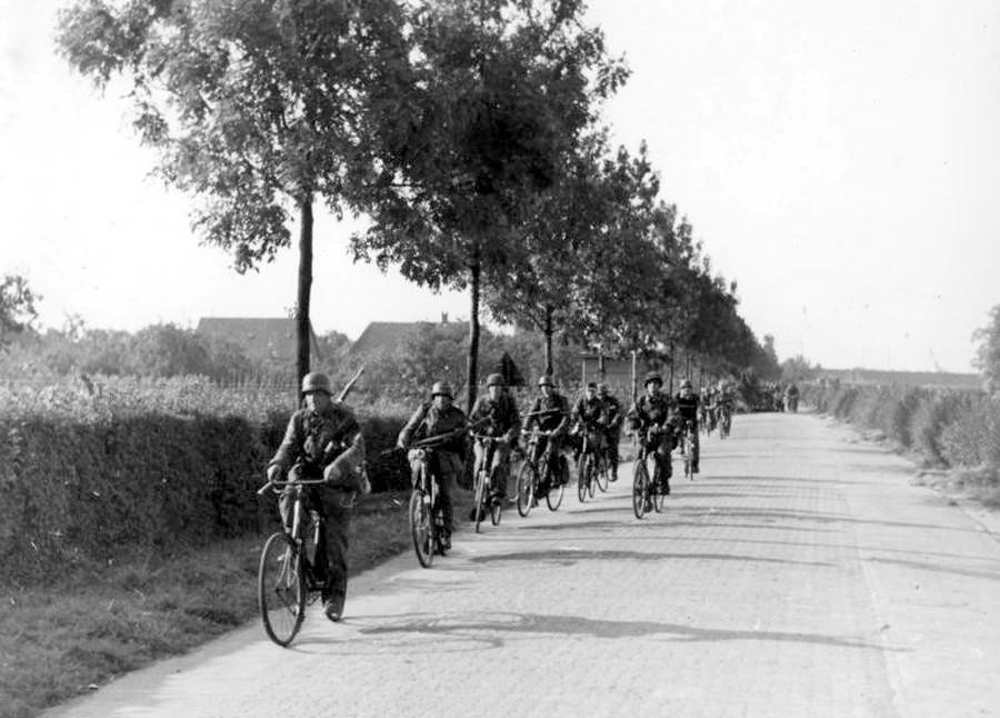
German military on their way from the Pannerden-Doornenburg ferry towards Nijmegen. Source: Bundesarchiv, Bild 183-S73823 / CC-BY-SA 3.0
From this Tuesday afternoon onwards, the German artillery started firing systematically at the perimeter around the bridge, destroying building by building. Moreover, it was attempted to set fire to the buildings by phosphorus shells so the British just had to evacuate them. It goes without saying this caused severe losses among John Frost’s men.
During the bombardments, German snipers positioned themselves in such a way that the freedom of movement of the British was limited even more. Nonetheless, the British managed to repulse one attack by infantry and armored vehicles after the other.
In the evening, Tiger tanks of Kampfgruppe Brinkmann appeared around the bridge and attacked the northeastern sector. Even after this, the British were forced to give up only one position, that of RAOC Troop van de 1st Airborne Divisional Field Park.
At nightfall, the Germans pulled back to their starting positions although artillery and mortar bombardments continued throughout the night. John Frost managed to hold the bridge but his strength diminished little by little and shortage of ammunition and food became troublesome for the men.
Definitielijst
- Abteilung
- Usually part of a Regiment and consisting of several companies. The smallest unit that could operate independently and maintain itself. In theory an Abteilung comprised 500-1,000 men.
- Brigade
- Consisted mostly of two or more regiments. Could operate independently or as part of a division. Sometimes they were part of a corps instead of a division. In theory a brigade consisted of 5,000 to 7,000 men.
- Browning
- American weapon’s designer. Famous guns are the .30’’ and .50’’ machine guns and the famous “High Power” 9 mm pistol.
- cannon
- Also known as gun. Often used to indicate different types of artillery.
- Cavalry
- Originally the designation for mounted troops. During World War 2 the term was used for armoured units. Main tasks are reconnaissance, attack and support of infantry.
- Division
- Military unit, usually consisting of one upto four regiments and usually making up a corps. In theory a division consists of 10,000 to 20,000 men.
- Fallschirmjäger
- German paratroopers. Part of the Luftwaffe.
- Flak
- Flieger-/Flugabwehrkanone. German anti-aircraft guns.
- Infantry
- Foot soldiers of a given army.
- Kampfgruppe
- Temporary military formation in the German army, composed of various units such as armoured division, infantry, artillery, anti-tank units and sometimes engineers, with a special assignment on the battlefield. These Kampfgruppen were usually named after the commander.
- Luftwaffe
- German air force.
- mortar
- Canon that is able to fire its grenades, in a very curved trajectory at short range.
- offensive
- Attack on a smaller or larger scale.
- PIAT
- Projector Infantry Anti-Tank. British anti-tank weapon, used by infantry troops. It has the shape of a rifle and is based on the rifle principle. A PIAT can be reloaded.
- POW
- Prisoner of War.
- RAF
- Royal Air Force. British air force
- Regiment
- Part of a division. A division divided into a number of regiments. In the army traditionally the name of the major organised unit of one type of weapon.
- resistance
- Resistance against the enemy. Often also with armed resources.
- Squadron
- A military unit in the Belgian navy usually six to eight small ships operating together under one command. The smallest military unit in the Dutch air force of about 350 men. In most countries is the designation of a military unit thesize of a company. It is either an independent unit, such as a battery, or part of a bigger Calvary unit. In the air force it is the designation of a unit of aircrafts.
- Waffen-SS
- Name of Military section of the SS.
Wednesday September 20, 1944
Ground Attack
On Wednesday, September 20, the Germans attacked the approaches to Nijmegen and the supply routes in Noord-Brabant, seriously jeopardizing the delivery of food and supplies. Meanwhile, they also stepped up their attacks in the direction of Nijmegen. At 06:30, three groups advanced on Nijmegen. Kampfgruppe Becker took the road Beek-Nijmegen to Neerbosch while Kampfgruppe Hermann moved towards Hatert and Hees via Mook and Malden. Finally, Kampfgruppe Greschick drove via Groesbeek in the direction of the Meuse-Waal canal.
Despite these counterattacks, another attempt was made in the afternoon to capture the Waal bridges. This time, it was decided to have part of the troops, in this case 3rd Battalion commanded by Major Julian A. Cook, 504th PIR, ferry across the Waal in assault boats near the PGEM power plant. In the evening of September 19, the unit had left Grave on their way to Nijmegen and had settled down in the Jonkerbos at 21:15. Major Julian had wait for the boats however. As they had to be transported all the way from Belgium, the crossing could take place no earlier than September 20. The attack was to be launched at 14:00 and simultaneous attacks were launched on the ramps of the road bridge and the railway bridge. Eventually 3rd Battalion received 26 boats and the crossing could begin at 15:03. The boats would be crewed by C Company commanded by Captain Wesley D. Harris of 307th Airborne Engineer Battalion commanded by Colonel Edwin A. Bedell).
Preparations for the crossing started early on the 20th, with 1st Motorized Battalion, Grenadier Guards commanded by Lt.-col. Edward H. Goulburn together with 2nd Battalion, 504th PIR clearing the terrain in Nijmegen-west, Waterkwartier and Hees of enemies. This enabled 3rd Battalion commanded by Major Julian Cook, 1st Battalion commanded by Major W. Harrison of 504th PIR and Company C, 307th Parachute Engineer Battalion commanded by Captain Wesley Harris to move to their starting positions near the PGEM plant undisturbed. H Company commanded by Captain Carl W. Kappel and I Company commanded by Captain Thomas Moffatt Burriss would make up the first attack wave with H Company going north past Fortress Hof van Holland, to the railway underpass near Lent (now station Lent) and subsequently capture the road bridge. I Company was to advance along the railroad dyke and capture the bridge.
The railway bridge would be attacked from the southern bank of the Waal by Cie/Squadron Groups Column B commanded by Captain John Neville, supported by members of 2nd Company 505th PIR and a few tanks of the Grenadier Guards. This group encountered stiff resistance from Kampfgruppe Hencke around Kronenburgpark and even had to make their way across the roofs of the houses towards the bridge. The road bridge would be attacked from the south by 4th Company, Grenadier Guards commanded by Major H.F. Stanley, King’s Company commanded by Lieutenant Dawson and 2nd Battalion, 505th PIR.
At 14:40, the attack was opened by Hawker Typhoon fighter-bombers of 2 Tactical Air Force equipped with rockets. At 15:00, tanks of No. 2 and No. 3 Squadron, 2nd Armoured Battalion Irish Guards, guns of 376th Parachute Field Artillery Battalion and of 153rd Leicester Yeomanry Field Regiment opened fire on the area where 504th PIR was to come ashore. The crossing began at 15:03.
Despite a smoke screen, the boats came under fire almost immediately from Germans on the far bank. The area was defended by Kampfgruppe Hencke, including engineers from the Reichsarbeitsdienst Fire support was provided by an artillery and an AA battery[83] commanded by Oberleutnant Beck lined up along the Oosterhoutsestraat. Oskar Schwappacher could only deploy his 19. Leichte-Batterie as his heavy guns were fully involved in plastering Nijmegen. Despite heavy losses, H and I Company managed to make it to the far bank and they succeeded in clearing the area of German resistance within a relatively short time.
Fortress Hof van Holland could be captured quickly. Using the cover of the houses and the railroad dyke, the Americans managed to settle down around the railway underpass in Lent. The northern ramp of the railway bridge itself was captured at 17:00 after heavy fighting. About the same time, the southern ramp to the bridge had been secured. The German troops in the area felt cornered and attempted to reach the bridge from the north bank. They were unaware that this had already been captured by 504th PIR. The fleeing Germans ran into a barrage from the north and south side. The number of German casualties has never been determined precisely but based on eyewitness reports, the conclusion can be drawn that there were possibly more German casualties on the railway bridge than on the road bridge.

The only picture, probably taken on September 20, of the crossing of the river Waal. A boat returning to the power plant. Source: Wilco Vermeer collection
At 15:30, the attack on the southern ramp of the road bridge got under way. No 4 Company, Grenadier Guards commanded by Major H.F. Stanley moved via Kelfkensbos in the direction of the bridge in support of the attack by King’s Company commanded by Lieutenant Dawson which advanced via Kelfkensbos and Jorisstraat to Hunnerpark. Meanwhile, 2nd Battalion 505th PIR entered Keizer Lodewijkplein and disabled the nasty 88mm gun and three of the four light tanks.
At around 18:00 four of the six tanks of No. 1 Troop, 1st Squadron, 2nd Battalion Grenadier Guards of the Guards Armoured Division drove onto the bridge. Two of them were knocked out but two others managed to reach the concrete barrier on the northern side. The scout car of Lieutenant Tony Jones of 14th Field Squadron, Royal Engineers was right behind them. They immediately started to remove all fuses, wiring, etc. of all explosives they discovered on the bridge. One tank remained at the concrete barrier while the other drove on to the railway underpass near Lent. Further advance proved impossible as right past the underpass, a German anti-tank gun was strategically deployed. Without considerable support by infantry, further advance was impossible. Sometime later, Major Peter Carrington followed in his command tank and H.J. Mitchell arrived on the north side from Nijmegen in his recce Humber scout car.
Contrary to the order from his superior, Feldmarschal Walter Model, the commander of 10. SS-Panzer-Division SS-Brigadeführer Heinz Harmel had decided to prepare the road bridge at Nijmegen to be blown with explosives as soon as the Allies threatened to capture it. An attempt at blowing the bridge failed however. For reasons unknown until today, the charges failed to explode.
Towards 19:15 men of 504th PIR[84] who had crossed the Waal in boats, had also reached the northern ramp of the bridge, ending all German resistance there with the bridge firmly in Allied hands. A small bridgehead had been established from Fort Hof van Holland via the underpass in Lent to a few hundred yards from the road bridge. Further expansion of the bridgehead was planned on the next day, starting at 09:00. Nonetheless, fighting in Nijmegen was far from over. Until the early hours of the morning, British infantry was fighting small groups of Germans and could therefore not be sent in support of the tanks on the bridge.
On German side, at about 22:30, Karl-Heinz Euling even managed to escape with some 60 men through the underpass of the road bridge and the Ooijpolder. With a few small rowing boats he subsequently managed to reach Haalderen on the far bank. Leo Reinholdmanaged to reach safety via the dyke to Bemmel. Heinz Harmel and Leo Reinhold had immediately ordered from Bemmel to set up an anti-tank position half way on the road between Elst and Lent. A new defensive line was established from Oosterhout via Ressen to Bemmel. This enabled them to deploy SS-Panzergrenadier-Regiment 22 and II. Abteilung, SS-Panzer-Regiment 10 near Bemmel. The latter unit had crossed the river at Pannerden and was on its way to Bemmel with 16 Panther tanks.
Meanwhile, the Welsh Guards had been added to 82nd Airborne Division as reserve and were sent to Molenhoek. They arrived at 17:30 to support 1st Battalion 505th PIR in trying to stop Kampfgruppe Hermann near Mook. At 18:15, they received the message to attack the village. At the railway underpass between Molenhoek and Mook, they managed to repulse German attacks; one of the British tanks struck a mine and another was destroyed by the Germans. Subsequently, the Coldstream Guards were ordered to assist the paras and the Welsh Guards but the enemy was defeated before they could join the battle. During the evening, 1st Battalion 505th PIR managed to clear Mook with help from tanks of the Coldstream Guards and their own artillery, pushing the enemy further back. This way, the threat to the bridge at Heumen was warded off.
508th PIR had their work cut out for them that day, defending the approaches to the landing zones near Beek and they were supported by tanks of the Sherwood Rangers. Dug in on the slopes between Beek and Berg en Dal, they managed to repulse German attacks. A Company, commanded by John P. Foley waged a battle just as heavy around the Duivelsberg. Although a tank was dispatched to support them, it soon had to return to Beek as it was more urgently needed there.
Kampfgruppe Becker managed to push through to Beek, Kampfgruppe Greschick to Groesbeek and Kampfgruppe Göbel to Mook. The latter was assisted by Kampfgruppe Hermann which managed to recapture Plasmolen and Riethorst. The assistance of the tanks had come at the right moment for the Americans, enabling them to stop the German counterattacks but the situation remained precarious. Not until the next day would the Allies control the situation east and south of Nijmgen.
On the flank of XXX Corps, XII had just reached the line Retie-Postel-Bladel-Wintelre.[85] On the flank of VIII Corps, 3rd Infantry Division had liberated Achel, Hamont and Budel and later that day they managed to recapture Maarheeze from Kampfgruppe Heinke. XXX Corps’ corridor itself was cut off once again on September 20 by Panzer-Brigade 107 with supporting forces, once more causing delay in the delivery of men and supplies to Nijmegen.
After the Allies had managed to repulse an attack by Panzer-Brigade 107 on the bridge near Son on September 19, the next day at 06:15 an attempt was made again to capture or destroy it. The Brigade and its supporting troops left Nuenen and ran into the Allied defensive line between Esp and Son. Despite the ensuing fierce battle and the excellent defense, eight German tanks managed to get close to the bridge. There they met resistance by the Cromwell tanks of 15th/19th Hussars. A real tank battle erupted near the mill in Esp. This battle caused the corridor to be cut off for more than seven hours though.
Oosterbeek
The situation around the landing zones and in Arnhem had deteriorated to such an extent that Major General Roy Urquhart felt compelled to change tactics. It had become clear that in a short time the rest of 1st Airborne Division couldn’t possibly advance on Arnhem any further. His first decision was that Lt.-col. John Frost would be on his own at the bridge until the arrival of XXX Corps. Roy Urquhart contemplated the idea that if the bridge would fall into German hands, Market Garden could still turn into a success provided he managed to hold a bridgehead on the north bank of the river with the rest of his division. Should XXX Corps arrive, a bridge could be constructed across the Lower Rhine. To this end, he selected Oosterbeek and ordered all remnants of his division to go there.
This wasn't as easy as he thought because many of his troops were still engaged in fighting the Germans in the areas between Arnhem, Wolfheze and Ede. 1st Battalion The Border Regiment had already taken position in the woods west of Oosterbeek and their line would become the western defense of the perimeter. The eastern line was still entirely unmanned. Only riflemen of the Light Regiment and a group of glider pilots were near the church in Oosterbeek. The medical staff had taken residence in Hotel Schoonoord at the junction of Utrechtseweg and Stationsweg. This undefended staff was already taken prisoner on Wednesday by a German patrol which drew back however in fear of British troops in the vicinity.
In the course of this day, gradually more and more units arrived in Oosterbeek. In the east, the remnants of 1st Parachute Battalion, 3rd and 11th Parachute Battalion and 2nd Battalion The South Staffordshire Regiment, settled down with which an entire battalion could be created in terms of strength. The group had been assembled by Lt.-col. William Francis Kynaston Thompson and Major Robert Henry Cain, the highest ranking officer present, tasked him with organizing the defense with these men. William Thompson went to HQ to arrange supplies and was accompanied by a new commander in the person of Major Richard Thomas Henry Lonsdale This ad hoc unit was given the temporary name of Lonsdale Force. Soon, this force would have to defend itself against troops of Kampfgruppe Spindler. During the ensuing battle, it was Lance Sergeant John Baskeyfield who as the sole survivor of his gun crew, countered attacks by German armored vehicles. He paid the ultimate price for this action. Despite the fierce fighting, Lonsdale Force managed to hold its sector. Under continuing German pressure though, they had to retreat ever further towards the church of Oosterbeek and its surroundings. Together with the Light Regiment of William Thompson, they attempted to hold the Germans at bay.
4th Parachute Brigade was also on its way to Oosterbeek from the west. At 13:10, 10th Parachute Battalion was the first to enter the perimeter although a large part of its strength had been lost. Brigade HQ and 156th Parachute Battalion suffered heavily during their withdrawal due to the continuous fighting against the Germans. Lt.-col. Richard Des Voeux was killed in the process and Brigadier John Hackett took temporary command of the battalion. Eventually, they managed to break out of their encirclement, falling back within the positions of A Company and 1st Battalion The Border Regiment.
B Company of 7th Battalion The King’s Own Scottish Borderers had spent the night in Hotel Wolfheze and was reinforced by a small part of 156th Parachute Battalion that had ended up there. In the afternoon, Major Michael Foreman led his troops to the southwest, hoping to join others. They stumbled straight onto a German line and were all taken prisoner.
On September 20, most remnants of 1st Airborne Division fell back on Oosterbeek in smaller or larger groups. Out of the 10,000 strong 1st Airborne, some 3,600 were deployed in and around Oosterbeek. With shortages of ammunition and supplies, Roy Urquhart tried to set up a defense as well as it went. The western side of the perimeter was defended by 1st Battalion The Border Regiment at almost full strength, supported by glider pilots and Royal Engineers. 7th Battalion King's Own Scottish Borderers had a firm grip on the northern side with the Reconnaissance Squadron covering their backs. On the left flank, the lineup consisted of the Independent Company and the remnants of 4th Parachute Squadron. The entire sector was commanded by Brigadier Philip Hicks.
The eastern sector was reorganized by Brigadier John Hackett with various groups of paratroops with Lonsdale Force in the south, supported by the guns of 1st Airlanding Light Regiment. Between the former and the Lower Rhine there was a patch of undefended land not easily accessible which could be covered by machineguns and patrols. The junction of Utrechtseweg and Stationsweg was defended by 10th Parachute Battalion with 156th Parachute Battalion along the Stationsweg to the north of them. Between them, two Squadrons of Glider Pilot Regiment and 250th Light Composite Company were lined up. Roy Urquhart established his Divisional HQ permanently in Hotel Hartenstein. His orders were simple: hold the enemy at bay until the arrival of XXX Corps.
Throughout the day, in particular 1st Battalion The Border Regiment was hit hard being attacked by Kampfgruppe Von Tettau. Around 10:00 A Company was subjected to a ferocious attack by infantry and a self-propelled gun. C Company came under heavy pressure and had to give up several positions. In strong counterattacks, they managed to recapture most of those positions and when an anti-tank gun knocked out the enemy weapon, the Germans retreated.
It was relatively quiet in the sector of 7th Battalion The King’s Own Scottish Borderers. A patrol managed to ambush two German tanks and knock out one of them with their anti-tank guns. Meanwhile, Roy Urquhart had managed to contact the leadership of XXX Corps and had arranged that the Polish paratroops wouldn't be dropped south of the road bridge but near Driel. After all, Major General Stanislaw Sosabowski and his 1st Polish Independent Parachute Brigade Group hadn't been transported to the battlefield yet owing to fog in England. The drop would take place this afternoon. The Poles were now to land near Driel and then use the ferry Driel-Heveadorp to cross the river to Oosterbeek. Due to bad weather however, the drop was postponed for 24 hours again.
An attempt by the RAF to deliver supplies to 1st Airborne Division with 160 Short Stirling bombers and Douglas C-47 transport planes went ahead as planned. In the days before, the transports had dropped their loads near the Germans, as they were unaware that the drop zones were already in German hands. Divisional HQ had managed on Wednesday to contact the outside world and the RAF would drop the supplies within the perimeter. Yet, within the RAF, things were still unclear and 33 aircraft dropped their loads over LZ-L which was in German hands. Yet, about half of all the supplies did fall into British hands.
The Bridge at Arnhem
Although the bridge at Arnhem was still in British hands, shortages of food, water and ammunition began to create serious problems. As the troops were completely cut off from the outside world, the outcome of the battle became obvious. Without a breakthrough from outside, the bridge had to be given up. At dawn, German snipers and machinegun crews had taken up positions around the bridge in such a way that they could cover the entire perimeter. These particular positions had been selected so the British on either side of the ramp got isolated from each other. With artillery and mortar fire raining down relentlessly on the British, the Germans continued to launch combined attacks by infantry and armor. Infantry attacks could still be repulsed with relative ease by the British but the German armor enjoyed an almost free hand.
John Frost managed to establish a short radio contact with Roy Urquhart in which it was explained to him he couldn't expect any help from the rest of 1st Airborne Division; the only rescue for John Frost and the rest of the battalion being the arrival of XXX Corps. In the course of the battle, Lt.-col. John Frost and Major Doug Crawley of B Company, 2nd Parachute Battalion became so seriously injured that John Frost felt compelled to relinquish command to Major Freddie Gough of the Reconnaissance Squadron. Meanwhile, the perimeter grew smaller and smaller and it was decided to pull all available men back to the positions of 1st Parachute Battalion HQ. From here they could still cover the bridge and concentrate all firepower on the surroundings. Nonetheless, it didn't prevent the Germans from sending armored vehicles across the bridge. Right at that moment, a few miles to the south, British tanks started to cross the bridge at Nijmegen.
To John Frost and Freddy Gough it became clear that further resistance would only cause unnecessary bloodshed. It was decided to negotiate with the Germans to evacuate all wounded, including John Frost, from the battlefield and into imprisonment. A cease-fire of two hours was agreed upon in which the wounded were taken away in a joint British-German operation. Major Digby Tatham-Warter took command of the remaining troops and after the evacuation, the artillery and mortar barrage was resumed as if nothing had happened. Major Tatham-Warter split his troops, ordered them to seek cover and only resume the fight whenever possible.
Definitielijst
- Abteilung
- Usually part of a Regiment and consisting of several companies. The smallest unit that could operate independently and maintain itself. In theory an Abteilung comprised 500-1,000 men.
- Brigade
- Consisted mostly of two or more regiments. Could operate independently or as part of a division. Sometimes they were part of a corps instead of a division. In theory a brigade consisted of 5,000 to 7,000 men.
- Division
- Military unit, usually consisting of one upto four regiments and usually making up a corps. In theory a division consists of 10,000 to 20,000 men.
- infantry
- Foot soldiers of a given army.
- Kampfgruppe
- Temporary military formation in the German army, composed of various units such as armoured division, infantry, artillery, anti-tank units and sometimes engineers, with a special assignment on the battlefield. These Kampfgruppen were usually named after the commander.
- mine
- An object filled with explosives, equipped with detonator which is activated by either remote control or by colliding with the targeted object. Mines are intended to destroy of damage vehicles, aircrafts or vessels, or to injure, kill or otherwise putting staff out of action. It is also possible to deny enemy access of a specific area by laying mines.
- mortar
- Canon that is able to fire its grenades, in a very curved trajectory at short range.
- RAF
- Royal Air Force. British air force
- Regiment
- Part of a division. A division divided into a number of regiments. In the army traditionally the name of the major organised unit of one type of weapon.
- resistance
- Resistance against the enemy. Often also with armed resources.
- Squadron
- A military unit in the Belgian navy usually six to eight small ships operating together under one command. The smallest military unit in the Dutch air force of about 350 men. In most countries is the designation of a military unit thesize of a company. It is either an independent unit, such as a battery, or part of a bigger Calvary unit. In the air force it is the designation of a unit of aircrafts.
- Waffen-SS
- Name of Military section of the SS.
Thursday September 21, 1944
The Waal bridge and the Betuwe
The capture of the Waal bridges enabled XXX Corps to send troops into the Betuwe. The day before, the advance had been aborted as only a few British tanks had crossed the river and the Germans had established a defensive line with anti-tank guns right after the underpass at Lent.
Meanwhile, the Germans had been able as well to send a considerable defense force into the Betuwe. Initially by the ferry at Pannerden and during the 21st also via the recaptured Rhine bridge at Arnhem.

September 21,1944, 2nd Battalion, The Welsh Guards moving into the Betuwe. Source: Imperial War Museum
After having spent the night in the bridgehead near Lent, Carrington’s tanks returned to Nijmegen in the early morning. They were relieved by tanks of 2nd Armoured Battalion Irish Guards and 3rd (Infantry) Battalion Irish Guards which took up position for an outbreak towards Arnhem. They had crossed the bridge at 03:00. 153rd (Leicester Yeomanry) Field Regiment, Royal Artillery, dispatched eight motorized 25lbs guns to provide fire support for the advance which would be led by 2nd Battalion Irish Guards. The Griftdijk from Lent to Elst was selected for the advance. It was known that near station Ressen-Bemmel, six 88mm guns were deployed and the German had established a line to block the road to Elst. To this end, infantry and artillery had been assembled along Stationsstraat from Ressen to Oosterhout. This line connected with a hastily constructed defensive line with 1.5 battalion SS-Panzergrenadier-Regiment 22 south of Bemmel, one battalion SS-Panzergrenadier-Regiment 21 near De Heuvel north of Bemmel and remnants of Kampfgruppe Euling near Haalderen, II. Abteilung, SS-Panzer-Regiment 10 near Bemmel and 1. Kompanie, SS-Panzer-Pionier-Abteilung 10 were deployed east of Bemmel.
De 5. Fallschirmjäger-Kompanie commanded by Oberst Johann Hemsoth and remnants of Kampfgruppe Hartung were located northeast of Bemmel between De Heuvel and the Aam. The remnants of Gräbner’s forces, now commanded by SS-Hauptsturmführer Karl-Heinz Recke were in Elst. Kampfgruppen Hemsoth and Hartung were located near De Heuvel and Ressen. As to fire support, the German troops could count on III. and IV. Abteilung, SS-Panzer-Artillerie-Regiment 10 near Pannerden and Angeren. II Abteilung of the same regiment was stationed in Flieren and was under direct command of SS-Sturmbannführer Fritz Haas, the commander of the regiment. SS-Panzer-Flak-Abteilung 10 was also deployed near Doornenburg. The entire defensive screen was manned on the eastern side by troops allocated to V. Abteilung, SS-Artillerie-Ausbildungs und Ersatz-Regiment commanded by Oskar Schwappacher which was stationed near Oosterhout.
At 13:00 near the underpass in Lent, No. 1 Squadron commanded by Major Michael James Palmer O’Cock, followed by No. 2 Squadron commanded by Major Edwin G. Tyler with the men of No. 4 Company commanded by Major John S.O. Haslewood had arrived. No. 3 Squadron commanded by Major Desmond Fitzgerald came close behind, transporting men of No. 2 Rifle Company commanded by Major Alec Hendry. Finally No. 1 Company, 3rd Battalion Irish Guards was behind them and were transported on trucks. After an artillery barrage, the advance started at 13:30.[86] Everything went well until they reached Groenestraat. Between Groenestraat and Stationsstraat, the column came under German fire. The three leading tanks were knocked out immediately by anti-tank guns and the accompanying infantry came under fire as well. The German line proved very strong. Here, the Germans had deployed the feared 88mm gun, 75mm AA guns and 20mm self-propelled guns.
The destroyed tanks blocked the passage and the tanks behind them were unable to deliver accurate fire. The stranded British didn't manage to receive air support because of the failing radio equipment. They received artillery support as late as 17:00. At 19:00 the order was given to retreat in the direction of Lent and wait for reinforcement by infantry.
43rd (Wessex) Division commanded by Major General Gwilym Ivor Thomas was ordered to move into the Betuwe. However, they were still between Grave and Nijmegen, delaying the advance even more. The stranded Guards near Lent/Oosterhout had an almost front row view of a spectacle that was unfolding during their battle. At 17:20 the landing of the 1st Polish Independent Parachute Brigade Group commanded by Major General Stanislaw Sosabowski) began.
Landing of the Polish Brigade
Once again, things went wrong at takeoff in England: 41 transport planes had to return owing to bad weather. The rest landed around 17:20 near Driel. The landing site was located a little east of Driel, between Driel and the road from Elst to Arnhem. On landing the Poles were almost immediately subjected to fire. The arrival of the air armada had been spotted by the Germans and they sent various fighters into the air. Messerschmitt Me 262 jet fighters of II. Jagdkorps, Luftflotte 3[87] were among the first to attack the transports. Flak guns around Arnhem and Elst, reinforced by Flak-Abteilung Von Svoboda Oberstleutnant Hubert Edler von Svoboda) and Artillerie-Regiment 191 joined the defensive fire.
Wilhelm Bittrich reacted immediately to the new air landings and quickly regrouped his forces in the Betuwe. He had a defensive line established east of the railway Arnhem-Nijmegen.
This line, called Sperrverband Harzer was manned by Kampfgruppe Krafft north of the Lower Rhine and in the south, from north to south by Battalion Schörken commanded by Hauptmann Otto Schörken, 14. Schiff-Stamm-Abteilung commanded by Fregattenkapitän Hauth, Festungs(MG)-Bataillon 41 and III. Bataillon, SS-Grenadier-Regiment Landstorm Nederland commanded by SS-Oberturmbannführer Hermann Delfs. Command of this line was given to Oberst Egon Gerhard of Panzergrenadier-Ausbildungs und Ersatz-Regiment 57. Battalion Schörken was taken from 116. Panzer-Division, to be more precise Panzergrenadier-Ersatz und Ausbildungs-Bataillon 60. Gerhard himself established his HQ in Elden. Tanks of 5. Kompanie, SS-Panzer-Regiment 9 were added to the Sperrverband for reinforcement. Sperrverband Harzer wasn't fully operational on September 21, as some units had to be brought in from elsewhere or were still fighting but would take shape in the days to come and be reinforced further. At a later moment, an SS-Sicherungs-Kompanie and Festungs(MG)-Bataillon 37 would be added.
Once on the ground, the Poles managed to regroup relatively easy nonetheless. 3rd Parachute Battalion went straight for its target along the bank of the Lower Rhine and 2nd Parachute Battalion headed towards the ferry Driel-Heveadorp. On arrival at the site, there was no ferry in sight. Stanislaw Sosabowski hadn't been informed yet that during the battle on the far side, the ferry landing had fallen into German hands and so the Poles were subjected to fire almost immediately. Later on, it transpired that the captain of the ferry, realizing that the Germans had captured the Westerbouwing, had scuttled his vessel to prevent the Germans from using it, like they had done in Pannerden.
Major general Roy Urquhart had watched the landing from Oosterbeek but couldn't make radio contact. He had suggested this location so the Poles could reinforce his troops in Oosterbeek.[88] His Polish liaison officer, Captain Ludwik Zwolanski, offered to swim across the river to take a message to Stanislaw Sosabowski. It read that Urquhart would make an attempt to capture the Westerbouwing and the ferry in the north and that he had rafts made to take the Polish vehicles across. The recapture failed and construction of the rafts took longer than expected. On Polish side, means were discussed to cross the river. This attempt also failed and Sosabowski had his brigade prepare Driel for defense during the night.
Arnhem
Around noon,[89] the last British resistance at the Rhine bridge in Arnhem was cleared by Kampfgruppen Brinkmann and Knaust. The Germans gained full control of the bridge again. Kampfgruppe Knaust was ordered to cross the bridge immediately and they were soon followed by other units. During the battle of the bridge, Schwere Panzer-Kompanie Hummel with PzKpfw VIb Königstiger and I. Bataillon, SS-Panzergrenadier-Regiment 21 had played the decisive role and could now be deployed in the Betuwe. At 16:15, Kampfgruppe Knaust moved into the Betuwe and drove via Elden to Elst. Meanwhile, the Kampfgruppe had grown into a formidable striking force. I. Abteilung, SS-Panzer-Regiment 9 with Panther tanks and self-propelled guns had been added in addition to Schwere Panzer-Kompanie Hummel commanded by Hauptmann Hanz Hummel with Tiger tanks. Finally, a remnant of Viktor Gräbner’s unit and 3. Kompanie, Panzergrenadier-Regiment 21 was added to the Kampfgruppe.
Kampfgruppe Knaust arrived in Elst around 17:00 and by the early evening they had reached Ressen. Immediately, the unit took over the Sperrlinie from the forces already there. Major Hans-Peter Knaust didn't dismantle it but reinforced it with his own troops and tanks. 5. Panzer-Kompanie of Oberleutnant Wilhelm Mielke was sent to Oosterhout a little west from Lent to defend this village. The main body of the Kampfgruppe retreated to Elst. Hans-Peter Knaust considered the terrain between Elst and Lent unsuitable for his tanks to maneuver in. In case the Allies should advance on Arnhem, he was convinced they would do so via Elst. Therefore he saw to reinforcement of the existing Sperrlinie near Ressen and established his main defense in Elst. In order to be able to provide the necessary artillery support to Kampfgruppe Knaust and Sperrverband Harzer, a detachment of Artillerie-Regiment 191 commanded by Hauptmann Karl Baan, Flak-Abteilung Von Svoboda and SS-Werfer-Abteilung 102 of SS-Nebelwerfgruppe Nickmann commanded by SS-Hauptsturmführer Alfred Nickmann were deployed near Elden and Rijkerswoerd.[90] Kampfgruppe Brinkmann SS-Panzer-Aufklärungs-Abteilung 10, commanded by SS-Sturmbannführer Heinz Brinkmann were deployed between Sperrverband Harzer and Kampfgruppe Knaust
Oosterbeek
At the Rhine bridge in Arnhem, the situation on Thursday September 21, had deteriorated to such an extent that hostilities were ended. Around noon that day,[91] the Germans regained the entire bridge undamaged and could use it unhindered to further reinforce their troops in the Betuwe.
The end of resistance at the Rhine bridge enabled the remaining German troops in Arnhem to fully concentrate on the British 1st Airborne Division which had been pushed back to Oosterbeek.
At Oosterbeek German troops had started to attack the perimeter. Near Restaurant Westerbouwing, B Company of 1st Battalion The Border Regiment was completely surprised by an attack of the Hermann Göring Regiment. They managed to keep the infantry at bay using Bren guns but under pressure from tanks, they were forced to give up the defense. 1st Battalion The Border Regiment made another three attempts at capturing the Westerbouwing but all three failed. As the Westerbouwing was in German hands, the ferry Driel-Heveadorp was also in their hands and the perimeter had diminished considerably. The connection with the Lower Rhine was under threat of being sealed off as well. Major Charles Breese however established a group, known as Breeseforce including two platoons of A company, 17 Platoon of C Company 2nd Battalion The South Staffordshire Regiment and various paratroops. They managed to set up a strong defense in the direction of the bank of the Lower Rhine. A, C and D Company of 1st Battalion The Border Regiment had come under heavy German artillery and mortar fire as well. A Company came under heavy pressure by German infantry but managed to withstand them during the day and night.
C Company was under threat of being overrun as well but in daring counterattacks they too managed to keep the attackers at bay. D Company, located right next to the Westerbouwing also came under pressure by infantry and tanks but with their anti- tank guns they eventually managed to disable one of the attacking tanks, causing the attackers to withdraw.
Likewise in the eastern sector, Lonsdale Force came under pressure from German infantry and tanks. At the cost of considerable losses, they managed to repulse the attacks, with Major Robert Cain at that moment in command of 2nd Battalion The South Staffordshire Regiment.
In the north, 10th Parachute Battalion was also subjected to heavy counterattacks along the Utrechtseweg. A German attack by a self-propelled gun caused so many victims, the battalion almost ceased to exist as a unit. Most commanders were killed or wounded. Small groups of men, commanded by Captain Peter Roderick MacGregor Barron of 2nd Airlanding Anti-Tank Battery, managed to hold their positions though until Brigadier John Hackett dispatched 21st Parachute Company to take over their positions. Thanks to all this, the German attackers failed to gain important territory.
This day around Hotel Dreijeroord, the last major German attack was launched on the positions of 7th Battalion The King’s Own Scottish Borderers, who had included the building in their defense as the White House. Eventually, the attack was repulsed the next morning as two platoons of 1st Battalion The Border Regiment came to their rescue.
At 16:30 the Germans launched a massive attack by infantry, penetrating deep into the defense of 1st Battalion The Border Regiment which pushed the enemy back in man to man fights. All terrain previously lost could be recaptured. The attacks had demanded so much of them though they were compelled to withdraw to the south a little in order to set up an compact defense. After this, Major General Roy Urquhart decided to bolster his defense and had a few companies which now were endangered, Independent Company and 4th Parachute Squadron, placed in temporary reserve.
Despite the Allied air supremacy, a new supply drop on the perimeter by 117 Short Stirlings and Douglas Dakotas was severely disrupted by Messerschmitt BF 109s and Focke Wulff Fw 190s. Most of the supplies that were dropped fell into German hands.
1st Airborne had a hard day, September 21 but apart from the loss of the Westerbouwing and minor adaptations to improve the defense, the perimeter around Oosterbeek remained largely unscathed. The German losses during their attacks had proved so high, it would influence the tactics of their battles in the days ahead. More serious however were the considerable losses on British side and the gradually dwindling supplies.
Yet, the day did have several bright spots. Divisional HQ had finally managed to establish contact with XXX Corps and 1st Airborne Divisional HQ Royal Artillery was in direct contact with 64th Medium Regiment and 52nd Bedfordshire Yeomanry Heavy Regiment of XXX Corps. As a result of the developments around Nijmegen and the following days in the Betuwe, 64 Medium Regiment would play a role in the battle of Oosterbeek. Along the corridor of XXX Corps in Brabant, the corps managed to push the Germans further back near Sint-Oedenrode. A counterattack near Schijndel by Kampfgruppe Huber was repulsed and Schijndel was captured. A new attack, this time by Kampfgruppe Jungwirth could be repulsed as well. Geldrop and Nederwetten were captured and near Nuenen, Panzer-Brigade 107 was forced to withdraw to Helmond. Under pressure from the Allies there, Berndt-Joachim Freiherr von Maltzahnwas compelled to pull his brigade further back and he was ordered to join Kampfgruppe Walther. VIII Corps managed to cross the Zuid-Willemsvaart and to establish a bridgehead near Someren-Asten where they would face Kampfgruppe Heinke and 7. Fallschirmjäger-Division. Crossing the Zuid-Willemsvaart there turned into an all-out battle for Sluis 11. XII Corps hadn't progressed that far and was still south of Wintelre. All told, the progress of this corridor was still … days behind Montgomery’s master plan.
Definitielijst
- Abteilung
- Usually part of a Regiment and consisting of several companies. The smallest unit that could operate independently and maintain itself. In theory an Abteilung comprised 500-1,000 men.
- Brigade
- Consisted mostly of two or more regiments. Could operate independently or as part of a division. Sometimes they were part of a corps instead of a division. In theory a brigade consisted of 5,000 to 7,000 men.
- Division
- Military unit, usually consisting of one upto four regiments and usually making up a corps. In theory a division consists of 10,000 to 20,000 men.
- Fallschirmjäger
- German paratroopers. Part of the Luftwaffe.
- Flak
- Flieger-/Flugabwehrkanone. German anti-aircraft guns.
- Infantry
- Foot soldiers of a given army.
- Kampfgruppe
- Temporary military formation in the German army, composed of various units such as armoured division, infantry, artillery, anti-tank units and sometimes engineers, with a special assignment on the battlefield. These Kampfgruppen were usually named after the commander.
- Landstorm
- Before 1940 this term designated the various volunteer formations the army in the Netherlands. It was dissolved shortly after the German invasion in May 1940.
- Landstorm Nederland
- During the German occupation a territorial unit of the Waffen-SS quartered in the Netherlands, consisting of mainly Dutch volunteers. Initially established as the Landwacht Nederland in March1943 the name was later changed because another organisation with the same name was established. The Landstorm was deployed against the Allies. At its peak it numbered 8,000 men. It was known as the 34. SS- Freiwilligen-Grenadier-Division Landstorm Nederland. In 1944 a total of 22,000 Dutchmen served in the Waffen-SS.
- mortar
- Canon that is able to fire its grenades, in a very curved trajectory at short range.
- Regiment
- Part of a division. A division divided into a number of regiments. In the army traditionally the name of the major organised unit of one type of weapon.
- resistance
- Resistance against the enemy. Often also with armed resources.
- Squadron
- A military unit in the Belgian navy usually six to eight small ships operating together under one command. The smallest military unit in the Dutch air force of about 350 men. In most countries is the designation of a military unit thesize of a company. It is either an independent unit, such as a battery, or part of a bigger Calvary unit. In the air force it is the designation of a unit of aircrafts.
- Waffen-SS
- Name of Military section of the SS.
Friday September 22, 1944
Betuwe
During the night 43rd (Wessex) Infantry Division commanded by Major General Gwilym Ivor Thomas had arrived in Nijmegen at last. The division was ordered to move into the Betuwe straight away. The infantry was to assist the Irish Guards near Lent/Ressen in breaking through and relieve 1st Airborne Division at Oosterbeek. They were to start their advance at 06:17.
214th Infantry Brigade commanded by Brigadier Hubert Essame would advance via the railway bridge and the Oosterhoutsedijk to Oosterhout and from there to Driel and the Drielseveer. Tank support was provided by C Squadron commanded by Major A.W.P. Peter Herbert) of 2nd Battalion, The Household Cavalry Regiment. 129th Infantry Brigade commanded by Brigadier Gerard H.L. Mole was to advance via the road bridge and the Griftdijk to the Irish Guards near Lent/Ressen and continue northwards to Elst. 130th Infantry Brigade commanded by Brigadier Ben B. Walton was to take up the defense of the Waal bridge while the Dutch Prinses Irene Brigade was to guard the bridge at Grave. The crossing and advance of 214th Infantry Brigade was scheduled for the night but this failed because Somerset Light Infantry (Prince Albert’s) got lost in Nijmegen and ended up on the road bridge instead of the railway bridge.[92]
Driel
Major Peter Herbert deemed it necessary to reach the Poles in Driel as soon as possible and wouldn't wait for Somerset Light Infantry. He attempted to reach the Poles by two routes. No. 4 Troop commanded by Lieutenant D. Corbett attempted to find a route via Bemmel but soon stranded on a German defense line. No. 5 Troop commanded by Captain Richard J. Wrottesley made a detour to the west, the men following the dyke up to Slijk-Ewijk and subsequently by the shortest route via Andelst, Zetten, Indoornik and Heteren to Driel. Without having encountered any resistance, they made contact with the Poles at 08:00. No. 2 Troop commanded by Lieutenant Arthur V. Young took the same route as No. 5 Troop and encountered some German tanks which appeared to be disabled.[93] This wasn't the case though, by sheer luck the reconnaissance vehicles remained undetected by the sleeping Germans. At 09:00, they too managed to reach Driel without any resistance.
The Germans weren’t idle though and Kampfgruppe Brinkmann was the first to launch an attack on the Poles from Elst. At that moment, commander Heinz Brinkmann wasn't aware that they had received reinforcements by the British and ran unexpectedly into Polish paratroops supported by armored vehicles. Heinz Brinkmann was forced to call off his attack and retreated to the east of the railway Arnhem-Nijmegen between Elst and De Laar.
Meanwhile on Polish-British side attempts at realizing a crossing to Oosterbeek continued. As more troops and material could be brought into the Betuwe from Nijmegen, a search was started for a location on the Lower Rhine where a crossing might be made with DUKWs. No. 2 Troop commander Young was given this task and while walking along the river bank during his search, at 13:30 he bumped into Lt.-col. Edward C.W. Myers and Lt.-col. Charles Mackenzie. These two officers on Urquhart’s staff had crossed the river by boat to make contact with the Poles. They were dispatched by Urquhart to convince the British and the Poles that the situation near Oosterbeek had become untenable and that an evacuation was more likely than reinforcement. Convinced of the precarious situation, Brian Horrocks decided to do all he could to realize an evacuation. While the British and Poles were looking for boats and a suitable location for an evacuation, in Nijmegen 5th Battalion, The Duke of Cornwall's Light Infantry commanded by Lt.-col. George Taylor was being prepared, as soon as the situation allowed, to leave for Driel without delay to protect the evacuation. This battalion would be given support by B Squadron commanded by Major David Richards of 4th/7th Royal Dragoon Guards. To this end, first a breach had to be made in the German Sperrlinie It was decided to make use of the attack by 214th and 129th Infantry Brigade that would be launched on September 22.
Oosterhout
No. 1 Troop of C Squadron of 2nd Battalion, The Household Cavalry Regiment had hit the road in the very early morning of September 22, just like the other Troops. On the Waaldijk near Oosterhout, the men were stopped in their tracks by a defense of Mielke with tanks and infantry. Covered by a smoke screen, the reconnaissance unit managed to withdraw supported by tanks of A Squadron commanded by Captain John Stirling, of 4th/7th Royal Dragoon Guards. The Germans defended Oosterhout and lay directly in the path of 214th Infantry Brigade. The advance had to continue nonetheless because this was the flank of the advance of 129th Infantry Brigade via Ressen to Elst and the advance of the Duke of Cornwall’s Light Infantry to Driel.
At 08:30 214th Infantry Brigade launched the attack on Oosterhout. Leading the attack was 7th Battalion the Somerset Light Infantry (Prince Albert’s) commanded by Lt.-col. H.A. Borradaile, followed by 1st Battalion The Worcestershire Regiment commanded by Lt.-col. R.E. Osborne Smith. The Somersets were given fire support by A Squadron, 4th/7th Royal Dragoon Guards. Soon, the attack ran aground on the German defense. Yard by yard, using the numerous ditches in the area, they attempted to get closer to Oosterhout. Progress was halted close to the village and it was decided to request support by heavy artillery. From 15:05 onwards, shells rained down on the German lines. The barrage was shifted to the north every 20 minutes and ended at 16:00. Meanwhile, the Somersets, supported by tanks, moved forward behind this screen of shells. Oosterhout was captured as late as 17:00. The remnants of Mielke’s 5. Panzer-Kompanie withdrew to Elst. At 18:30, the British considered the situation sufficiently safe to send 5th Battalion Duke of Cornwall's Light Infantry on its way to Driel. The troops split into two columns, one moved to Driel via Slijk-Ewijk and Valburg and the second would follow as soon as there was sufficient distance between them. The first column encountered few problems and reached Driel at about 19:00, the second followed at 20:30 with little resistance as well. The troops had to take the cumbersome route via Slijk-Ewijk and Valburg because the attack by the adjacent 129th Infantry Brigade had completely run aground.
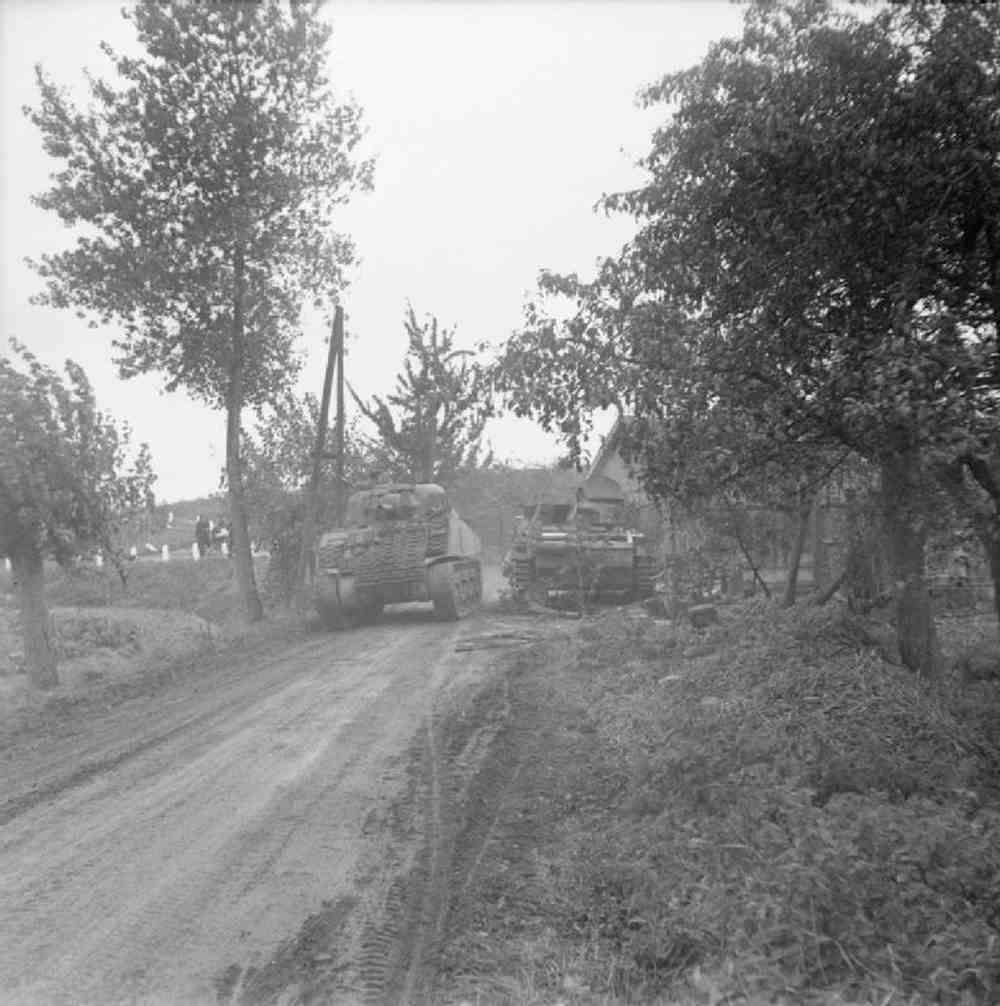
This picture, although taken on September 27, of a Sherman tank of 4th/7th Dragoon Guards, passing a disabled PzKpfw III in Oosterhout, shows a good example of the situation in the Betuwe. Source: Imperial War Museum
129 Infantry Brigade had started its advance at 08:00 and 4th Battalion The Wiltshire Regiment commanded by Lt.-col. E.L. Luce, supported by B Squadron 13th/18th Royal Hussars was to go to Elst. Afterwards, 5th Battalion The Wiltshire Regiment along with 4th Battalion The Somerset Light Infantry would take over the advance in the direction of Arnhem. The advance soon ran aground on the German Sperrlinie along Stationsstraat from Ressen to Oosterhout, the same line at which the Irish Guards had been halted the day before. Meanwhile this line had been reinforced by infantry and Panther tanks. The German tanks were deployed in such a way that passage along the narrow and elevated Griftdijk was impossible. Various British tanks were disabled and the only option was to dig in facing the German line. During the night, an attempt was made to make a flanking movement along the railway dyke but this stranded near Ressen-Bemmel station. The German had managed again to halt the British advance with this Sperrlinie between Ressen and Oosterhout. At this line, nobody was aware yet that the British had already passed Oosterhout.
Oosterbeek
At 07:40, Urquhart received notice that 43rd Wessex Infantry Division had been sent in his direction. The German command meanwhile had come to the conclusion that attacks with infantry and tanks on the perimeter around Oosterbeek, could only succeed at the cost of high losses. It was therefore decided to apply the same tactics as it had done in Arnhem. It began plastering the perimeter with an artillery and bombardment barrage while snipers along the entire line attempted to prevent any freedom of movement. In between many small scale attacks were launched in various locations in order to discover the weak spots in the defense. That this wasn't without danger could be concluded from the fact that many tanks fell victim to the well-deployed anti-tank guns and the clever use of PIAT’s in and around the perimeter. Meanwhile, Bittrich issued the order to the effect that the British in Oosterbeek were to be attacked once more this day.
The battle in Oosterbeek by the remnants of 1st Airborne Division had meanwhile turned into a fight for survival, hoping to evacuate as many men as possible. Kampfgruppe Von Tettau was situated around the gas works along Van Borsselenweg to the north. Joining this, Kampfgruppe Bruhn along with II. Bataillon, Sicherheits-Regiment 908 commanded by Major Junghans continued in the direction of Oosterbeek. Kampfgruppen Spindler and Möller were situated east of Hotel Schoonoord in town. Kampfgruppen Von Allwörden, Harder and Weber were steadily approaching through the forelands and along Benedendorpseweg. The ring around Oosterbeek threatened to snap shut and the area where the British were still fighting diminished gradually.
In order to be able to withstand the British near Oosterbeek and the Poles in Driel as well as the British threat form Nijmgen, Wilhelm Bittrich drew a new dividing line in the German defense. Kampfgruppe Harzer of 9. SS-Panzer-Division was put in command of the northwestern and 10th. SS-Panzer-Division of the northeastern front. All troops in the area were placed under command of these divisions. The line stretched from Valburg-Noord, via Elst-Noord, Rijkerswoerd and Klein Holthuizen near Westervoort to the river IJssel.
Around 21:00 the Poles tried to ferry men and equipment across, supported by units of 5th Battalion Duke of Cornwall's Light Infantry. On the far side of the Lower Rhine, they were assisted by 9th Field Company, Royal Engineers and No. 3 Troop, 4th Parachute Squadron RE commanded by Captain Henry F. Brown. The crossing however lay in full view of German units. Yet, the Poles managed to get 52 paras across who could join the British in Oosterbeek. At 03:00 further attempts had to be cancelled as towards this time, the available boats had suffered too much damage.
XXX Corps Corridor halted again
Meanwhile, the Germans in Brabant and Limburg hadn't been idle. The corridor of XXX Corps had to be attacked again. On September 22, the option had been selected of a concentrated attack with the capture of Veghel, blocking the British route of advance and the destruction of the bridges across the Zuid-Willemsvaart as the targets
On the eastern side of the corridor, Kurt Student had LXXVI. Armeekorps commanded by General der Infanterie Hans von Obstfelder at his disposal. This corps had 7. Fallschirmjäger-Division commanded by Generalleutnant Wolfgang Erdmann at his disposal as well as 176. Infanterie-Division commanded by Oberst Christian-Johannes Landau) and Kampfgruppe Walther.
West of the corridor, LXXXVII. Armeekorps commanded by Hans-Wolfgang Reinhard with Kampfgruppe Chill was stationed as the major unit. Kampfgruppe Walther had been fully reorganized with Panzer-Brigade 107, I. Bataillon, Fallschirmjäger-Regiment ( Hellmut Kerutt), 1. Kompanie, Grenadier-Ersatz und Ausbildungs Bataillon 16, Abteilung of Artillerie-Regiment 180, SS-Infanterie-Bataillon Richter (Kampfgruppe Heinke) and SS-Sturmgeschütz-Abteilung 10 commanded by SS-Sturmbannführer Erwin Röstel. The defense of this area was made up by 1st Battalion (Lt.-col. Harry Kinnard), 501st Parachute Infantry Regiment in Schijndel. Close to Schijndel lay 3rd Battalion commanded by
Lt.-col. Julian Ewell of the same regiment. 1st Battalion commanded by Lt.-col. Robert A. Ballard was kept in Veghel as reserve. 502nd PIR was deployed in Sint-Oedenrode and 506th PIR in Eindhoven and near Son. As British troops could replace the Americans in Eindhoven and Son, 506th PIR was sent to Uden where a small group arrived at 10:25. From Uden, they could see the corridor being blocked by German tanks. Hence, 2nd and 3rd Battalion were unable to get beyond Veghel. The small strike force in Uden prepared the village for defense right away and the rest did likewise in and around Veghel.
What had happened? At 09:00 the intended German attack was unleashed. Kampfgruppe Walther with Panzer-Brigade 107 leading the way, advanced to the road Veghel-Uden via Erp and on to Veghel. The troops were flanked by SS-Infanterie-Bataillon Richter and Grenadier-Ersatz und Ausbildungs-Bataillon 16. The bridge across the Aa was quickly secured and troops were sent on to Uden. Meanwhile, Kampfgruppe Huber advanced to the road Sint-Oedenrode and Veghel. As early as 11:00 Kampfgruppe Walther approached Uden and Panzer-Brigade 107 blocked the road between Veghel and Uden. In the meantime, SS-Bataillon Richter was approaching Veghel. Near Uden the Americans managed to repulse the German attack, causing the enemy to move towards Veghel. At Veghel, the Americans succeeded in repulsing the attack as well. The Germans moved between the lines though and at around 13:00 they blocked the corridor near Mariaheide. In order to counter this threat, XXX Corps was obliged to call back reinforcements from Nijmegen in the form of the 32nd Guards Brigade, commanded by Brigadier George F. Johnson. He sent parts of the Grenadier Guards Group and 5th Battalion Coldstream Guards back to the area Veghel – Uden.
Towards 14:00 Kampfgruppe Huber approached the Americans in Veghel and attempted to capture or destroy the bridge on the Zuid-Willemsvaart. Due to this threat, a joint Allied attack was cancelled and the troops there moved to Veghel. As a result, the German attack on Veghel failed. Later that afternoon, Kampfgruppe Walther made its own attempt to capture the village in a concentrated attack. The Allied pressure in this area increased by the hour though. The fighting would continue until far into the night.
Meanwhile, XII Corps still hadn't gotten beyond Best and it had run aground on a German front. VIII Corps had crossed the Zuid-Willemsvaart near Asten the previous day and had captured the town in the morning. The troops advanced steadily towards Helmond, Deurne and Bakel. In doing so, they pushed Kampfgruppe Heinke further and further back, threatening the rear of Kampfgruppe Walther. Partly because of this pressure Kampfgruppe Walther was forced to abort its attempts at capturing Veghel. In order to reinforce this sector, Miles Dempsey decided to place 101st Airborne Division under command of VIII Corps. 50th Northumbrian Infantry Division, in the same area was transferred to VIII Corps as well. The progress that XII and VIII Corps finally made, was the reason that the responsibility to keep the southern part of the corridor open, could now be shifted from XXX Corps to the other two corps.
Definitielijst
- Abteilung
- Usually part of a Regiment and consisting of several companies. The smallest unit that could operate independently and maintain itself. In theory an Abteilung comprised 500-1,000 men.
- Brigade
- Consisted mostly of two or more regiments. Could operate independently or as part of a division. Sometimes they were part of a corps instead of a division. In theory a brigade consisted of 5,000 to 7,000 men.
- Cavalry
- Originally the designation for mounted troops. During World War 2 the term was used for armoured units. Main tasks are reconnaissance, attack and support of infantry.
- Division
- Military unit, usually consisting of one upto four regiments and usually making up a corps. In theory a division consists of 10,000 to 20,000 men.
- Fallschirmjäger
- German paratroopers. Part of the Luftwaffe.
- Infantry
- Foot soldiers of a given army.
- Kampfgruppe
- Temporary military formation in the German army, composed of various units such as armoured division, infantry, artillery, anti-tank units and sometimes engineers, with a special assignment on the battlefield. These Kampfgruppen were usually named after the commander.
- PIAT
- Projector Infantry Anti-Tank. British anti-tank weapon, used by infantry troops. It has the shape of a rifle and is based on the rifle principle. A PIAT can be reloaded.
- Regiment
- Part of a division. A division divided into a number of regiments. In the army traditionally the name of the major organised unit of one type of weapon.
- resistance
- Resistance against the enemy. Often also with armed resources.
- Squadron
- A military unit in the Belgian navy usually six to eight small ships operating together under one command. The smallest military unit in the Dutch air force of about 350 men. In most countries is the designation of a military unit thesize of a company. It is either an independent unit, such as a battery, or part of a bigger Calvary unit. In the air force it is the designation of a unit of aircrafts.
Saturday September 23, 1944
The Betuwe
Due to the failure of the breakthrough by 129th Infantry Brigade, Thomas had to revise his entire offensive in the Betuwe. He decided to throw the entire 43rd Wessex Infantry Division into battle. 130th Infantry Brigade, commanded by Brigadier Ben Walton, was ordered to got to Oosterhout and via Slijs-Ewijk and Valburg to Driel in order to reinforce the front line there. 241st Infantry Brigade commanded by Brigadier Hubert Essame was ordered to clear the area east of 130th Infantry Brigade and move up from Valburg to Elst. 129th Infantry Brigade, commanded by Brigadier Gerald Mole was to penetrate the Sperrlinie facing him and from there move to Elst. Finally, 43rd Wessex Reconnaissance Regiment commanded by Lt.-col. Francis G. W. Lane Fox was deployed to clear the area between Andelst, Zetten and Randwijk.
At 06:30 130th Infantry Brigade got under way on the route, considered safe, via Slijs-Ewijk and Valburg to Driel with 5th Battalion The Dorsetshire Regiment commanded by Lt.-col. Basil A. Coad in the lead, followed by 7th Battalion The Hampshire Regiment commanded by Lt.-col. D.E.B. Talbot. They in turn were followed by 4th Battalion The Dorsetshire Regiment commanded by Lt.-col. Gerard Tilly. The brigade was supported by a squadron of 13th/18th Royal Hussars. The brigade had at its disposal canvas boats transported by trucks and DUKWs. Roy Urquhart had asked for those from Driel so the Poles could be ferried across to reinforce his troops, or to enable him to carry out the evacuation. Near Valburg, the column was subjected to heavy enemy artillery fire. German tanks approached from Elst as well. Kampfgruppe Knaust and the Hussars got engaged in a tank battle between Valburg and Lienden.[94] During this battle, part of the Dorsets, who had already overtaken them, got isolated from the rest. Lt.-col. Basil Coad, who was with them, decided to continue towards Driel and arrived at 11:30. The rest of the 130th Infantry Brigade managed to break through as well. 4th Battalion joined them as late as 16:45 near Homoet.
Due to the delays the British didn't want to assist any more in a crossing of the Poles. Stanislaw Sosabowski decided to try and cross anyway without help.
The delays of 130th Infantry Brigade had consequences for the operation 214th Infantry Brigade was to undertake. After all, the battle between Valburg and Lienden prevented them from continuing along the same road. The units leading the brigade, 7th Battalion The Somerset Light Infantry and 1st Battalion The Worcestershire Regiment, reached their starting point late in the afternoon and could only launch their attack on Elst after 17:00. The Worcestershires moved from Valburg to Lienden behind an artillery barrage. Shortly after the railway crossing in the line Tiel-Elst, they were welcomed by artillery and machinegun fire from Kampfgruppe Knaust. Soon, German Panther and Tiger tanks appeared which were taken on by the Royal Dragoons. The tanks forced the infantry to make a detour so they ended up a little north from Lienden. Meanwhile, slightly to the south, men of the 7th Somersets had started their advance to Elst as well. They were able to move to Elst much faster so the Germans in Lienden felt cornered and began withdrawing to Elst. The British had managed to secure Driel and to reach the outskirts of Elst. 129th Infantry Brigade would attack Elst as well from the south. The advance on the village proved much more troublesome though. Once again, the Irish Guards. Royal Hussars and Wiltshires failed to break through the German Sperrlinie. In an encircling movement, 5th Battalion The Wiltshire Regiment managed to cross the railway line Arnhem-Nijmegen between Ressen and Reeth.
In the west, 43rd Wessex Infantry Division had managed to reach Andelst, Zetten and Hemmen and to clear the area of resistance. In the north, Randwijk and the Lexkesveer were reached. Definite contact had been made with the Poles in Driel and an attack on Elst was imminent. On various locations, the British had finally managed to open breaches in the various German Sperrlinien
The Corridor
The previous day near Veghel, Kampfgruppe Walther had blocked the corridor again and the tanks of the 32nd Guards Brigade (Grenadier and Coldstream Group) had to make a speedy return. With help of A Squadron 2/HCR, 501st and 506th PIR, tanks of B Squadron and 9027 GIR Field Artillery, an attempt was made to drive the enemy off.
Fallschrimjäger-Regiment 6 commanded by Oberstleutnant Friedrich August Freiherr von der Heydte was directed west of the corridor in the direction of Veghel in an attempt to nail down the defenders in a pincer movement. In the early morning at 08:30, he ordered his troops to attack but it soon bogged down near Wijbosch and Eerde on the defensive screen of the paras of 501st PIR. That night, on the east side, Kampfgruppe Walther with Panzer-Brigade 107 leading the attack had attempted twice to capture Veghel. They suffered severe losses in battle against 44th Royal Tank Regiment.
Meanwhile, the Grenadier Guards pushed on towards Veghel and the Coldstream Guards to Volkel. There they ran into Panzer-Brigade 107 and were compelled to abort their advance near Erp. In the morning, the American paras launched counterattacks themselves and at 15:00, 506th PIR made contact with the Grenadier Guards near Mariaheide, lifting the blockade of the corridor again.
Only that day could the American airborne divisions be brought up to full strength and the rest of the Polish Brigade could be ferried across. At 17:00 1st Parachute Battalion landed on LZ-O near Overasselt and was to go the front along the road. The battalion landed along with parts of 327th GIR and parts of 907th Glider Field Artillery Battalion. With this, 101st Airborne Division was finally complete.
Oberst Erich Walther was informed about the new landings near Overasselt and mainly considered them a threat to his troops. In the meantime, VIII Corps had managed to break out of its bridgehead near Asten, also posing a threat to Kampfgruppe Walther. Consequently they withdrew between Beek and Boekel.
Nijmegen
On the Nijmegen side of the Waal, 3rd Battalion 508th PIR, supported by a battalion tanks of the Sherwood Rangers Yeomanry, 8th Armoured Brigade, attempted to drive further into the Ooijpolder in order to clear it from German resistance. Strong opposition from German side managed to stop this advance.
Around 16:00 the rest of the 82nd Airborne Division finally landed. The division was completed by 325th GIR commanded by Lt.-col. Raymond E. Singleton, some divisional troops and A Company 307th Airborne Engineer Battalion.
Oosterbeek
1st Border was subjected to German attacks which the regiment managed to repulse. The stocks of ammunition were depleted in such a way that many took the weapons from fallen soldiers to continue the fight. D Company however got isolated from the rest of the division and tried to keep fighting, as good as it went.
For the Germans, not much changed. Walter Harzer moved the advance in the south to Benedendorpseweg in an attempt to cut off the British in Oosterbeek from the banks of the Lower Rhine. For the time being, the British managed to repulse the ensuing attacks. In Oosterbeek, the fighting now unfolded from house to house where the advance was supported by Pionier-Lehr-Bataillon using flame-throwers.[95] The build-up and advance of British troops caused dilemmas for Von Tettau. He decided to set up a new defensive line to resist attacks from the Betuwe in his rear. This line stretched from Ochten to the Lower Rhine and joined the Grebbestellung north of the river. He deployed Fliegerhorst-Bataillon 2 commanded by Major Liebisch and 4. Kompanie commanded by Major Thiel near Herveld and Kompanie Schwarzäcker near Dodewaard. On the northern bank he had 10. Schiff-Stamm-Abteilung (Zaubzer) and Festungs(MG)-Bataillon 30 join the Grebbe up to Heveadorp. He wanted to prevent the British from crossing the river further down and attack his troops in Oosterbeek from the rear. His anxiety was caused by the British activities in the Betuwe near Lakemond, Randwijk, Lexkesveer, Driel, Dodewaard and Opheusden.[96] Von Tettau repositioned several troops in the western Betuwe to counter this threat. Sicherungs-Regiment 26 commanded by Oberleutnant Hänisch went to Lienden and was reinforced by Festungs-Infanterie-Bataillon 1409, Fliegerhorst-Bataillon 2 and Festungs(MG)-Bataillon 29 commanded by Hauptmann Vock. Kampfgruppe Knocke was transferred to the northern bank of the Lower Rhine and placed with Fliegerhorst-Bataillon 3 commanded by Major Merkens. This new Kampfgruppe was reinforced by Kampfgruppe Schenning, commanded by Oberst Schenning of II. Bataillon, Sicherheits-Infanterie-Regiment 26 and Festungs(MG)-Bataillon 30. 1. Kompanie, SS-Panzer-Aufklärungs-Abteilung 10 could now be relieved at the Rhine bridge and came to reinforce the troops around Oosterbeek.
On September 22, no droppings were executed by the RAF as it was assumed that XXX Corps would now be able to relieve the British in Oosterbeek quickly. On the 23rd, supplies of 1st Airborne had dropped to a dangerously low level, making supply from the air necessary. Once more many supplies fell in German hands again.
Despite the desperate situation and the fact that various commanders in the field indicated that the position of the British in Oosterbeek had become untenable, Brian Horrocks hadn't given up hope yet. He decided to make an attempt at supplying the British in Oosterbeek via the Lower Rhine and establishing a new bridgehead between Oosterbeek and Renkum. The Poles were to relieve the British in Oosterbeek and in order to establish a new bridgehead 5th Battalion The Dorset Regiment and 7th Battalion The Hampshire Regiment would have to be ferried across. At 20:30, the Poles were to receive larger boats to cross the river near the small Hervormde Kerk on Bernedendorpseweg. At 23:00 the Poles made their way to the location near the Drielse Veer. The boats arrived right after midnight and turned out to be much smaller that promised. At 02:00, the scheduled British artillery barrage was launched. A little later the Poles took to the river and were almost immediately subjected to German fire. Despite heavy losses, 153 out of the original 250 Poles managed to reach the British in Oosterbeek. The planned British crossing had never materialized, due to a shortage of boats and insufficient fire support.
German Response
As mentioned before, the new air landings and the situation in the Betuwe caused the necessary unrest on German side. The regroupings around Arnhem and in the Betuwe were thoroughly addressed. Generalfeldmarschall Walter Model also ordered the necessary reorganizations. He placed all troops to the west of the corridor of XXX Corps under command of Gustav-Adolf von Zangen and his 15. Armee. All troops to the east were placed under command of Kurt Student and his 1, Fallschirm-Armee. This meant that the troops around Arnhem and Nijmegen also came under Student’s command.
Definitielijst
- Abteilung
- Usually part of a Regiment and consisting of several companies. The smallest unit that could operate independently and maintain itself. In theory an Abteilung comprised 500-1,000 men.
- Brigade
- Consisted mostly of two or more regiments. Could operate independently or as part of a division. Sometimes they were part of a corps instead of a division. In theory a brigade consisted of 5,000 to 7,000 men.
- Division
- Military unit, usually consisting of one upto four regiments and usually making up a corps. In theory a division consists of 10,000 to 20,000 men.
- Infantry
- Foot soldiers of a given army.
- Kampfgruppe
- Temporary military formation in the German army, composed of various units such as armoured division, infantry, artillery, anti-tank units and sometimes engineers, with a special assignment on the battlefield. These Kampfgruppen were usually named after the commander.
- offensive
- Attack on a smaller or larger scale.
- RAF
- Royal Air Force. British air force
- Regiment
- Part of a division. A division divided into a number of regiments. In the army traditionally the name of the major organised unit of one type of weapon.
- resistance
- Resistance against the enemy. Often also with armed resources.
- squadron
- A military unit in the Belgian navy usually six to eight small ships operating together under one command. The smallest military unit in the Dutch air force of about 350 men. In most countries is the designation of a military unit thesize of a company. It is either an independent unit, such as a battery, or part of a bigger Calvary unit. In the air force it is the designation of a unit of aircrafts.
Sunday September 24 1944
Allied Decisions
At 05:35, Roy Urquhart received a message about the developments in the Betuwe, informing him about the positions and operations of the various infantry brigades. It was decided 103rd Infantry Brigade was to cross the Lower Rhine in the night of September 24 on 25 and a class 40 bridge be constructed across the river. 69th Infantry Brigade would relieve battered 129th Brigade after which 129th Infantry Brigade would cross the Lower Rhine to reinforce the bridgehead. 214th Infantry Brigade was to clear the western flank. The situation in the Betuwe, the shortage of boats and the construction of a bridge under enemy fire wouldn’t make this operation any easier. The plan of Dempsey and Montgomery was rejected by Horrocks and Browning. There were too many risks involved and the time period needed to complete it would be too long to be able to help the defenders at Oosterbeek.
The failed attempts by XXX Corps at reaching the paras near Oosterbeek convinced the British commanders that the entire operation wouldn't achieve its intended goal. It was therefore decided to stop all attempts at reinforcing 1st Airborne Division near Oosterbeek. The division was ordered to pull back across the Lower Rhine. In fact, it was silently admitted that Operation Market Garden had failed.
The Valburg Conference
By 10:00, Stanislaw Sosabowski was summoned to Valburg for consultation. He took his interpreter, Lieutenant Jerzy H. Dyrda and his liaison officer Lt.-col. George Stevens 1st Airborne Division with him. He was received by Major General George Ivor Thomas of 43rd Infantry Division. Furthermore, Frederick Browning, Brian Horrocks, Brigadier Hubert Essame of 214th Infantry Brigade, Brigadier Gerard Mole of 129th Infantry Brigade and Brigadier Ben Walton of 130th Infantry Brigade were present. His discussion partners were cold and aloof to him. Although he was asked for his assessment of the situation, all he said or advised was ignored. Everything looked like a decision about the progress of Market Garden had already been made.
The next night, two attempts at crossing were to be made with Thomas in overall command. The goal was the evacuation of the remnants of 1st Airborne Division. 4th Battalion The Dorsetshire Regiment was to be the first to cross, followed by 1st Polish Parachute Battalion. Sosabowski had no say in this matter at all. These units would cross near the Drielse veer. At 22:00, the rest of the Polish brigade was to cross near the church in Oosterbeek. Sosabowski was stunned by this shameless degradation of his person to simple battalion commander. He accepted his role though, convinced as he was that the planned operation was doomed to fail.
In the morning of September 24 the Canadian engineers, stationed in Nijmegen and 5th and 23rd Field Company were ordered to move into the Betuwe in support of a crossing of the Lower Rhine. They departed at noon, but the advance halted at 13:15 near the Waal bridge as it had been canceled in the meantime, due to the situation which had arisen. After all, it had been decided that the remnants of 1st Airborne would be evacuated and not be reinforced.
Actually it was 5th Battalion Duke of Cornwall's Light Infantry which was designated to make the crossing and so, this unit had to change places with 4th Battalion The Dorsetshire Regiment. 5th Battalion DCLI now took up position west of the railway Arnhem-Nijmegen and north of Elst while the other began preparing for the crossing scheduled for the coming night. The crossing would be led by A and B Company with C and D Company to follow. On the flanks they would be protected by 5th Battalion The Dorsetshire Regiment and 7th Battalion The Hampshire Regiment. Tanks, artillery and mortar fire would accompany the crossing. The Poles were to cross a little to the east. The crossing would commence at 22:00.
Betuwe
Brian Horrocks was convinced that the capture of Elst was very important for a safe evacuation of 1st Airborne. But Wilhelm Bittrich as well saw Elst as the focus of the battle in the Betuwe. Therefore, Kampfgruppen Knaust and Brinkmann had to be reinforced. On September 24, Kampfgruppe Brinkmann received reinforcements, consisting of SS-Panzer Regiment 10 with Panther tanks, SA-Flak-Batterie 102 commanded by Alfred Nickmann and Festungs(MG)-Bataillon 37 commanded by Hauptmann Klapper. The defensive screen of Heinz Harmel’s 10. SS-Panzer-Division lay around Elst The unit was reinforced by Schwere Heeres-Panzer-Abteilung 506 commanded by Major Eberhard Lange) with Königstiger tanks. 2. Kompanie, consisting of 14 of them, were sent to Oosterbeek. After the battle in Oosterbeek, those would be sent to the Betuwe on September 26. 3. Kompanie commanded by Hauptmann Wacker was placed at the disposal of Kampfgruppe Knaust near Elst. The renewed defensive screen was positioned from Elden via De Laar and Rijkerswoerd, connecting with Sperrverband Harzer.
The Corridor
From the east, it became quiet. In the meantime, VIII Corps had managed to advance and Panzer-Brigade 107 was pushed back to Gemert.[97] On September 24, this corps managed to capture Deurne and to push Kampfgruppe Walther back to Oploo. This unit now established a line between Venray, Overloon, Oploo and Boxmeer, posing no threat the corridor any longer.
The most serious threat now came from the west in the form of 15. Armee. Kampfgruppe Chill launched an attack on the corridor at 09:00 near Schijndel and Sint-Oedenrode. They had to attack Veghel and block the road between Veghel and Nijmegen. At 07:00, Kampfgruppe Chill attacked Veghel with two battalions of Fallschrimjäger Regiment 6 and III Battalion Hermann Göring Regiment. The attack was supported by tanks and StuGs of Schwere Panzerjäger-Abteilung 559. At 09:00 they approached the Eerdse Duinen where 1st Battalion 501st PIR was located. The Americans were soon reinforced by 3rd Battalion supported by A Squadron, 44th Battalion Royal Tank Regiment and 907th Glider Field Artillery Battalion. An all-out battle ensued which was to last until 15:30 with the American parachutists eventually pushing back the Germans. Meanwhile on the flank of Kampfgruppe Chill, Kampfgruppe Jungwirth had managed to reach Koevering and to block the corridor again at 17:00. This Kampfgruppe was supported by Jagdpanthers of 1. Kompanie, Schwere Panzerjäger-Abteilung 559. Two companies of 502nd PIR were quickly sent to Koevering with support by C Squadron, 44th Battalion Royal Tank Regiment. From the German side also, necessary reinforcements were sent to this sector. The Germans managed to repulse the Anglo-American attack and keep the corridor closed.
Oosterbeek
The sector of 2nd South Staffords within Lonsdale Force had to deal with a strong German attack supported by two tanks. Those managed to penetrate the British lines after the 6lbs anti-tank gun had been knocked out. By quickly bringing up a 75mm anti-tank piece of 1st Airlanding Light Regiment one tank was disabled after which the other one drew back.
Within the perimeter, the situation became precarious though. The number of injured became so high, sufficient care couldn't be provided any longer. Most of the injured were accommodated in the vicinity of the church in Oosterbeek and in the nearby house of Kate ter Horst who had made her house available to care for them. The Senior Medical Officer of 1st Airborne, Colonel Graeme Warrack achieved permission to ask the Germans for a cease-fire in order to evacuate the injured from the area. SS-Obergruppenführer Wilhelm Bittrich gave his consent and with the help of German vehicles the injured from the perimeter were taken from the area whereas those able to walk went on foot. Almost all the injured were initially accommodated in the Sint Elizabeth Gasthuis in Arnhem.
Battle of Elst
Because of the intended evacuation of Oosterbeek, 7th Battalion The Somerset Light Infantry and 1st Battalion The Worcester Regiment were ordered to capture Elst that day and subsequently clear the area between Elst and the Lower Rhine. The Worcesters attacked from De Hoop and A Company immediately moved to the north in the direction Snodenhoek. B and D Company entered Elst via the center. They were supported by tanks of C Squadron Royal Dragoon Guards. On entering Elst, the British came under heavy fire and they had to clear one house after the other before being able to move on. A Company got stuck near Snodenhoek. The accompanying tanks couldn't go any further as they were threatened by German tanks appearing from the north. In the center of Elst, fighting continued throughout the day and night.
Meanwhile, the Somersets had started their advance south of Elst at 07:30. They were supported by A Squadron Royal Dragoon Guards. At the junction of Rijksweg and Stationsstraat they came under heavy fire. Although the men managed to cross Rijksweg, an attempt at 18:30 to break through to Station Elst was repulsed by the Germans. Because of darkness setting in, it was decide to dig in around Stationsstraat.
At the Sperrline along Stationsstraat in Ressen, 4th Battalion The Wiltshire Regiment, supported by No. 4 Troop of A Squadron and No. 5 Troop of C Squadron Royal Dragoon Guards, finally managed to capture the junction Griftdijk with Stationsstraat, breaking the Sperrlinie. It turned out that during the night, most Germans had withdrawn to a new line between Merm, Aam, Veghert and Bemmel. 4th Battalion captured Ressen and prepared themselves for defense. 5th Battalion The Wiltshire Regiment and pushed through a little to the north up to Merm but couldn't get any further. In the east contact was made with 2nd Battalion Welsh Guards hat, from September 23 onwards, was responsible for the liberation of Bemmel but was stopped by a defensive screen near Doornik.
During the night, the plagued 129th Infantry Brigade was relieved by 69th Infantry Brigade, commanded by Brigadier Knox. The brigade was ordered to capture Bemmel in cooperation with 124th Field Regiment. The battle of Bemmel would continue until early October. Although Bemmel itself would be liberated in September, the area north and south of the town would remain the scene of various heavy battles until April 1945. 6th Battalion The Green Howards, commanded by Lt.-col. C.F. Hutchinson relieved the British in Ressen and 7th Battalion The Green Howards did likewise at Merm.
Crossing the Lower Rhine
4th Battalion The Dorsetshire Regiment was taken to Driel by truck. The troops reached their assembly point at 22:00 and prepared to cross the Lower Rhine. The crossing kicked off at 01:30. They immediately came under fire from Battalion Schulz, Battalion Wossowski and 10. Schiff-Stamm-Abteilung on the far bank. Nonetheless, 315 out of the 350 men reached the other bank. They got dispersed however between the German positions. Most Dorsets were killed or taken prisoner. Only a small group managed to reach the British in Oosterbeek towards 06:05. Obviously, the crossing had failed.
Definitielijst
- Abteilung
- Usually part of a Regiment and consisting of several companies. The smallest unit that could operate independently and maintain itself. In theory an Abteilung comprised 500-1,000 men.
- Brigade
- Consisted mostly of two or more regiments. Could operate independently or as part of a division. Sometimes they were part of a corps instead of a division. In theory a brigade consisted of 5,000 to 7,000 men.
- Browning
- American weapon’s designer. Famous guns are the .30’’ and .50’’ machine guns and the famous “High Power” 9 mm pistol.
- Division
- Military unit, usually consisting of one upto four regiments and usually making up a corps. In theory a division consists of 10,000 to 20,000 men.
- Flak
- Flieger-/Flugabwehrkanone. German anti-aircraft guns.
- infantry
- Foot soldiers of a given army.
- Kampfgruppe
- Temporary military formation in the German army, composed of various units such as armoured division, infantry, artillery, anti-tank units and sometimes engineers, with a special assignment on the battlefield. These Kampfgruppen were usually named after the commander.
- mortar
- Canon that is able to fire its grenades, in a very curved trajectory at short range.
- Regiment
- Part of a division. A division divided into a number of regiments. In the army traditionally the name of the major organised unit of one type of weapon.
- Squadron
- A military unit in the Belgian navy usually six to eight small ships operating together under one command. The smallest military unit in the Dutch air force of about 350 men. In most countries is the designation of a military unit thesize of a company. It is either an independent unit, such as a battery, or part of a bigger Calvary unit. In the air force it is the designation of a unit of aircrafts.
Monday September 25, 1944
Oosterbeek
The position of the British in Oosterbeek was untenable. Out of the entire division, only 3,000 men were still fit to fight. At 06:00, Roy Urquhart received a letter from Major General Ivor Thomas of 43rd Wessex Division, reading that XXX Corps would abort all attempts to reinforce 1st Airborne Division and that the division was to pull back across he Lower Rhine. Two hours later, Urquhart responded his division would attempt to pull back in the night of September 25 to 26. At that moment the perimeter was still under heavy German pressure. The Light Regiment had intercepted a German message, announcing that a German attack would be launched on the southeastern sector where Lonsdale force was deployed. The aim was to drive a wedge between the British troops and block all approaches to the bank of the river. In the course of the day, these attacks were launched by Kampfgruppen Von Allwörden and Harder. Already during the first attack, the Germans managed to slip through the British lines with the help of tanks. By calling in help from the artillery of 64th Medium Regiment of XXX Corps, they managed to stop the German advance, whereby between the British lines, shells were fired at the German troops. Subjected to this attack though, 2nd Battalion The South Staffordshire Regiment couldn't hold their lines but here also, the artillery of XXX Corps managed to stop the German attack.
Elst
In Elst, 1st Battalion The Worcester Regiment, supported by C Squadron Royal Dragoon Guards managed to push the German resistance back, slowly but surely. A Company north of Elst managed to reach the farm The Santackers[98] from where they could shell Kampfgruppe Brinkmann on the Rijksweg. The Somersets also managed to advance. B Company was moving north along the Rijksweg and other units followed steadily. Due to the fierce resistance of German infantry and Tiger and Panther tanks, it took until well into the evening before Elst was in British hands. Kampfgruppe Knaust was compelled to withdraw in the direction of Elden. 5th Battalion DCLI, which lay west of the railway dyke, saw it happen and attempted to cut off this retreat. Via a tunnel in the dyke they managed to advance along the Kroonse Waal. The attack was repulsed by the Germans though and early evening, the dyke was back in German hands. North of Elst, railroad cars were shelled by anti-tank guns of 5th Battalion DCLI as Germans were seen unloading them. Gigantic explosions could be heard. Later it turned out, they had hit an ammunition train carrying airplane bombs. A large part of the railway and buildings in the vicinity were destroyed.
East of Elst, 2nd Armoured Battalion Welsh Guards and 5th Battalion The East Yorkshire Regiment managed to liberate Bemmel after fierce fighting on September 26. From that day on, the rest of 69th Infantry Brigade advanced up to Aam, Vergert and De Heuvel, a little short of Baal northeast of Bemmel. The German defensive line had been pushed back to behind the river Linge and now stretched along the railway Arnhem-Nijmegen to De Laar and on to De Heuvel, Baal and Haalderen via Rijkerswoerd. This front line would be anything but stable in the coming days.
The Corridor
In the early morning near Sint-Oedenrode, units of the 59. Infanterie-Division went into battle. The attack was repulsed by 502nd PIR. Kampfgruppe Drever drew up via Eerde. An attack by this unit was repulsed by 502nd PIR as well. 327th GIR managed to repulse an attack near Veghel. Meanwhile, Kampfgruppe Jungwirth managed to maintain the blockade of the corridor near Koevering. 506th PIR and 44th Battalion Royal Tank Regiment were sent over to chase the Germans out. Although they succeeded to come close to the German lines, they were unable to lift the blockade. In the meantime, a regiment of 50th Northumbrian and 5th Royal Inniskilling Dragoon Guards were also sent to Koevering. The Allied troops managed to make contact at 17:00 but were still unable to lift the blockade. Fighting would continue here until 14:00 on September 26 before the German blockade was lifted. Because VIII Corps was advancing relentlessly, the area along the corridor near Sint-Oedenrode, Veghel and surroundings could finally be secured. XII Corps to the west of the corridor wasn't out of trouble yet but in the night of September 25 to 26, they managed to push through close to Sint-Oedenrode; on September 26, they would make contact with the American paratroops.
Evacuation
Major General Urquhart had completed his plan for the withdrawal. This plan, Operation Berlin, was based on an attempt to make the Germans think the British lines were still fully manned. To this end, the Light Regiment and the artillery of XXX Corps were to support the withdrawal with a heavy artillery barrage on the German positions so the Germans wouldn't notice the British were retreating. As it was all but impossible to take the walking wounded across the river, Urquhart decided they would man the lines to give the Germans the idea that the British lines were still occupied. Most of the medical staff and some radio operators would also remain to strengthen this impression and to care for the wounded. Each piece of equipment that could make noise had to be abandoned, destroyed or wrapped in blankets muffling all sound at all times. The men blackened all visible pieces of their skin with mud so they all would fade into the darkness. 5th Battalion The Wiltshire Regiment would create a diversion east of Heeteren to make the Germans think, a new crossing of the Lower Rhine was taking place there.
The evacuation would start from those positions under least German pressure. At nightfall, 7th King’s Own Scottish Borderers departed first from the northeast. The entire line slowly followed in this manner, sneaking away from north to south. Some units however were surrounded in such a way, they had to bel left behind.
Men of the Glider Pilot Regiment had already marked the route to the river and acted as guides. Ferrying the man across, with priority being given to the walking wounded, started at 22:00 and was carried out with boats of Canadian 23rd Field Company and 260th Wessex Field Company. In addition, 553rd Wessex Field Company and Canadian 20th Field Company were also involved in the operation.
This way, Operation Berlin turned into a considerable success despite the fact that many boats went out action due to defects, sporadic German defensive fire or exhausted crews. At dawn, many British paras decided not to wait for boats any longer and attempted to swim across the river, the strong current didn't make it any easier for them. To prevent discovery by the Germans, the crossing had to be aborted at sunrise. At the end of the day, 2,163 men had been ferried across the river.
Definitielijst
- Brigade
- Consisted mostly of two or more regiments. Could operate independently or as part of a division. Sometimes they were part of a corps instead of a division. In theory a brigade consisted of 5,000 to 7,000 men.
- division
- Military unit, usually consisting of one upto four regiments and usually making up a corps. In theory a division consists of 10,000 to 20,000 men.
- infantry
- Foot soldiers of a given army.
- Kampfgruppe
- Temporary military formation in the German army, composed of various units such as armoured division, infantry, artillery, anti-tank units and sometimes engineers, with a special assignment on the battlefield. These Kampfgruppen were usually named after the commander.
- Regiment
- Part of a division. A division divided into a number of regiments. In the army traditionally the name of the major organised unit of one type of weapon.
- resistance
- Resistance against the enemy. Often also with armed resources.
- Squadron
- A military unit in the Belgian navy usually six to eight small ships operating together under one command. The smallest military unit in the Dutch air force of about 350 men. In most countries is the designation of a military unit thesize of a company. It is either an independent unit, such as a battery, or part of a bigger Calvary unit. In the air force it is the designation of a unit of aircrafts.
September 26, 1944, the end of Market Garden
Market Garden aborted
Nine days after the start of Market Garden, on September 26, German tanks drove into Oosterbeek. They found little else other than injured parachutists left behind. With this, the lst Allied presence north of the Rhine was disabled. This day, the Allied high command finally cancelled Operation Market Garden. Due to Operation Berlin, the remnants of 1st Airborne division had been returned to Allied territory.
Aftermath
Operation Market Garden had cost the Allies some 17,000 killed and wounded and the Germans an estimated 13,000. Formally, Market Garden was considered a victory of the Germans, their last at the western front. The Allies saw Market Garden as a failure and soon the search was on for scapegoats to put the blame for the failure on.
The conclusion can be drawn that the strength of the German troops prior to and during the operation had been completely misjudged. Warnings from the Dutch resistance, substantiated by aerial pctures showing the presence of strong armored forced in the country were totally ignored. The flexibility of the Germans and their powers of improvisation were just two of the decisive factors on German side.[99]
It can also be argued that the period of preparation between adoption of the operation (September 10) and the launch of it (September 17) was very short to prepare the logistics for an operation of this magnitude.[100]
Although the bridges at Nijmegen were in Allied hands, the danger wasn’t over yet. Various attacks were launched by aircraft, guided missiles, midgetsubs and frogmen and attempts were made by the German to recapture Nijmegen from the Betuwe. In the night of September 28 to 29, 12 German frogmen of MEK 65 attacked the railway and road bridge via the Waal. The latter suffered only slight damage whereas the center section of the other was destroyed. Out of the 12 frogmen, only two managed to escape and the others were made prisoner. The next days already, September 28 and 29, Royal Engineers constructed a pontoon bridge across the river, between the railway and road bridge and laid a Bailey bridge over the gap in the road bridge. Near Grave, an additional bridge was constructed to improve the flow of traffc.
During Operation Berlin, over 2,100 men had been ferried across successfully. Various paras who had been left behind and who had gotten isolated from their units at any one time during the battle of Arnhem managed to stay hidden in occupied territory, helped by the resistance or not. Two operation were set up in conjunction with the resistance: Pegasus 1 and 2 in order to bring as many of them to safety. Pegasus 1 managed to get 138 men across the Lower Rhine. Pegasus 2 however turned into a disaster.
Market Garden itself had seen to it that 2nd British Army maintained a position, flanked on both sides by considerable German troop concentrations. It was decided to change the position of XXX Corps. The frontline in the Betuwe was repositioned to a line south of Driel. On German side, Heeresgruppe B launched an offensive on October 1 to try and push back the British in the Betuwe. The fighting there lasted five days and the British managed to keep the Germans at bay. On October 7, the bridge at Arnhem was destroyed by American bombers in order to thwart a German crossing of the Lower Rhine. On this part of the front line, a stalemate arose which would last until March 1945.
On March 24 1945, 6th and 17th Airborne Divisions managed to establish a bridgehead on the Rhine near Wesel. In April 1945, the Allies pushed on, liberating the Betuwe. During the second battle of Arnhem the city was liberated again, this time from the east.
Right after the battle, another battle erupted: the question of guilt. Although the Polish 1st Parachute Brigade Group, regarding the circumstances, had conducted themselves extremely well, the British commanders decided the Poles were to bear the major guilt of the failure of Market Garden. Bernhard Montgomery and Frederick Browning reported about failing actions by the Poles and poor leadership and on December 9, 1944, Major General Stanislaw Sosabowski was relieved of his function. It would take until 2006 before the Polish were rehabilitated, that is by the Netherlands, by rewarding the Bronzen Leeuw to Sosabowski and the Militaire Willemsorde to the 1st Independent Polish Parachute Brigade. Americans and British soldiers had been honored much earlier by the Dutch government with various awards to persons and units.
Market Garden also had consequences for the Germans. On September 25, 1944, at 05:00 Adolf Hitler personally[101] ordered to destroy the enemy in the Betuwe. The German high command, led by Gerd von Rundstedt and Walter Model, decided the enemy had to be driven back north from the Meuse. Consequently, 712. Infanterie-Division commanded by Generalleutnant Neumann was ordered to atack the corridor between Grave and Nijmegen. 15. Armee and 1. Fallschirmjäger-Armee were ordered to increase the pressure around Veghel. To this end, 1. Fallschirmjäger was strongly reinforced by various armored units.
The first stage of the German offensive consisted of attacks on the sector Grave-Nijmegen. The goal was the capture of the area east of Nijmgen. On September 28, the Germans pushed on to Wyler, Groesbeek and Nijmegen, capturing Erlecom. Despite heavy pressure, the Allies managed to halt the German advance and on October 2, the front line ran from Erlecom via Wyler, Den Heuvel and Riethorst to Middelaar. Between Grave and Nijmegen, the Germans failed to gain any territory.
The second phase of the offensive began on September 29 and took place in the Betuwe, the goal being to push the Allies back across the Waal. Heavy fighting by British and American infantry, parachutists and tanks on the one hand and German infantry and tanks on the other, made the frontline shift forwards and backwards many times. In September, British and Americans fought fierce battles in the western sector around Opheusden and Kesteren. Between Elst and Bemmel, all-out battles raged near Aam, Vergert and De Heuvel and the Germans increased the pressure around Haalderen. After the first week of October, the front stabilized a little. The intended third phase of the German offensive, scheduled for September 29, could hardly be launched because of the failure of the first and second phase.
Definitielijst
- Brigade
- Consisted mostly of two or more regiments. Could operate independently or as part of a division. Sometimes they were part of a corps instead of a division. In theory a brigade consisted of 5,000 to 7,000 men.
- Browning
- American weapon’s designer. Famous guns are the .30’’ and .50’’ machine guns and the famous “High Power” 9 mm pistol.
- division
- Military unit, usually consisting of one upto four regiments and usually making up a corps. In theory a division consists of 10,000 to 20,000 men.
- Fallschirmjäger
- German paratroopers. Part of the Luftwaffe.
- Heeresgruppe
- The largest German ground formation and was directly subordinate to the OKH. Mainly consisting of a number of “Armeen” with few directly subordinate other units. A Heeresgruppe operated in a large area and could number several 100,000 men.
- infantry
- Foot soldiers of a given army.
- offensive
- Attack on a smaller or larger scale.
- resistance
- Resistance against the enemy. Often also with armed resources.
Epilogue
The discussion about Market Garden will probably continue far into the future. The above article is mainly an attempt to give an overview of what happened in military sense during this operation. It remains difficult to draw conclusions as always a different argument can be found or something else can be suggested, putting the matter in a different light. A few things can be said though.
The three airborne divisions were entirely on their own. They could never have supported each other, simply because in addition to securing an area of 25 miles in length, troops should have been released to support another unit. The three divisions clearly had to protect their own sector, achieve their goals and subsequently wait for support by XXX Corps.
XXX Corps was to advance along a narrow corridor often across open terrain. As the task of the Corps was mainly aimed at reaching the three airborne divisions, less troops were available for the protection of the corridor. Alternatives were hardly available and blockades in the corridor caused by attacking enemy forces or blown bridges would lead to delays.
The airborne forces had to cover relatively long distances in order to reach their goals and at the same time, leave troops on the landing zones to keep them open for further droppings at later moments, even on subsequent days. Protection of these areas has certainly caused delays in reaching the actual targets.
The goal of Market Garden can never have been reaching Germany and the Ruhr area. The advance itself was mainly intended to reach the IJsselmeer. After all, no plans for crossing the last waterway between the Netherlands and Germany, the IJssel were included in Market Garden.
The Germans were not informed about the complete plans of Market Garden. The documents which were found in the crashed glider near Veghel could never have been the full plan. The military present in the glider were simply not authorized to be in possession of such documents.
The Waal bridge wasn't blown because the Germans failed to do so on September 20. Although Jan van Hoof was certainly on the bridge on September 17 and he surely did something which made him think the bridge was safe, it is unlikely that between September 17 and the capture of the bridge on the 20th, not a single German unit has checked or adapted the charges or the wiring. British Engineers and not American, as it is sometimes described in history books, have never during removal of the charges or wiring, found anything that could have prevented an explosion, as the Germans attacked the bridge from the Lent side. It seems most likely that shrapnel from exploding shells had somehow damaged the wiring.
Finally, there is the discussion about the German armored forces in the area. It can be concluded that this had been too easily ignored by the planners. Yet, 9. and 10. SS-Panzer-Division were not the most feared opponents. Around Arnhem, they didn't have their own operational tanks at their disposal and could only use armored cars. After all, the first tanks that appeared at the bridge in Arnhem had been brought in from Germany.
All this made Market Garden probably the most discussed and described operations of World War Two and it can well be argued that there were as many visions, opinions and bending of facts as there have been books written about it. As new sources are being opened almost daily, the debate will probably continue for decades and new views will always be found. All told, Market Garden has become one of the most interesting militrary events.
Notes
- Clark, 2012, page 9
- Brouwer, 2014, page 20
- Clark, 2012, page 9
- Clark, 2012, page 9
- Peters, 1994, page 19
- Holt, 2001, page 26
- Nordyke,2008, page 180
- Nordyke, 2008, page 182
- Nordyke, 2008, page 183
- Nordyke, 2008, page 180
- Nordyke, 2008, page 183
- Nordyke, 2008, page 182
- Turnbull, 2005, page 98
- Brouwer, 2014, page 22
- Clark, 2012, page 12
- Brouwer, 2014, page 26
- According to various sources, Duchstein is called Tuchstein, his true name is unclear up till now and only one Gerhard Duchstein has been found who was a Leutnantn and a Fallschirmjäger in 1942.
- Rijnders, 2018, Archeologie Teerose III (Martijnreinders.com)
- Berends, 2003, page 40
- Berends, 2003, page 26
- Brouwer, 2014, page 24
- Gerritsen c.s., 2010, page 25
- Gerritsen c.s., 2010, page 48
- Berends, 2003, page 17
- Brouwer, 2014, page 25
- Brouwer, 2014, page 36
- Brouwer, 2014, page 36
- Willems, 2013, page 20
- Brouwer, 2014, page 36
- Brouwer, 2014, page 36
- Willems, 2013, page 21
- Brouwer, 2014, page 37
- Brouwer, 2014, page 39
- Brouwer, 2014, page 40
- Brouwer, 2014, page 46
- Poulussen, 2011, page 8
- Poulussen, 2011, page 10
- Poulussen, 2011, page 11
- Poulussen, 2011, page 12
- Poulussen, 2011, page 13
- Poulussen, 2011, page 15
- Poulussen, 2011, page 16
- Brouwer, 2014, page 47
- Brouwer, 2014, page 48
- Poulussen, 2011, page 19
- Poulussen, 2011, page 8
- Poulussen, 2011, page 26
- Poulussen, 2011, page 3
- Brouwer, 2014, page 64
- Poulussen, 2011, page 23
- Berends, 2003, page 47
- Berends, 2003, page 60
- Berends, 2003, page 61
- Berends, 2003, page 49
- Berends, 2003, page 54
- Berends, 2003, page 57
- Berends, 2003, page 62
- Berends, 2003, page 58
- Willems, 2013, page 21
- Berends, 2003, page 62
- Berends, 2003, page 87
- Berends, 2003, page 87
- Berends, 2003, page 91
- Berends, 2003, page 73
- Berends, 2003, page 84
- Berends, 2003, page 87
- Berends, 2003, page 92
- Berends, 2003, page 68
- Gerritsen c.s., 2010, page 6
- Berends, 2003, page 94
- Brouwer, 2014, page 40
- Brouwer, 2014, page 44
- Poulussen, 2011, page 25
- Poulussen, 2011, page 29
- Poulussen, 2011, page 32
- Berends, 2003, page 121
- Brouwer, 2014, page 43
- Brouwer, 2014, page 43
- Henny Meier/Mark van Loon, Noviomagus.nl, Hell's Highway
- Poulussen, 2011, page 4
- Brouwer, 2014, page 47
- Brouwer, 2014, page 53
- Brouwer, 2014, page 86
- Poulussen, 2011, page 5
- Brouwer, 2014, page 44
- Brouwer, 2014, page 96
- Brouwer, 2014, page 103
- Brouwer, 2014, page 101
- Poulussen, 2011, page 5
- Brouwer, 2014, page 106
- Poulussen, 2011, page 5
- Brouwer, 2014, page 111
- Brouwer, 2014, page 111
- Brouwer, 2014, page 126
- Brouwer, 2014, page 130
- Brouwer, 2014, page 130
- Brouwer, 2014, page 142
- Brouwer, 2014, page 151
- De Oversteek, Willems, 2013, page 23
- De Oversteek, Willems, 2013, page 23
- Brouwer, 2014, page 177
Definitielijst
- Division
- Military unit, usually consisting of one upto four regiments and usually making up a corps. In theory a division consists of 10,000 to 20,000 men.
Information
- Article by:
- Wilco Vermeer
- Translated by:
- Arnold Palthe
- Published on:
- 05-09-2022
- Last edit on:
- 30-09-2024
- Feedback?
- Send it!
Related sights
Related books
Sources
- History of Headquarters First Allied Airborne Army.
- Twee keer Bevrijd, Historische Kring Bemmel, Bemmel.
- ANDERSON D., The Fall of the Reich, MBI Publishing Company, Osceola, 2000.
- BANDO, M., 101st Airborne: The Screaming Eagles in World War II, Zenith Press, St. Paul, United States, 2007.
- BAUER, C., De slag bij Arnhem, Elsevier, Amsterdam, 1963.
- BEEVOR, A., Arnhem, Penguin UK, London, 2018.
- BEEVOR, A., Arnhem, Penguin Books, 2019.
- BEEVOR, A., De Slag om Arnhem, Ambo Anthos, Amsterdam, 2018.
- BENTLEY, S.W. JR., Orange Blood, Silver Wings, Authorhouse, Bloomington, 2007.
- BERENDS, P., Een andere kijk op de Slag om Arnhem, Aspekt, Soesterberg, 2003.
- BOROUGHS, Z., The 508th Connection, Xlibris Corporation, 2013.
- BROUWER, J., Van Market Garden tot Bevrijding, Historische Vereniging Marithaime (Elst en Lent), Elst, 2014.
- BUCKINGHAM, W.F., Arnhem 1944, Tempus Publishing, 2002.
- CLARK, L., De Slag om Arnhem, Deltas, 2012.
- EVANS, M.M., De slag om Arnhem, Pitkin Unichrome Ltd, Andover, Hampshire, 1998.
- EVERS, G.P.J., Laatste oorlogsjaar 1944-1945.
- FARRAR-HOCKLEY, A., Arnhem, Standaard Uitgeverij, Antwerpen, 1972.
- FORTY, S. & TIMMERMANS, T., 1st Airborne Market Garden 1944, Casemate Publishers, 2017.
- FRANÇOIS, D., 507th Parachute Infantry Regiment, Heimdal, Bayeux, France, 2000.
- FRANÇOIS, D., 508th Parachute Infantry Regiment, Editions Heimdal, Bayeux, France, 203.
- FÜRBRINGER, H. & BERNAGE, G., 9. SS-Panzer-Division Hohenstaufen, 1984.
- GERRITSEN, B. & REVELL, S., Retake Arnhem Bridge, R.N. Sigmond Publishing, Renkum, 2010.
- GRAVES, D.E., Blood and Steel 2, Frontline Books, 2015.
- HEAPS, L., De gans is gevlogen, van Holkema & Warendorf, Bussum, 1976.
- HEMMEN, VAN, F., Zwaan op woelige baren, Gemeente Lingewaard, Huissen, 2004.
- HIBBERT, C, Arnhem, Hollandia BV, Baarn, 1983.
- HOEK, K.A. VAN DEN, De Tweede Wereldoorlog Lekturama-serie, Lekturama, Rotterdam, 1978.
- HOLT, T. & HOLT, V., Operation Market Garden, Leo Cooper, Barnsley, 2001.
- JANSSEN, W.H.M., Oorlog over Mook, Sint Antonius Abt, Mook.
- KLAAUW, B. VAN DER & RIJNHOUT, B.M., Luchtbrug Market Garden, Lanasta, Emmen, 2011.
- KONING, B., Bevrijding van Nederland 1944-1945, G.F. Callenbach, Nijkerk.
- KURSIETIS, A.J., The Wehrmacht at War 1939-1945, Uitgeverij Aspekt, Soesterberg, 1999.
- LYNCH, T., Operation Market Garden, Spellmount Publishers, Stroud, Great Britain, 2011.
- MCDONALD, CH., Parachutisten vallen aan, Just Publishers B.V., Hilversum, 2006.
- MEGELLAS, J., De weg naar Berlijn, Mynx, Amsterdam, Nederland, 2005.
- MIDDLEBROOK, M., Arnhem, Tirion Uitgevers BV, Baarn, 2004.
- MIDDLEBROOK, M., Arnhem 1944, Pen & Sword Books Ltd, Barnsley, 2009.
- MIDDLEBROOK, M., Arnhem, ooggetuigenverslagen van de slag om Arnhem, Kosmos Uitgevers B.V., Utrecht, 2010.
- NORDYKE, P., All American All the Way, Zenith Press, St. Paul, United States, 2005.
- NORDYKE, P., More Than Courage, Zenith Press, St. Paul, United States, 2008.
- OTEMANN, W.H.J., Tussen twee bruggen, Regioboek, 2005.
- PEELEN, TH. & VAN VLIET, A.L.J., Zwevend Naar de Dood, Vaan Holkema & Warendorf, Bussum, 1977.
- PETERS, C., Gelderland Bevrijd, Van Geyt Productions, Hulst, 1994.
- PIEKALKIEWICZ, J., Arnhem 1944, Keesing B.V., Amsterdam, 1977.
- PLATTEL-BERBEN, C, Bevrijdingsbloesem, Federatieve Stichting voor Thuiszorg en Maatschappelijk Werk Betuwe, 1997.
- POULUSSEN, R.G., Lost at Nijmegen, eigen uitgave, 2011.
- RYAN, C., A Bridge Too Far, Hamish Hamilton, Londen, 1974.
- SAUNDERS, T., Nijmegen: US 82nd Airborne & Guards Armoured Division, Pen & Sword Books Ltd, Barnsley, 2001.
- SIMS, J., Bruggehoofd Arnhem, Unieboek b.v., Bussum, 1978.
- SMITH, S. & FORTY, S., 101st Airborne - Market Garden 1944, BBNC Uitgevers, Amersfoort, 2017.
- STEENBERGER, D. e.a., De Oversteek, De Gelderlander, Nijmegen, 2013.
- TURNBULL, P., I Maintain the Right, AuthorHouse, Bloomington, United States, 2005.
- URQUHART, R.E.U., De Slag om Arnhem, Sijthoff, Leiden, 1961.
- VOORT, VAN DER, G., Kroniek van de Bevrijding, Stichitng de Plak, Bemmel, 2005.

